Australian
and international
exploratory
performance and
media arts
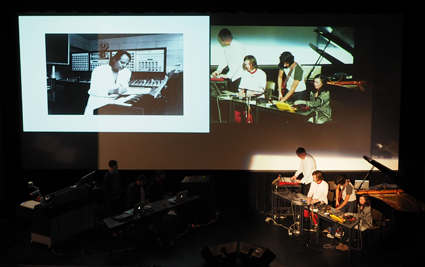
Karlheinz Stockhausen—Electronic Music
photo Sebastian Tomczak
Karlheinz Stockhausen—Electronic Music
The work of legendary composer Karlheinz Stockhausen (1928-2007) is an essential introduction for any student to the field of electronic music that he did so much to establish, and though Stockhausen himself appeared in Adelaide in 1970, his work is rarely heard here.
This concert by 47 Bachelor of Music (Sonic Arts) students of the University of Adelaide was most welcome, focusing on works written by Stockhausen in the period 6-13 May 1968, when his disintegrating marriage caused emotional turmoil. That week coincided with the rioting and general strikes in Paris and elsewhere in Europe that proved a turning point in European politics, and images of these events were shown throughout the concert. Stockhausen’s consoling immersion during that week in the philosophy of Indian mystic Sri Aurobindo precipitated a major shift in his musical direction.
The 14 compositions comprising Aus den sieben Tagen (From the Seven Days) established Stockhausen’s concept of intuitive music, each piece taking the form of a short instructive text, rather than a score, outlining ideas to which the performers are to respond intuitively. For example, the instructions for Verbindung (Connection) are: “Play a vibration in the rhythm of your body/ Play a vibration in the rhythm of your heart/ Play a vibration in the rhythm of your breathing/ Play a vibration in the rhythm of your thinking/ Play a vibration in the rhythm of your intuition/ Play a vibration in the rhythm of enlightenment/ Play a vibration in the rhythm of the universe/ Mix these vibrations freely/ Leave enough silence between them.” For this concert, the selection from the 14 pieces included Unbegrenzt (Unlimited) 1–5, Setz die Segel zur Sonne (Set Sail for the Sun) 1 and 2, Treffpunkt (Meeting Point), Verbindung (Connection) and Ankunft (Arrival). The instructions for them suggest the meditative, internally focused process required of the performer to channel the cosmic awareness in which Stockhausen was interested.
The students work in groups of four or five with an array of synthesisers, the ubiquitous laptops, a tape-loop, the occasional electric guitar and even voice—the instrumentation is not prescribed and they could have chosen acoustic instruments. Such a script is almost a blank canvas for the performer, and can be seen both as a form of spiritual liberation and the ritual abandonment of conventional composition. The ensemble members presumably work independently of each other to respond to their own inner landscape, but as they also respond to each other’s motives, group consciousness and direction seem to emerge, resulting in an absorbing and musical blend of sounds. That the performers can make such interesting music with so little direction indicates the depth of their creativity and their technical, improvisational and ensemble skills.
Iran Sanadzadeh’s contribution was particularly notable as the image on her laptop screen was projected adjacent to the archival film of the 1968 Paris riots. The audience could see her typing text in both English and Arabic during her ensemble’s rendition of Unbegrenzt, highlighting the concept of textual meaning and its translation sonically, visually and culturally. Also briefly screened during the evening were critiques of Stockhausen, such as those by radical composers Henry Flynt and Cornelius Cardew, who complained that he served the establishment. Stockhausen was indeed a controversial figure, and this concert locates him in the revolutionary cultural milieu of his earlier years.
Karlheinz Stockhausen—Electronic Music, University of Adelaide students directed by Stephen Whittington; Scott Theatre, University of Adelaide, 12 June
RealTime issue #122 Aug-Sept 2014 pg. 50
© Chris Reid; for permission to reproduce apply to realtime@realtimearts.net
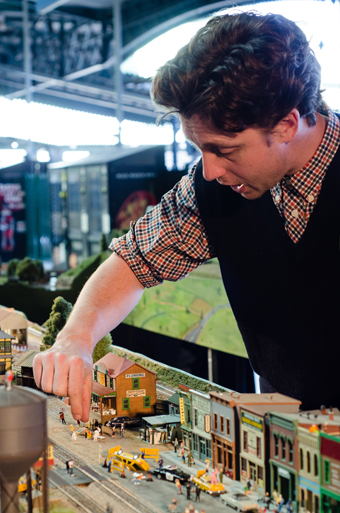
Sam Routledge, I Think I Can
photo Lucy Parakhina
Sam Routledge, I Think I Can
Under the artistic direction of Sam Routledge, Terrapin Puppet Theatre has continued its focus on puppetry that embraces new technology. The Tasmanian-based company’s new production Big Baby, devised by Routledge and playwright Van Badham, is predominantly a non-verbal work, brought to life by puppeteer/performers Bryony Geeves, Maeve Mhairi MacGregor, Kane Peterson, animation and video (see the review).
I spoke with Routledge, who has had an extensive career in puppetry, including as a member of performance group My Darling Patricia and in related works such as I Think I Can, the miniature model train interactive installation featured at recent Australian arts festivals (RT120, p15 & 35).
Whose idea was Big Baby?
I worked with Van on Hard Rubbish (2013) at the Malthouse, which was a Men of Steel show and she was the dramaturg on it. I found she had a great sensibility for puppetry and working non-verbally. I went to her with the idea, saying, “Let’s do a show about a big baby,” and we developed everything together from there. Apart from the spoken text, of course, which was entirely Van. [The production features three poetic monologues]
I’ve always made work that tells stories non-verbally. I feel like puppetry does that really well. For this process Van and I talked over email and then we had a week workshop, just the two of us. Once you know what the story’s going to be and therefore what the puppet needs to do, then [you] have the puppet built. Then everything comes from what that puppet can do.
How was the puppet made?
We commissioned Katrina Gaskell, who’s a very experienced Melbourne puppet-maker. We had it made with a moving mouth, but the way the production developed it didn’t end up speaking. You plan for everything and then some things don’t eventuate, but at least you have the option. When we remount the production maybe the puppet will vocalise.
The show has physical performance elements, such as a clowning influence. Is that something you like to incorporate?
I want to work with performers who are comfortable working physically. The puppet will always move in a heightened way so the performers are also moving in a stylised or heightened way; then we’re going to see them as part of the same world. Part of the puppet being made to live comes from the performers imbuing it with life, looking at it in a way that it’s alive, and often clowns and physical performers have the ability to do that.
It seems to be a trend that the puppeteer is becoming more and more visible in contemporary puppetry?
Ideally, it’s great if the puppeteer has a role in the narrative, apart from just bringing the puppets to life. I see no purpose in entirely hiding the puppeteers because they’re definitely there. Actually not hiding the puppeteers can make the audience experience more authentic. They see that there’s no trickery at work—this puppet is being brought to life in front of their eyes and someone is doing it.
The element of trickery is perhaps to be found in the animation and filmic elements of the show. Do you often use video or is Big Baby a departure for you?
Terrapin’s really focused on puppetry and new technologies, so in Big Baby we use a live feed from an HDMI video microscope. And we also use Leap Motion, which is a digital puppetry device. It’s like a motion-sensing device in the way Kinect is for the Xbox, but just using your hands. So the baby that you see in the show on screen is being manipulated live by Bryony. The microscope made a lot of sense because [the story is] about things that are usually very small being big and seeing the beauty in things that are small, and tiny especially. Also, I’m continually interested in the miniature. In the theatre if you can [show the] miniature it opens our understanding of things that we might normally gloss over or forget.
How do you work out what kind of show is suitable to pitch to different audiences?
An audience of children is different from an audience of children and adults [as in the case of Big Baby, which is designed to be seen in theatres rather than schools]. [The poet] Ted Hughes—because he did some work for children and some work for adults—talks about when adults go to the theatre they seek an anaesthetic. They want something that’s entertaining that will not unsettle them…That barrier does not go up when they go to see children’s theatre. They say, “This work is not for me. This work is for children.” Therefore you can speak to adults through theatre for children.
I do always, when I’m making work for children, have the adults in mind, and I have no problem if an adult has to explain something to a child in the theatre. The child and the adult together in the theatre [make for] a really interesting dynamic. I hope it opens up a conversation about what [the story] means and why it happened.
There’s an interesting problem in puppet theatre of whether to have work for children that’s too complex or work for adults that’s too simple.
I’m interested in [Terrapin productions] being sophisticated, original work for children that is ambitious in what it does with form. Puppetry at its heart, I think, is a very humanist art form. It preferences what we are capable of over what machines are capable of, actually. When a child sees a puppet brought to life, hopefully it says that humans are capable of the impossible. The ability for someone to create wonder with just their hands, bringing something to life, is greater than or equal to the ability of someone to do that with technology. And for me it’s not through ignoring technology that I can make that statement, it’s putting technology and puppetry together in the same production.
My practice has always been in puppetry, so I’ve always been a puppeteer. After I graduated from university I worked with Kim Carpenter’s Theatre of Image and was an assistant stage manager so I could do some very small moments of puppetry. And I went to Korea and worked with a children’s theatre company there for six months, as a puppeteer. I’m very committed to actual puppetry being front and centre in the work that the company creates.
Terrapin Puppet Theatre, Hobart, www.terrapin.org.au
RealTime issue #122 Aug-Sept 2014 pg. 40
© Briony Kidd; for permission to reproduce apply to realtime@realtimearts.net
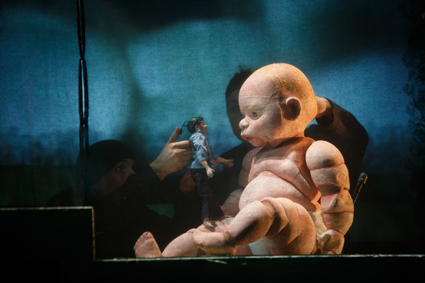
Big Baby, Terrapin
photo Peter Matthew
Big Baby, Terrapin
A man and woman meet and fall in love. She’s a messy and impulsive scientist and he’s a kindly neat freak who’s prepared for any eventuality.
Encountering each other at a bus stop, he takes out a scarf to get warm and has a spare one for her to borrow. They go to the movies, she spills popcorn and later has a look at it under the microscope, revealing the landscape of tiny things to which her life is devoted. The pair share this moment and, in no time at all, they’re expecting a Big Baby (well, they’re expecting a normal size one probably, but life has other ideas).
This unusually long prelude at 10 minutes was inspired, says director Sam Routledge, by the pre-story in the Pixar animated film Up (2009). For me, there’s also a touch of French New Wave cinema. It works for two reasons. First, the two performers, Bryony Geeves and Kane Peterson, are charismatic presences on stage and have no trouble making us believe they are in love, even without the words for realistic character development. Second, they use their physicality in a comedic, expressive way preparing us for the puppetry that’s to follow.
Sadly, while Dad is outside the delivery room, a massive clock marking every dreadful second, Mum is in trouble. A doctor comes out to disclose that she didn’t make it through the delivery. It’s a disturbing beginning to a show for children, but of course there’s precedent. Fairytales often start with the loss of one or both parents. Suffice it to say there was no audible crying at the opening night performance I attended, so I’m going to assume the balance between melodrama and tragedy was correctly struck.
The baby appears as a sophisticated puppet designed by Katrina Gaskell. Unusually large, demanding and full of curiosity and energy, it’s never referred to as either ‘boy’ or ‘girl,’ which makes him/her difficult to talk about in a review, but it’s an interesting conceit. As an adult audience member, I’d like to see that notion explored a little. Yet child audiences easily accept that babies are not gender-specific; perhaps that says it all.
So Dad is left with a baby to look after and life to get on with, and the story proper begins, with the performer who played Mum returning to animate Big Baby, thereby giving a sense of ongoing connection. Of course, ghostly puppeteer/mother presence aside, it’s not easy for the father and child. The relationship is clearly a loving one—they have little rituals like rubbing noses—but they’re temperamentally so different that the Big Baby might as well be an alien. When Big Baby begins to feel threatened by a new presence, an ‘evil’ vacuum cleaner that Dad brings into the home, s/he runs away into nature. There s/he somehow grows even bigger, and returns to the city now a Giant Baby. It doesn’t really matter why the baby grows (it seemingly has to do with Mum’s spiritual influence), it’s a fun idea.
This show is performed by Geeves, Peterson and Maeve Mhairi MacGregor, who takes on the broadly comedic role of a childcare worker who is traumatised by looking after Big Baby. At the heart of the piece is the expressive, lovable Baby character, but additional elements of animation and digital puppetry provide textural layers and atmosphere.
Aside from a couple of poetic monologues, the show is non-verbal. As such, music and sound design is especially crucial. Composer Heath Brown adeptly takes us from whimsy to melancholy and back again and shifts into pop culture mode as required, as in the climactic showdown scene between Big Baby and arch-nemesis, the vacuum cleaner. It’s a Godzilla-scale battle, complete with slo-mo ‘bullet time’ moments and the inventive use of miniatures. It’s an absolute crowd-pleaser.
Terrapin Puppet Theatre, Big Baby, director Sam Routledge, writer Van Badham, designer Jill Munro, composer Heath Brown, lighting, audio-visual design Jason James, digital puppet designer Matt Daniels, video Sam Routledge, Matt Daniels; Theatre Royal, Hobart, 4-6 July
See also our interview with Terrapin’s Sam Routledge
RealTime issue #122 Aug-Sept 2014 pg. 40, 42
© Briony Kidd; for permission to reproduce apply to realtime@realtimearts.net
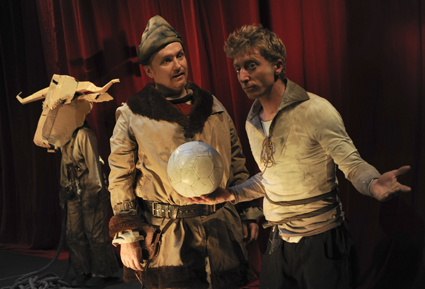
Drew Fairley, Skye Gellmann, Jack and the Beanstalk
photo Heidrun Löhr
Drew Fairley, Skye Gellmann, Jack and the Beanstalk
A new aesthetics of childhood is emerging with some of the key contemporary performance companies of the last decade. Mammalian Diving Reflex’s ground-breaking Haircuts by Children contemplated the agency of children and the vanity of adults by reversing the conventional power dynamics of the hair salon. Italy’s Compania TPO’s multimedia works enfold children in the interactive, reactive environments of collective story-building, and stalwarts of the postmodern stage Forced Entertainment have just announced their first work for children: The Impossible Possible House.
In Australia, My Darling Patricia recently applied their signature cross-artform aesthetics to the visually immersive The Piper for the 2014 Sydney Festival. And alongside designated festivals for children (Come Out and Out of the Box) and spaces for child creativity (Melbourne’s ArtPlay), there is a genre of works for babies emerging with dance artist Sally Chance’s This Baby Life and Nursery.
These creative frames inevitably contemplate the cultural figuring of the child as a symbol of purity, morality and nascent humanity in the contemporary media landscape. They also recognise and become entangled with the truism that seems to come with societies of affluence: child audiences are a fickle and yet lucrative market. In a broader socio-political context which has witnessed seismic reconsiderations of the legal and moral agency of the child, as in Belgium’s recent legalisation of euthanasia for terminally ill children, the question of how these varying theatre practices interpret the imaginative and perceptual faculties of children is perhaps at the heart of this vibrant artistic milieu.
Jack and the Beanstalk, the final iteration of a three-part collaboration between Chiara Guidi of Socìetas Raffaello Sanzio and Sydney-based performance makerJeff Stein in partnership with Campbelltown Arts Centre is, if not a frontrunner, then an originator of this scene. Guidi’s Experimental Theatre for Children based in Italy has been operating since the 1990s and in 2010 she ran The Art of Play, a cultural exchange at Campbelltown, during which she spoke at length about her vision for the sympatico aesthetic between the worlds of childhood and theatre: both are equally invested in the reality-effects of make believe [RT100]. In 2012, Guidi returned to develop Jack [RT108] and in 2014, she came back to complete it.
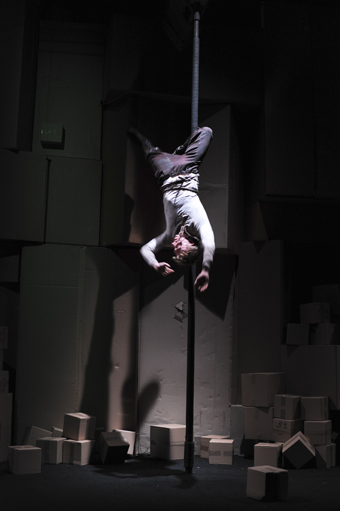
Skye Gellmann, Jack and the Beanstalk
photo Heidrun Löhr
Skye Gellmann, Jack and the Beanstalk
Jack and the Beanstalk begins with a foreboding stillness. Jack and his mother appear to lie dead under a box while a strangely masked figure draws an ominous circle around them. The sonic environment is already sparse and stretching, the lighting dim, the mood dark and hesitant. From the outset this image is not easily readable: the familiar lightness of contemporary fairy tales is undone with an image that hangs like an uneasy promise over the whole work: do they die in this version? Then Jack moves, and the process of barter between beans and cow begins.
We understand that Jack is poor, his mother bids him to sell the cow and in an athletic exchange between Jack, his mother and the bean seller, Jack’s wrestle between conscience and desire is made tangible. His mother, of course, is furious and berates him for ‘dreaming.’ The audience, holding handfuls of beans, are encouraged to throw the beans “against Jack’s dream:” there is no supper for Jack tonight. This interactivity with the audience introduces a dynamic that is expertly built across the work, conducted by the deviously masked Katia Molino as the ogre’s ‘handler,’ who is neither friend to Jack nor the audience, betraying both at every turn.
Guidi spoke in a recent RealTime video interview of her interest in the fable for its spatial metaphors: the beanstalk draws a line between heaven and earth, dream and reality and the beans are much like theatre itself: a box from which magic unfolds. She also referred to Jack’s negotiations with the giant as a series of initiations into adulthood. Perhaps the fable can be read as a coming of age narrative in which we all learn an ambiguous moral lesson. Jack is a kind of illegitimate protagonist, he steals from someone without cause, and as an audience we are left to wrestle with our own responses to his acts of dreaming and desire.
If our consciences are pricked on behalf of Jack’s actions, then so are our senses. Building on her earlier experiments with chorality and space [RT90], Guidi also referenced her use of sound as a visual and structural device. Live musicians in the work (Trevor Brown, Veren Grigorov) play Max Lyandvert’s sparse, staccato and at times thunderous composition, but Guidi here also refers to the musicality of her pared back dramaturgy: tight physical sets and truncated dialogues apparently aim to access the ‘core’ of the fable, leaving nothing to waste.
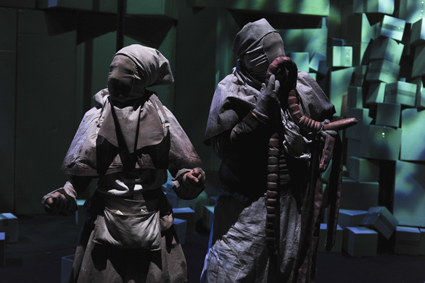
Jack and the Beanstalk
photo Heidrun Löhr
Jack and the Beanstalk
The world Jack dreams is an incredible cardboard structure (created by Sydney’s Erth) that stretches to the skies as a series of hidden doors and windows. Objects exit and enter from these sinister little peepholes. At various stages spectators become bold enough to visit the giant who lives above; in their absence, the cardboard machine spits out remnants of story—a box with letters, a human skull and bones. Strange slinky worm creatures flop and poke about the stage. The children barter with the handler, collecting the giant’s discarded debris, becoming willing victims to his voracious appetite. While the golden goose majestically appears as an image of sensitive wonder amid the darkness, it is not long before the ogre himself manifests as a chilling apparition shrieking the kind of blackness you just might find in nightmares.
How to justify the death of children, the greed of children, their bravery, sensitivity, complicity and fearlessness? The work is macabre, it feels, in the historical tradition and conditions in which fairytales themselves once needed to be imagined. Perhaps it carries that historical necessity cuttingly into the present. Throughout, we are required to contemplate the prospect of a world in which the child is not always a winner, or even right. The children in the room, for one, seem unnervingly content with this bleak but complex image of themselves.
Campbelltown Arts Centre, Jack and the Beanstalk, director, writer Chiara Guidi, facilitator, producer Jeff Stein, performers Skye Gellmann, Katia Molino, Drew Fairley, Christa Hughes, Nadia Cusimano, musicians Trevor Brown, Veren Grigorov, sound design Max Lyandvert, set design Erth Visual and Physical (Scott Wright, Steve Howarth), Lighting Clytie Smith, Mark Haslam; Campbelltown Arts Centre, NSW, 30 May-7 June
RealTime issue #122 Aug-Sept 2014 pg. 42
© Bryoni Trezise; for permission to reproduce apply to realtime@realtimearts.net
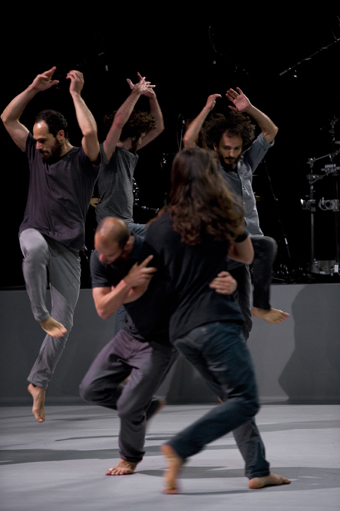
D’Après Une Histoire Vraie, Christian Rizzo
photo Marc Domage
D’Après Une Histoire Vraie, Christian Rizzo
Works in this year’s Festival TransAmériques in Montreal appeared bound by the desire of each creator to express a strong thesis. In the dance program, three works in particular chose to tackle very clear concepts, from the validity of revering an artistic canon to the meaning of masculinity in today’s world. The following works shared an intense, almost relentless physicality and a total commitment to their conceptual investigation.
Christian Rizzo, D’Après Une Histoire Vraie
D’Après Une Histoire Vraie (Based on a True Story) takes its inspiration from a visit to Turkey 10 years ago, during which Rizzo witnessed Turkish folk dance. As such, the movement vocabulary for the work is drawn extensively from Rizzo’s research into traditional dances of the Middle East, the Magreb, France and Spain. He is incredibly adept at deconstructing the choreographic structures of these dances and rearranging them without diluting their original intent. The performers weave in and out of continually changing duets and trios to the rhythms of two drummers playing contemporary drum kits, revisiting not only the motifs of the dances they appropriate but also rock ’n’ roll tropes as they headbang, long hair and beards flying, to the driving beats.
With eight male dancers, the work is inherently an investigation into contemporary Western masculinity through juxtaposition of the handholding and physical closeness of folk dance, cultural stereotypes and stigmas around those, and the injection of hyper-masculine rock. Rizzo is a master of structure, pattern and timing, and at just over an hour the work is easy to watch, but it’s conceptually thin and needed to ask far more questions of itself.
Catherine Gaudet, Au Sein Des Plus Raides Vertus
Fast becoming one of the darlings of the Montreal dance scene, Catherine Gaudet makes work with an edginess that seems to be a hallmark of Québecois art. Au Sein Des Plus Raides Vertus (Within Steeper Virtues) is not necessarily an exploitative work, but there is enough of a fascination with exploitative relationships to induce deep discomfort. The performers, two male and two female appear topless, and the combination of close physical contact with an almost continuous disregard for one another in favour of staring at the audience (not to mention the gradually increasing layer of sweat on bare torsos) leads to a sense of sinister sexualisation of the performers’ interactions.
Religious iconography is alluded to constantly, particularly in the opening moments when the performers advance slowly in a group, singing in Latin and working with micro-gestures reminiscent of Renaissance religious paintings. A sense of demented rapture dominates the work as a male performer gently strokes the other male’s hair while the women violently slap one another’s naked arms and torsos, all gazing disconcertingly at the audience, or when three performers crawl forward, yelling and smiling, illuminated by yellow light from below.
The constant integration of conflicting aesthetics is what makes the work so brutal. Beautiful bodies gyrate while making zombie-like inhalations and rolling their eyes. A man sits down abruptly to resentfully plait a woman’s hair. Power dynamics shift constantly, with both genders abusing one another and themselves to achieve some sort of power- or pleasure-based goal, though it was difficult to discern which. At one point the women force the faces of the two men together until they kiss, then wrench them apart when they become overly amorous. This sex/violence dichotomy was key to the work, but prevented engagement with the subtleties of the choreography.
While more than merely an attempt to shock, Au Sein Des Plus Raides Vertus limited its scope by undertaking only a simplistic investigation of poisonous relationships and Christian morality.
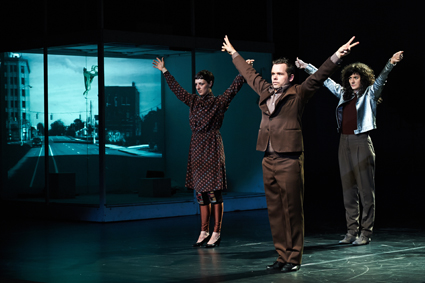
Built to Last, Meg Stuart
photo Eva Wurdinger
Built to Last, Meg Stuart
Meg Stuart, Built to Last
Built to Last marks a formal departure from much of Stuart’s previous work. A witty investigation of cultural institutionalism, the work’s strength is in the hilarity it derives from portraying human fallibility and its questioning of Western cultural history through mashing up contemporary performance with music from Beethoven, Stockhausen and Rachmaninoff.
A giant assembly-kit tyrannosaurus skeleton, an isolated white room and a massive planetary mobile dominate the space. Over the first half hour the music builds to a level of intensity that the choreography tries vainly to match, instead achieving sublime bedlam. The performers jump across the space or repeatedly onto their knees, run, fall and tear apart the dinosaur. Finally one performer gets the attention of the sound operator and calls a halt, explaining somewhat sheepishly, “We are motivated by enthusiasm and love,” earning him a few chuckles.
Sheepishness is a recurring state as these mere humans continually fall short of the power of the musical masterpieces, even as the work critiques the concept of a Western artistic canon. When three performers enter the room-turned-vitrine dressed in bizarre tribal-futuristic costume we become amused viewers as these ‘exhibits’ struggle to find the best positions in which to manufacture some sense of historic gravitas. Later the room becomes a platform for one of the performers to play God, standing powerfully on top of it as she journeys through the planets, still ducking as they swing around her head. When the largest planet bursts open, showering the space with small foam balls, we see humans become the willful masters of the universe—the performers hold up the balls and drop them, then return to their fragile selves as they too fall to the ground.
The choreography also investigates cultural ‘greatness’ within its own form, revisiting an Yvonne Rainer solo and creating an ironic Isadora Duncan-esque duet that is almost impossible to see through an ingenious excess of stage fog ‘accidentally’ released by one performer. At other times the choreography uses the relationship between music and sharp gestures to inexplicably create humour. It’s an incredibly varied work, expertly performed and continually questioning.
Though the degree to which these works achieved their conceptual goals varied dramatically, all three demonstrated a level of artistic rigour. Regardless of whether or not they hit their marks, all raised important questions, reflecting a strong year of programming at Festival TransAmériques.
FTA, Festival TransAmériques, Montreal, Canada, 22 May-7June
RealTime issue #122 Aug-Sept 2014 pg. 43
© Emi Foster; for permission to reproduce apply to realtime@realtimearts.net
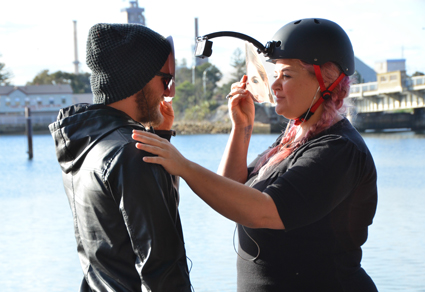
Black Market, pvi collective
photo Heath Britton
Black Market, pvi collective
A sense of the breakdown of natural and human-made systems was all-pervading at this year’s Adhocracy, Vitalstatistix’ curated hothouse of new art and performance. It seemed fitting that, as the program enters its fifth year and the company its 30th, this year’s talks, showings and open studios looked both backwards and forwards, each grappling in some way with how the recent past has challenged our species’ capacity to survive and thrive in the years ahead.
Looking backwards: 1984
UK artist and researcher Sophie Hope’s 1984 is an ongoing, global project which uses the dinner party as a format for exploring intersections between art and politics in the year 1984. Aside from George Orwell’s novel, the year seems arbitrary to Australians—Hope was thinking of Margaret Thatcher’s galvanising effect on London’s overtly political artists when she chose it—but the dinner which took place at Adhocracy, curated by Steve Mayhew, nevertheless saw a lively and provocative exchange of ideas between arts workers and a former politician—Ollie Black, Rob Brookman, Eileen Darley, Annie Newmarch and Anne Levy. This iteration marked the first time Hope has permitted one of her dinners to be held in the presence of an audience, a decision that turned out to be providential; an oversight led to the dinner not, as is usual, being audio recorded for Hope’s ultimate use in a radio piece, an installation and a publication. The conversation, which ranged freely and, owing to the frequent replenishment of wine glasses, sometimes intemperately, around issues such as Marxism, the Cold War and gender equality, will live on as memory only, as recollections of recollections.
Heat
In Hissy Fit’s Heat, the notion of the deviant, transgressive woman was investigated through pop culture representations of women in conflict with each other in female prison dramas and B-movies. Into this mix, devisers/performers Emily O’Connor and Natalie Randall also throw the choreography of Greco-Roman wrestling, their three showings combining discussion, video and their own ad hoc demonstrations of the ancient combat sport’s drags, hugs and headlocks. The marriage is a curious one—at this early stage bringing together problematisation of female gender norms with the strongly homoerotic physicality of Greco-Roman wrestling doesn’t suggest an aesthetically or conceptually cohesive whole. The work clearly has a long way to go.
Looking forwards: Black Market
In pvi collective’s Black Market, a worldwide economic collapse has precipitated the rise of a thriving underground trade in bartered goods and services. The participatory, still-developing work cast its audience members as hustlers in this brave new world, mobile phones thrust into our hands to facilitate the exchange of our own goods—pens and pencils, bus tickets, lipstick, Panadol, as well as jokes, hugs and other acts of human solidarity—for unknown but enticing rewards assigned categories including ‘medicine,’ ‘porn,’ ‘courage’ and ‘weaponry.’ Our prices set and earphones installed, we drifted out onto the Port Adelaide waterfront, pvi’s prototype app instructing us on how and where to complete our deals. A bold and playful intervention into the d siscourse around the failure of market economics, Black Market nevertheless posed a nagging question: is iPhone technology, contingent on our current social, economic and technological structures, the most appropriate platform for a work concerned with showing us the effects of the collapse of precisely these structures?
Somatic Drifts
Grounded in horticulture and neuroscience, Cat Jones’ full body experience for one person at a time was an undoubted highlight of this year’s program. Gesturing towards the emergent ontologies of a post-human future, Somatic Drifts sought, through sensory and aural immersion, to radically unsettle the sense of self of participants, who had both human and plant identities progressively imposed over their own through sound, aroma, touch and visual feedback. My initial trepidation was quickly forgotten, the work proving unexpectedly affecting in its therapeutic, closely guided dislocations of sense and self as well as its emotive engagement with ideas around the fostering of empathy between species. Still in its first stage of research and development, the progress of Somatic Drifts will be keenly monitored by this writer.
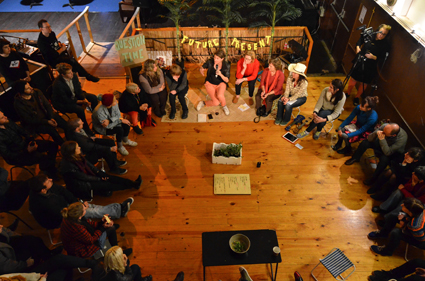
Future Present
photo Heath Britton
Future Present
Future Present
For many, the weekend culminated in the final session, Future Present: artists, primary industry & climate change, a commissioned, interdisciplinary project led by Rosie Dennis of Urban Theatre Projects. A diverse panel of non-artists (including Federal Member for Port Adelaide, Mark Butler) assembled on Adhocracy’s last, chilly night to share their hopes and fears around an irrevocably climate-changed future. For the previous two weeks, ten local artists had been engaged in a residency that saw them undertake field trips to meet South Australian food producers who, having lived all their lives with the direct impacts of prolonged natural drought, are now on the frontlines of battling anthropogenic climate change. Monday night’s conversation was predictably saturnine, the mood offset only by the panel members’ ironic wearing of colourful leis. It felt good to talk, to find ourselves if not hopeful then at least happy while in the fraternal presence of artists and non-artists alike who grasp that the way forwards may necessarily entail the way back, back from the brink, back to the people and the earth.
Vitalstatistix, Adhocracy, curators Paul Gazzola, Jason Sweeney, Lara Torr, Emma Webb, Waterside Workers Hall, Port Adelaide, 7-9 June
RealTime issue #122 Aug-Sept 2014 pg. 44
© Ben Brooker; for permission to reproduce apply to realtime@realtimearts.net
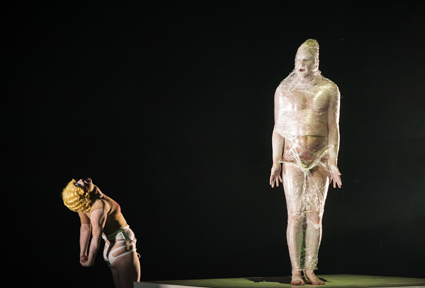
Nerida Matthaei, Stephen Quinn, Caligula, The Danger Ensemble
photo Dylan Evans
Nerida Matthaei, Stephen Quinn, Caligula, The Danger Ensemble
Although widely divergent in form and intention, both The Danger Ensemble’s new show Caligula and Linda Hassall’s verbatim piece about Australian war veterans, The Return, grapple with the brutal impacts of the end of empire: cultural spasm and futile wars.
Brisbane wunderkind Steven Mitchell-Wright opened Caligula with a thrumming soundscape, blinding lights that shimmered and warped and a back wall of performers wearing white paint. Not solemn Butoh bodies, but carnie cut-outs, with the heads and limbs of the performers poking out of plaster-cast statues of their naked bodies. The soundscape peaked and the statues lifted, suspended for the duration of the show, while the lights dimmed to reveal a signature Danger Ensemble mod-pop white set, re-worked into a gallery catwalk formation.
A clowning routine that relays a potted biography of Caligula is followed by 20 or so vignettes: monologues, dance sequences, improvised games, pop songs and further routines exploring the narcissistic and decadent excesses of Caligula’s Rome and our own contemporary culture’s obsession with sex and power through fetish, consumerism, pop culture and violence.
The costumes by Wright and fashion designer Natalie Ryner were so fashion forward they had my teeth grinding in envy. There were dozens of costume changes and the mash of Roman and contemporary fetish references held the show’s loose format together, providing the dramaturgical ballast needed to navigate the show’s piecing together of late twentieth century cultural references (Nick Cave, the Smiths, Camus and Charles Manson) and material drawn from Roman history.
The coup de théâtre was certainly the revelation part-way through the show that the perimeter inside the catwalk was full of thousands of transparent plastic cups that squashed and squeaked as the performers waded in and out, danced across and through them and in one of the show’s truly eerie moments provided a rubbish dump for the corpse of a skinned horse.
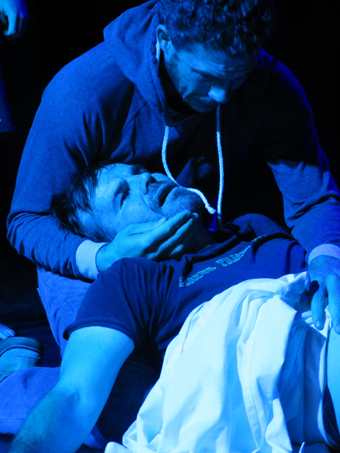
The Return
courtesy the artists
The Return
There were moments of intense theatrical pleasure: Brisbane feminist rock idol Lucinda Shaw as a bare-breasted Jesus with a headdress of bloody syringes singing Nick Cave; Chris Beckey as the sinuous Caligula asking plaintively if he would be remembered; an ecstatic monologue by a pizza delivery boy declaiming the joys of fisting. But when you expect the edge it takes a lot to deliver it and many of the ensemble’s set-pieces by now are familiar: the white set, the canny pop song re-delivered, the lofty balcony commentary with its cryptic mash of existential and canonical texts.
“Certainly not History” was the show’s tagline but the collation of canonical material had none of the dexterity evident in the manipulation of the visual iconography. In the most ironic of twists, this made the show feel like a history lesson—a beautifully designed, postmodern history lesson but one no less bossy in its earnest desire to draw parallels between the cultural and political excesses of Caligula’s Rome and our own polyglot, bloody and narcissist contemporary culture.
Indeed, bloody was the experience of watching The Return (presented by artists and researchers from Griffith University), which like Daniel Keene’s The Long Way Home (RT 119, p31) for the Sydney Theatre Company and Australian Defence Force, was performed by veterans as well as professional actors. The raw power of Hassall’s uncompromising aesthetic gave the work, at its best, a sort of herculean credibility and affect. A returned solider tells the story of a bomb attack where his best friend was killed and he carried his sergeant’s brains on his body across the long, despairing day as they sought medical aid. A mother tells us she considers her son’s suicide a combat injury, the wound just took longer to kill.
The show draws power from its long development process with the veterans, independent from the ADF—included are didactic sequences about the compromised role of the ADF in veteran support. However, The Return suffers from its outrage, with long, relentless sequences where the set is endlessly built and rebuilt and much of the non-verbatim material feels dogged and one-dimensional.
Indeed, since the Vietnam War Australians have tried to separate personal politics from the structural violence endured by soldiers. But somehow a piece about the impact of war without an analysis of why we went to war is too easy. Dangerous works point the finger back at us for our role in putting the men and women who patrol the walls of our imaginary empires in harm’s way.
Judith Wright Centre: The Danger Ensemble, Caligula, director, designer Steven Mitchell Wright, designers: Benjamin Hughes and Natalie Ryner, JWC Performance Space, 3-12 July; The Return, writer, director Linda Hassall, design Fiona McKeon, producer Michael Balfour, Professor, Applied Theatre, Griffith University; BEMAC Theatre, Queensland Multicultural Centre, Brisbane, 25, 26 June
RealTime issue #122 Aug-Sept 2014 pg. 44
© Kathryn Kelly; for permission to reproduce apply to realtime@realtimearts.net
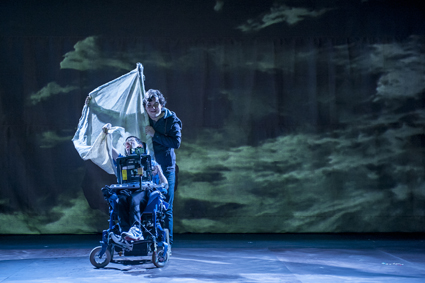
Anton Sagrillo, Brenton Shaw, Eye Music, Tutti
photo Sam Oster
Anton Sagrillo, Brenton Shaw, Eye Music, Tutti
“I died when I was nine months old.” The words, spoken by a synthesised voice, come out of the near darkness in which a lone man sits in an electric wheelchair.
The choppy, Americanised intonation is eerie in the gloom. On large screens behind the sentence slowly appears in Bliss symbols from the ideographic writing system. The man in the wheelchair is Jem (Anton Sagrillo) and his profoundly disabling cerebral palsy has already killed him once.
His second life, it would seem, could be worse. He has a best friend, the able-bodied Possum (Brenton John Shaw), a girlfriend, Wendy (Kathryn Hall), and two unstinting carers: grandmother Sylvia (Jacqy Phillips) and mother Jackie (Tamara Lee). But Jem wants to go to university, and his chances of living long enough to realise this dream are a fraction of what they are for the general population. It seems more than probable that, buried deeply beneath his defiant joie de vivre, Jem holds as pragmatic a view of his own impermanence as anyone.
In development for six years, Eye Music grew out of a series of conversations between playwright Pat Rix and Jem’s real life analogue, Jeremy Hartgen, which took place in the last year of Hartgen’s life. Under Edwin Kemp Attrill’s quietly ambitious direction, Hartgen’s biography is transfigured into a dynamic soap opera that freely interweaves the conventions of text-based and musical theatre. Wi-Fi technology is used to connect Sagrillo’s Bliss board (the performer too has cerebral palsy) with Nic Mollison’s dexterous AV design that integrates text, Bliss symbols, video and animation.
Along with composer and musical director Alies Sluiter’s songs—most of which are given to tenor Alistair Brasted to sing as Jem’s ‘inner voice’—all of this delivers a boldly successful account of the sound of the life of Jem’s mind. The name Eye Music hints at the difficulties inherent in bridging the communication gap between people of differing abilities, but the deployment of both aural and visual storytelling technologies, as well as enhanced disability access in the form of Auslan interpretation and audio description, effectively democratises Jem’s experience of physical impairment. The cruel dissonance between his restrictive, high maintenance biology and his unencumbered mind is most touchingly shown through a fantasy he shares with Possum about building a raft and sailing away, sans wheelchair.
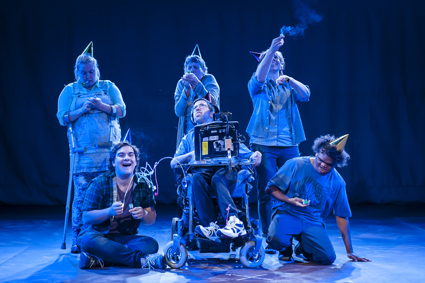
Eye Music, Tutti
photo Sam Oster
Eye Music, Tutti
For all its enjoyable whimsy, Rix’s script does not fail to interrogate the profoundly contentious relationships between disability, faith, sex and assisted suicide. Jem is seen to independently navigate all of these, in the process delightfully upending the stubborn taboo that applies to sexual intercourse between disabled bodies. Within the context of the play, though, Jem’s loss of faith is the altogether more shocking transgression. The devout Sylvia rages like an uncomprehending child as Jem’s cognisance of his own mortality—and that of his friends as they are one after another consumed by physical and existential torment—turns him towards godlessness.
In the final scene, Jem’s own suffering has become too much for him to bear. A hydraulic winch lifts his lifeless body out of its earthly prison and into a vast, white armchair around which has been built the raft of his dreams. It is a transcendent, immaculately choreographed moment, reminiscent of the death of David Lynch’s John Merrick as he embraces the incorporeal as liberation. The sense of consolation that follows does not lie in the fact that we know him to be ‘going to a better place’ but rather that knowledge of its non-existence will no longer trouble him.
Tutti Arts, Eye Music, writer Pat Rix, director Edwin Kemp Attrill performers Anton Sagrillo, Jacqy Phillips, Tamara Lee, Roy Stewart, Brenton Shaw, Kathryn Hall, Alistair Brasted, Elliot Galvin, composer, musical director Alies Sluiter, lighting, projection Nic Mollison, designer Manda Webber, State Opera Studio, Adelaide, 22-31 May
RealTime issue #122 Aug-Sept 2014 pg. 44
© Ben Brooker; for permission to reproduce apply to realtime@realtimearts.net
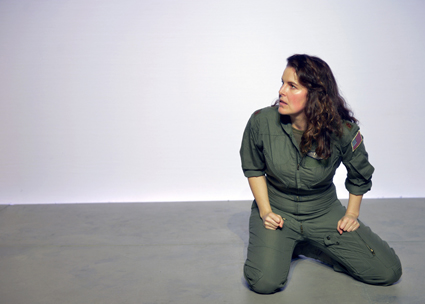
Kate Cole, Red Stitch Actors Theatre, Grounded
photo Jodie Hutchinson
Kate Cole, Red Stitch Actors Theatre, Grounded
The monologue is one of theatre’s base elements. With just a little fussing around in the chemistry set, the simplest solo performance can still create sparks, fire, the smell of crackling air. Or it can squat there before you like a lump of lead for an hour or more. Can anything really new be done with the monologue as a mode? Three recent Melbourne works hinted at the possibility.
Grounded
George Brant’s Grounded doesn’t immediately announce itself as terribly exceptional, but a production by Red Stitch Actors Theatre proved one of the company’s most memorable outings to date. The work’s materiality is minimal—the already small playing space is bare of props and the design is merely a subtle rendering to the walls suggestive of the interior of a military vehicle. The entire 80-minute work is performed by a single actor (Kate Cole) who does not leave the stage, and barely moves around it. Yet this is a work whose astonishing strengths come from precisely its manipulation of the immaterial components of live performance.
The subject matter itself is arresting enough. An American F16 fighter pilot stationed in the Middle East falls pregnant while on furlough back in the US and finds herself reassigned to the cold world of drone warfare. Brant’s treatment of this premise is outstanding, too. Striking images pile up from the outset: morning sickness while piloting an F16; the reasons pregnant women are barred from flying (think ejector seats); the contrast between the endless blue sky of the pilot and the tiny windowless unit of the desk-bound drone jockey.
So far, so conventional. But it is through the dynamic relationship between Cole’s mighty performance and Matthew Adey’s equally rich lighting design that the work truly soars. Cole delivers a character grounded in more ways than one. This is an earthy creature, despite her profession. Her swaggering braggadocio and coiled-spring energy are well beyond the Top Gun clichés that could have reduced the work to pastiche, and the giddy acceleration of the work’s early moments brings to mind that other great monologue that overflows with life, that of Molly Bloom’s “yes I said yes I will Yes” at the end of Ulysses. That the audience can be dragged into the slipstream of a character who also defines herself by the slaughter of war is testament both to Cole’s bravery and Kirsten von Bibra’s precise direction.
While voice, gesture and rhythm work to produce a fertile sense of presence here, of life in fullness, Adey’s lighting offers an equally charged atmosphere of transcendence and the vacuum that is both ethereal and deathly. The pilot’s job is one of heavenly surveillance and this notion of bodiless witness from upon high—and deadly judgement thereafter—is a theme throughout the work. Adey’s almost imperceptible modulation of light often makes terrific use of after-images, giving Cole a faint halo as your eyes move slightly, or causing her skin to take on unearthly hues. The avenging angel at this work’s centre is literally brought before us, and that after-image in particular lasts well after the lights are finally out.
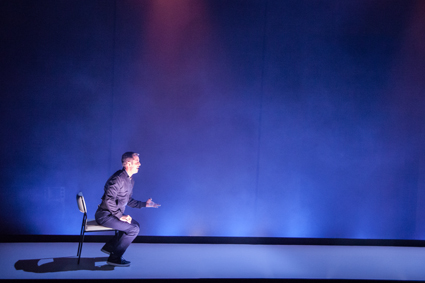
Angus Cerini, Resplendence
photo Sebastian Bourges
Angus Cerini, Resplendence
Resplendence
Angus Cerini’s Resplendence is another work that takes place in a void but is far from empty. Here an unnamed man in a black bomber jacket fixates on a source of sharp light to one side of the stage—a television set most likely—and spends a Butoh-ish amount of time working his way across the space towards it. So quotidian is his situation that it might as well be the fridge light, really, but as usual Cerini’s command of language and its unconventional deployment renders the everyday with mythic undertones.
The man is angry at the world, or riven by anxieties about it, and as with many of Cerini’s characters his body-wracking inabilities to quell these responses are a visceral reminder of masculinity’s more threatening aspects. When the man does leave his house to hunt down some takeaway, it’s hard not to muster some deal of dread, at least if you are familiar with a typical Cerini work.
But this is not a typical Cerini work. Midway through its unfolding, its central figure witnesses a tragedy that violently rips him from his solipsism. He is forced to act—or, more importantly, to react to an event that occurs before him rather than in the world he projects from the safety of his own head. It’s a riveting moment, given that Cerini has proven so adept at bringing audiences into those disturbing worlds before. Here he illustrates what prisons they are by allowing us a brief glimpse past the bars at a patch of daylight somewhere down the hall. To describe this as optimistic would be wrong—the man never even dreams of a key to his cell, let alone escapes—but it is a work that signals a hurdle leapt by its maker with verve and grace.
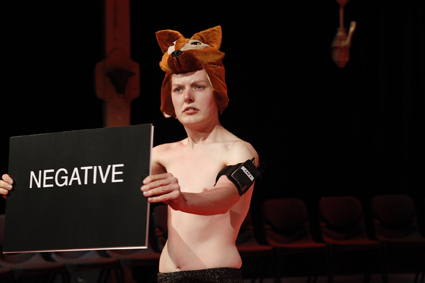
LIVE WITH IT we all have HIV, Phillip Adams BalletLab in collaboration with Andrew Hazewinkel
photo Jeff Busby
LIVE WITH IT we all have HIV, Phillip Adams BalletLab in collaboration with Andrew Hazewinkel
LIVE WITH IT we all have HIV
Phillip Adams’ LIVE WITH IT we all have HIV is an even more radical departure from standard practice for the artist. It is a series of ‘portraits’ by real subjects touched by HIV over the past 30 years, and Adams has almost completely eschewed his role as choreographer in favour of a kind of curatorial position, establishing the conditions within which these non-professional performers present their own stories. He has collaborated with visual artist Andrew Hazewinkel throughout the process, and the results are each a kind of monologue not limiting themselves to the theatrical definition of the mode.
The work itself is hard to categorise. The agents on stage don’t perform, as such, but rather present their stories—as rambling monologues in the more traditional sense, as solo movement pieces, as pre-recorded audio. Most centre on an object that does not symbolise HIV but somehow speaks to someone’s experience of the virus, from pill bottles to record covers to a laptop. Between vignettes, medical and historical facts instruct or remind us of the incredible changes that have occurred in both Australian society and the status of HIV around the world in only a few decades.
These are not finely calibrated performances, and they are not carefully arranged by a puppetmaster working to shape the audience’s experience into some kind of narrative. Indeed, while some of the sequences are surprisingly literal, an equal number are abstracted, difficult to discern or simply odd. Some commentators were left baffled or bemused by the succession of voices that did not seek to justify themselves, but were simply made available to be heard. Some compared it to a kind of workshop, and perhaps it was. As theatre not too much was accomplished, though many tears were shed. But whatever it was, as it drew to a close I was surprised to realise after two hours without interval, I could happily have kept watching for the rest of the night.
Red Stitch Actors Theatre, Grounded, writer George Brant, director Kirsten von Bibra, performer Kate Cole, design Matthew Adey, composer Elizabeth Drake, Red Stitch Actors Theatre, 11 June-12 July; Resplendence, creator, performer Angus Cerini, dramaturgy, additional direction Susie Dee, designer Marg Horwell, composer Jethro Woodward, lighting Andy Turner, Lawler Theatre, Melbourne Theatre Company, 12-22 June; Artshouse, Phillip Adams BalletLab, in collaboration with Andrew Hazewinkel and community participants from Melbourne and regional Victoria, LIVE WITH IT we all have HIV, Meat Market, Melbourne, 17-27 July
RealTime issue #122 Aug-Sept 2014 pg. 46
© John Bailey; for permission to reproduce apply to realtime@realtimearts.net
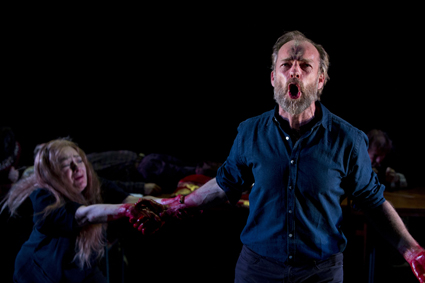
Melita Jurisic, Hugo Weaving, Macbeth, Sydney Theatre Company
photo Brett Boardman
Melita Jurisic, Hugo Weaving, Macbeth, Sydney Theatre Company
Powerfully performed and provocatively staged, Kip Williams’ Macbeth for the Sydney Theatre Company is bracingly emotional and corruscatingly memorable. It’s almost a perverse pleasure having seen many productions and films of this tragedy, to witness so intimately the Macbeths’ intense passion for each other, their mutual delight in the prophecy of kingship for Macbeth, the extreme discordancy over whether or not to act on it and, all too soon, their utter, quaking, near dumbfounded horror at having executed the deed. Even the resolute Lady Macbeth is aghast when she returns the knife to the scene of the crime, hovering over the body of the bloodied Duncan as if afraid to put the weapon down.
In an emotionally rich, finely graded performance Hugo Weaving’s Macbeth startlingly alternates between growing confidence (his voice deepening, his forceful rationale for further killing growled), eruptions of conscience (the protracted half-howling that stifles his speech in the presence of Banquo’s ghost), panicky anger over the uncertain meanings of the witches’ prophecies and, finally, his trumpeted over-reliance on them. His lament for his dead wife is sad but distracted, his “Tomorrow, and tomorrow…” expressly bitter, devoid of any sense of self-doubt. He fights with enormous energy, falls exhausted, drags himself to Macduff, grabs at his enemy’s legs and dies.
Melita Jurisic’s Lady Macbeth complements Weaving in physical energy and emotional volatility: she weeps over his letter, is playfully girlish upon his homecoming; she is profoundly shaken by her husband’s breakdown during the banquet and alarmed and defeated by his new murders, plotted without telling her. We are well prepared for her demise. Unfortunately, in the sleepwalking scene Jurisic ratchets her voice up from mezzo to a contorted cry, swallowing the words. There is a chilling moment however when passing by Macbeth, whom she doesn’t see; she utters, “Here’s the smell of blood still,” leans towards him and is repelled by what she senses.
Weaving and Jurisic run with the beat of Shakespeare’s poetry, Weaving initially with a kind of formality that suits the soldier but is soon emotionally undone, the performer expertly holding the poetic line. Jurisic near intones her words (as she did so strikingly in Barrie Kosky’s Mourning Becomes Elektra, STC, 1998). These complementary deliveries are in tune with the ensemble’s commitment to chiming the play’s insistent couplets and aphoristic utterances that point ‘the moral’ (and all its ironic ambiguities), recalling the Morality Plays so frequently evoked in Elizabethan and Jacobean drama.
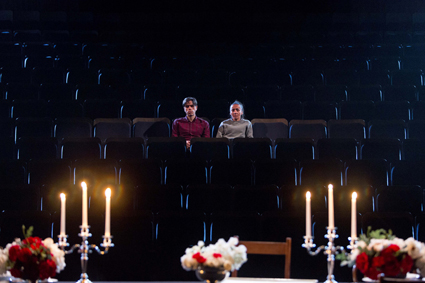
Macbeth, Sydney Theatre Company
photo Brett Boardman
Macbeth, Sydney Theatre Company
A DIY Macbeth
Peter Brook’s The Empty Space is prominently quoted from in the printed program. In Williams’ production, the audience shares the unadorned stage with the actors performing in close proximity to us, the vastness of the auditorium behind them. The theatre is not simply an empty space but one in which we find our usual position reversed—we might become players of a kind, or not. The effect of the reversal is certainly eerie—the sheer emptiness of the auditorium and our presence on stage echoes the multitude of utterances in the play about the loss of order, the confusion between real and unreal, the blurring of day and night and the putting on of appearances.
But before the auditorium comes into play, after some third of the performance, the conceit of ‘the empty space’ is compounded with the deployment of a complementary one—DIY theatre. Save for a long trestle table, various chairs, a simple crown, a regal cape, plastic raincoat and a ruff, the stage is bare of props. Others are added in due course: a single knife ominously handed scene to scene, character to character, plastic plates and wine glasses, black table cloth, cakes, candles, bowls of flowers, cups of stage blood and, finally, a large sword and an Elizabethan courtier’s outfit. The three weird sisters plunge their heads into water-filled Tupperware trays, burbling out their prophecies; later they use desserts to the same end in a grim bit of comedy that turns nasty with Macbeth lashed to a chair. The actors as stagehands manage the props (Macbeth sets the table for the banquet, “play[ing] the humble host”) and perform any number of roles, against gender and age: Paula Arundell is Banqo, Kate Box is Macduff, John Gaden plays King Duncan, an old man and Macduff’s child in a tender and metaphorically rich scene with Arundell, now as Lady Macduff. These effective transformations, with minimal if any costume change, confirm our sense of coherent society ravaged and undone—small tragedies within the play’s overarching cosmos.
However, this space is not so empty. Lighting constantly transforms it, creating new perspectives and ambiences and a world at once intimate and vast. A massive, eye-wateringly dense fog saturated with reds and pinks fills the stage after the murder of Duncan, until dispersed by banks of large electric fans aimed at us. The actors are head-miked, even when in close proximity to us. The sound score rumbles insistently (as in so many productions these days) but with a disturbing musicality: discrete pinged notes in moments of pathos and high emotion or a sub-melodic assemblage of distant possibly brass chords. This empty space is filled with the immersive sounds of cinema: miked voices and soundtrack. At times I wondered what un-miked voices might have done for our sense of immediacy and, especially, distance in the exploitation of this empty space.
I was surprised that greater use was not made of the auditorium: the conceit was nowhere near exhausted. Sometimes, the simplicity of the notion was effective: prior to his death, as other events unfold or he momentarily steps into them, Macbeth stands still on the forestage for a long time, back to us, staring into the auditorium, minus an audience—already on his way to becoming the “poor player/ That struts and frets his hour upon the stage/ And then is heard no more.” Even in battle he is alone, tightly bound by two pulsing spotlights, furiously brandishing his long sword against invisible enemies. In the end, Macduff, lifting the depleted Macbeth’s head, pours a cup of blood over him.
Weaving’s gripping performance and fine support from the ensemble are framed by the artifice of the empty space and DIY theatre. There are times when the first feels insufficiently embodied or contradictory, while the second borders on a ragbag of devices, but among them are powerful images: simply choreographed, ritualistic moments (“Is this a dagger which I see before me…?”), the swelling fog from which steps the Porter, Macbeth bound by the witches and doused in their dessert mix, and the sparkling, falling snow in which Macbeth will leave traces of the dance of his defeat.
How well do these conceits serve Shakespeare’s play? Admirably for the most part, imbuing the production with a necessary sense of disorientation and giving body to the tragedy’s insistent metaphors of chaos and illusion with essentially simple theatre magic. They underline Macbeth’s fatal dilemma. Believe the witches. Witches are wicked. Don’t trust them. Take action yourself. But still believe.
The final image of the play has the actors dressing Malcolm, Duncan’s son, in full courtly finery. He faces the auditorium, not us, and is crowned. Order, monarchical and theatrical, has been restored, as it had been when, after the anxious times that followed the death of the childless Elizabeth I, James VI of Scotland (a believer in witches) was crowned James I of England.
In his intriguing contemplation of theatre as a not so empty space, Kip Williams conjures in Hugo Weaving a great Macbeth—initially a man deprived of a “single state” in his terrifying oscillations between guilt and determination; later an entirely resolute murderer, shorn of self-doubt but a great poet of our common existential fate.
Sydney Theatre Company, Macbeth, writer William Shakespeare, director Kip Williams, performers Hugo Weaving, Melita Jurisic, Robert Menzies, Paula Arundell, John Gaden, Kate Box, Eden Falk, Ivan Donato, designer Alice Babbage, lighting Nick Schlieper, sound, composition Max Lyandvert; Sydney Theatre, opened 26 July
RealTime issue #122 Aug-Sept 2014 pg. 47
© Keith Gallasch; for permission to reproduce apply to realtime@realtimearts.net
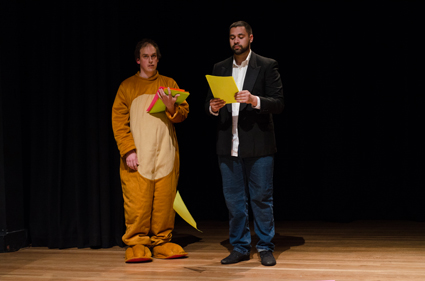
Malcolm Whittaker, Bjorn Stewart, Jumping the Shark Fantastic
photo Lucy Parakhina
Malcolm Whittaker, Bjorn Stewart, Jumping the Shark Fantastic
Jumping the Shark Fantastic starts at 7pm or at least it is supposed to; in actual fact it starts at ten past. The starting time has been determined by artist Malcolm Whittaker in consultation with the local community.
During a residency at Campbelltown Arts Centre, he has asked people what would constitute the best theatre show ever. Having compiled the responses and printed them on fluorescent paper (the community wants the show to be “colourful”), this evening he is taking to the stage to describe and to some extent enact their wishes.
The show begins with Whittaker in a bear suit, shuffling across the stage to “There’s No Business Like Show Business.” As the song finishes, he removes the bear head and drags out a cardboard box containing props, including a six-pack of beer. He explains that the best show he ever attended started with an actor offering the audience a drink, so he is doing the same now. Having explained the premise of the show, he presents his results.
The best theatre show would, he informs us, start not too early but not too late; it would start on time, and it would take place in a theatre a mere 10-minute walk from home. Every seat would be the best seat in the house and there would be an empty seat between each, should you want some personal space. Tickets are $15 and no one has missed out. The show itself, he reports, would start with a kabuki drop—simultaneously a large red curtain falls with a flourish. Whittaker continues: the curtain would part, as indeed it does, to reveal a cat on its hind legs, which it does not. Instead, we see a male performer in a suit reading out the instruction. This play between narration and presentation continues throughout the show.
Together with five other performers, Whittaker conjures—which is to say describes, suggests and hints at but never fully reveals—the best show ever. The characters include a farm boy and his farm girl crush, a convict, a milliner, two sex workers and a Holocaust survivor. The action is banal (a kitten has a bad dream and a mother cat comforts it) and brutal (there is a car crash in which two people will actually die, though it is performed here with toy cars), with the occasional plot twist (not specified, but enacted as a murder-suicide). The actors are professionals (our Cate would appear), amateurs (turns out they are just as good as Cate), real (an actor playing a victim of bullying would be revealed as the actual victim) and unreal (actors playing actors playing actors).
When combined these elements will produce a show that will be simultaneously authentic (a live feed of a public bathroom projected onto the back wall) and meta-theatrical (‘the canon’ would be undermined in a thoughtful, original way) or both (the fourth wall would be broken, only for a fifth even more impenetrable wall to emerge). Of course, the fun of the current show lies in the match or mismatch between the description and the action: two actors play the mother and baby cat, which is amusingly absurd, but when the theatre is described as plunging into total darkness, it actually does. In another fascinating moment, an actor refuses to read out the description Whittaker hands to her. Intriguingly, reviewers are not mentioned, which I presume means that they are either absent or awestruck.
Like post’s recent Oedipus Schmoedipus (RT119), Jumping the Shark Fantastic combines several contemporary performance trends: it deconstructs the canon, references pop culture, includes members of the community through consultation and/or casting and pursues a deliberately and deceptively amateur aesthetic. Unlike Oedipus however, Jumping never risks staging a full-blown scene of joy, violence or catharsis. Instead it stays safe, meaning that it’s clever and entertaining but ultimately too slight to be fully satisfying. Perhaps it’s all the pop culture but on the way home I remember a line from the Coen Brothers’ film O Brother Where Art Thou?, when Delmar (Tim Blake Nelson) offers Everett (George Clooney) some roast gopher for dinner, to which Everett replies, “No thank you, Delmar. A third of a gopher would only rouse my appetite without bedding her back down.” Not unlike a staged discussion of theatre.
Campbelltown Arts Centre: Jumping the Shark Fantastic, lead artist Malcolm Whittaker, performers Valerie Berry, Brett Johnson, Doug Niebling, Bjorn Stewart, Christie Woodhouse, lighting design Emma Lockhart-Wilson, sound design Preston Hawkes; Campbelltown Arts Centre, Sydney, 11-12 July
RealTime issue #122 Aug-Sept 2014 pg. 48
© Caroline Wake; for permission to reproduce apply to realtime@realtimearts.net
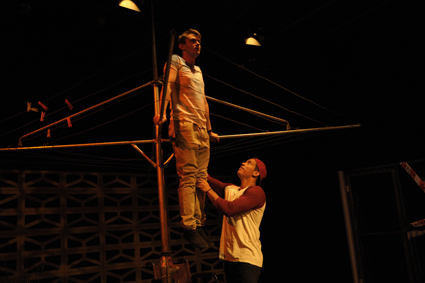
The Hoist
photo Paz Tassone
The Hoist
Darwin has seen a resurgence in high calibre original theatre in recent years, thanks in no small part to Brown’s Mart who have co-presented and supported numerous local theatre makers to develop and produce new work. Sarah Hope’s first full-length play, The Hoist, is the latest new work supported to production stage by Brown’s Mart, here with Corrugated Iron Youth Arts as co-producer.
This well-crafted and tightly directed play features a strong ensemble of five young actors. It begins with a ‘fast forward’—on a high balcony, the actors each step forward in turn into the light to speak a line which is at once revealing about a character and also intriguing. These lines are satisfyingly repeated at the play’s end and taken further.
Exploring friendship, dreams and change, The Hoist deals with the lives of teenagers in Darwin. It’s a coming of age story that avoids sentimentality while celebrating elements of youth culture. The dialogue is fast-paced and funny and sometimes deliberately stereotyped as Hope plays with current catch phrases which expose teen insecurities, cruelty and manipulation.
The play is centred around a Hills Hoist, that iconic Australian version of the clothes line. For Max, a wheelchair user who can’t always go where his mates go, the Hills Hoist becomes Shirley, his confidante and central to his dreams for the future—not only as a part of his gang’s secret plan but also as a slightly fantastical element when they climb to the top and the earth-bound Max asks, “What do you see?” Their visions reveal imaginative lives and also conjure the landscape of Darwin—expanding the claustrophobic backyard world of teens getting ready to fly the nest.
Kris Bird’s set is a beautifully simple evocation of a typical Darwin backyard: Hills Hoist, cracked concrete, corrugated iron shed and cyclone fencing—with a hole in it as an entrance/exit point. Director Gail Evans uses the whole area effectively: high balcony and side fences with the centrally placed Hoist providing opportunities for both climbing and canoodling. The ubiquitous tin shed comes alive in an explosive finale brought to life by first-time lighting designer Angus Robson. His design creates the big bang we know has to come: multiple colours from within the shed and lights that rove over the audience and high up to the ceiling of the theatre, extending the space and supporting the action.
I would like to see more empowerment in the female characters. Sarah Hope herself is clearly an empowered, intelligent writer. Call me old fashioned but I believe powerful new voices like Hope’s have a chance to make a difference in a still gender biased society—maybe even a duty.
The young actors give powerful, believable performances, testament to Evans’ ensemble building process. The writing is strong, the dialogue fluid and engaging, the characters rounded and the structure engaging—moving between linear storytelling to fast-forwards and flashbacks. It is a great first play.
Brown’s Mart Productions, Corrugated Iron Youth Arts, Salt Theatre: The Hoist, writer Sarah Hope, director Gail Evans performers Daniel Cunningham, Darren Edwards, Antony Koum, Aimee Gray, Ciella Williams, dramaturg Stephen Carleton, design Kris Bird, lighting, sound design Angus Robson; Brown’s Mart Theatre, Darwin, 10-22 June
RealTime issue #122 Aug-Sept 2014 pg. 48
© Nicola Fearn; for permission to reproduce apply to realtime@realtimearts.net
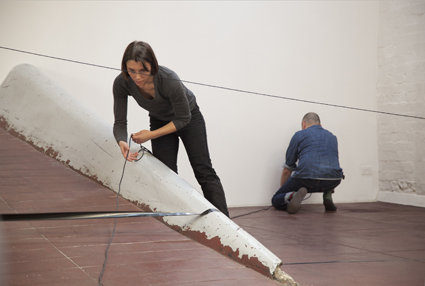
Helen Grogan, Geoff Robinson, Three Performative Structures for Slopes (27/4/2014)
photo Laura May Grogan
Helen Grogan, Geoff Robinson, Three Performative Structures for Slopes (27/4/2014)
It is no accident that the Melbourne chapter of Liquid Architecture 2014 begins and ends with violence inflicted upon microphones, both conceptually and literally. “Helen Grogan’s Concrete Room is the festival inauguration,” explains Co-artistic Director Joel Stern. “Helen maps the room by dragging a microphone with a very long lead around the perimeter.”
The Melbourne leg of the festival closes with Canadian artist, Christof Migone’s Hit Parade: “Fifty people with 50 guitar amps banging 50 microphones on the floor a thousand times each,” says Stern. “Christof’s work destroys microphones.”
You could say the Liquid Architecture festival is hitting its ‘difficult teenage phase.’ After 14 consecutive annual festivals focusing on sound art, the festival board put out a call for new blood and opened applications for festival curators. Stern and his long-time co-curator Danni Zuvela were awarded the position (since broadened to Artistic Directors). Liquid Architecture 2014 is set to be a more critical, confrontational and provocative festival.
“I’d like our audience to be angry, confused and critical,” muses Stern. “To be divided…less consensus,” adds Zuvela. “This year is a paradigm shift for Liquid Architecture.”
From its humble beginnings in Melbourne’s RMIT Student Union in 1998, Liquid Architecture has grown to become broadly recognised as Australia’s premiere sound art festival. Sound art has recently become akin to the latest hip thing in international contemporary art circles: Susan Phillipz won the 2010 Turner Prize with a sound work and last year MOMA staged the Soundings exhibition. So is the time ripe for Liquid Architecture to cash in on its sound art cred?
“We’re critical of the term,” says Stern. “It’s a curatorial shortcut to designate whole areas of practice that could be presented in a range of different ways, rather than just grouping them together as ‘sound art.’” Experimental culture is of more interest to the pair. “The concept of ‘experiment’ is super important,” says Zuvela. Stern agrees. “There is a broader experimental culture that crosses over questions of media.”
Stern and Zuvela may be new kids on the Liquid Architecture block (although Stern has been involved in various roles previously), but both have been bastions of experimental art curation in Australia over the past decade. The two met in Brisbane as post-graduate students (Zuvela has a PhD in Australian expanded cinema) and with Sally Golding founded the OtherFilm festival in 2004. Stern also performs in the experimental band Sky Needle and co-curated the much-missed Overground festival in 2011.
OtherFilm began by presenting multi-media happenings centred on experimental cinema and was then developed into a festival, partnering with Brisbane’s Institute of Modern Art. “In the early days of OtherFilm we were obsessed with film as a medium,” Stern recalls. “We were extremely militant about 16mm and Super 8 film. We wouldn’t show video.” “Yet we always went beyond film,” Zuvela adds. “There was always music, installation, food. We discussed dropping the name at one point; what if we didn’t want to do film?”
“That’s why we had the ‘Other’,” Stern says, grinning. “‘Other’ was a negative space where all these things could happen, but all in relation to film. That thinking mirrors how we address sound in Liquid Architecture. Where everything was film, we now see everything as sound.”
Liquid Architecture takes place primarily over five days in Melbourne in late September, across a wide variety of venues and situations (shorter programs follow in Brisbane, Sydney, Perth and Singapore). The festival’s theme is “The Ear is a Brain.” “We want works to excite the brain as much as the ear,” Stern explains. “It’s okay to have beautiful music, but I want my brain to be excited, too.”
“The program has some concert performance work, but there’s also work literally engaged in dialogue,” Zuvela says. West Space is hosting a daily series of readings and critical discussions led by visiting sound artists including Alessandro Bosetti and Christof Migone, and a program of ‘talk-performance’ lectures will take place at the National Gallery of Victoria. “The discursive aspects of the festival become a slippery slope between theory and practice.” says Stern.
Robin Fox will also be presenting his new sound and light extravaganza RGB Laser, and Taiwanese artist Hong-Kai Wang will complete a month-long residency at Gertrude Contemporary developing her new work Conceptual Biography of Chris Mann, centring on her mentor and ex-pat Melbourne compositional linguist. “Hong-Kai is one artist who has a more radical, sharper edge,” Zuvela says. “She’s interested in letting go of her authorship. She’s aware of composition as a political act.” Wang’s work will see transcripts of her interviews with Mann’s contemporaries performed by actors to reading and listening groups, whose subsequent dialogues will also become part of the work.
The festival also travels to the dingier end of town at The Tote with a line-up of more underground-orientated acts and performance artists, with acts split between the iconic pub’s stage and courtyard.
The 2014 Liquid Architecture program is varied in the performance contexts offered (from text-based works and lectures to pub gigs), but hovers consistently around concepts of sound through critical prisms. Stern and Zuvela aren’t nervous about audiences reacting negatively to this new edge of the festival, but don’t deny feeling some anxiety. “There’s pressure to innovate an organisation with an important history in Australian sound culture, and knowing people will agree and disagree,” Stern admits. “Sound is a subject of inquiry for almost every discipline. In the contemporary art world, sound is shaking up disciplinary boundaries. It’s going to be a festival about the best ideas of sound, rather than just practices of sound. For us, that’s what’s at stake.”
Liquid Architecture 2014: Melbourne 24-28 Sept, Brisbane 2 Oct, Sydney 4-5 Oct, Perth 6 Oct, Singapore 10-11 Oct. www.liquidarchitecture.org.au
RealTime issue #122 Aug-Sept 2014 pg. 49
© Clinton Green; for permission to reproduce apply to realtime@realtimearts.net
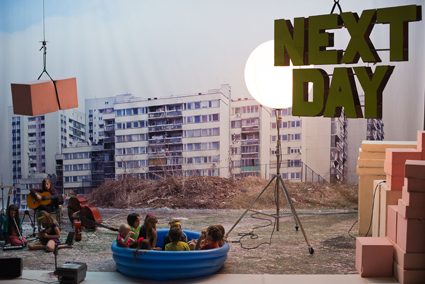
Next Day, Philippe Quesne and CAMPO
photo Martin Argylogro
Next Day, Philippe Quesne and CAMPO
Something kind of awful, but also a little bit funny, happens to one of the performers at the end of the performance of Philippe Quesne’s Next Day. This production is the latest in a series of works for young performers made in collaboration between Flemish company CAMPO and international theatre-makers; previous works have been with Gob Squad and Tim Etchells, for example.
In Next Day, the performers, all aged between 8 and 11, have been engaged in a series of fantastically constructed activities that are always on the verge of spilling over into chaos: fending off an alien attack, building a city out of oversized foam blocks, assembling an orchestra from a disparate range of instruments and musicianship. In the curtain call, they excitedly race onto the stage several times, wild and rambunctious, careening and bounding around the foam blocks.
And then, the inevitable happens. One of them bounces off one of the blocks a little bit sideways, misjudges the landing, and curls up on the stage clutching his ankle. He looks plaintively at us, not putting on a brave face to make us feel better, but clearly surprised and hurt and wondering why this happened to him in front of all these people who are supposed to be looking after him. In the audience, mostly adults, is a sense of confusion. Do we keep applauding? Should one of us help him? Has our responsibility shifted from offering aesthetic appreciation of a performance of childhood to what feels like a real need to assist? And yet, the seats we’re in are designed to suggest that our role is to stay where we are, so that’s what we do, even if we’re no longer quite sure what to do with our hands. Another child tries to help lift the injured boy but is waved angrily away, until eventually, after a few moments that feel like an eternity, an adult supervisor from the production comes to the stage and helps the fallen boy off stage. Relieved that it’s someone else’s responsibility after all, we resume our applause, and leave the theatre to go about our business.
This moment from near the end of this 20th iteration of the biennial LIFT is an unintentional but succinct demonstration of this year’s tagline: “Where the city meets the stage.” After an hour of brilliantly vivid visual theatre, those excruciating few moments served as a reminder that the world of action on the stage, and the world that starts where we are sitting and extends out through the foyer to the streets, are infinitely far apart and yet made of the same material: the living, breathing, tangible stuff of imagination animates both spheres. With its ambitious international program, the month-long festival reminds us again and again that the world of artifice and dreaming and the world of politics and agency are inter-nestled, folded layer upon layer, so that what is off-stage is always partly on-stage, and vice versa.
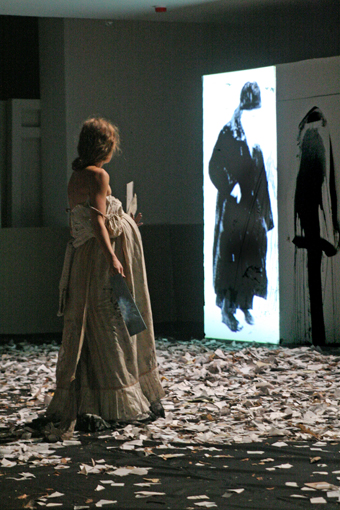
Opus No 7, Moscow School of Dramatic Art Theatre—Dmitry Krymov Laboratory
photo Natalia Cheban
Opus No 7, Moscow School of Dramatic Art Theatre—Dmitry Krymov Laboratory
Dmitry Krymov Lab, Opus No 7
This interweaving is thematised in Dmitry Krymov Lab’s Opus No 7, an opulent and dextrous work combining song, puppetry and physical theatre in a slowly accumulating spectacle. The work unfolds in two independent but complementary halves. The first finds a ragtag group of apparently placeless or displaced persons sifting through fragments of memory: half-remembered stories about people with Semitic names, piles of children’s clothes and shoes, photographs projected onto blank silhouettes, and scraps of paper that engulf the audience in a wind-driven maelstrom.
The second half tells a more particular story, that of Dmitry Shostakovich negotiating his relationship as an artist with an ever more brutal Soviet state. This story is depicted in a swirl of images that oscillate between whimsy and horror, and, though occasionally madcap, there’s a surprising spaciousness to the tempo of the work, with long lulls punctuated by frenetic outbursts that match the rhythms of the composer’s Jewish folksong-inflected music. It’s a vivid depiction of the way in which the making of art is always embedded within its political context, and how even an apparently apolitical aesthetic practice such as formalist music is informed by these contexts: even in the sequence of musical notes, state power and resistance are co-present. What’s more, this idea is manifest not only in the work’s thematic content, but also the circumstances of its presentation here. It is shown at LIFT, the program declares, as “An Official UK-Russia Year of Culture 2014 Event”: a harmless enough schema, no doubt, but the juxtaposition of this work’s Stalinist imagery and the ongoing repercussions of nationalism under Putin’s Russia, felt in Ukraine and beyond, give this blandly deferential phrase an ominous undertone.
Belarus Free Theatre, Red Forest
A contemporary version of the contest between authoritarianism and artistic expression is exemplified by Belarus Free Theatre, famously exiled from their native country. At LIFT they present Red Forest, an ambitious project that began with the company undertaking research throughout the world in sites of political, economic and ecological oppression. The ‘real stories’ of the people they met have been adapted into a fabric of wordless choreography, accompanied by narrative voice-over and live music. It’s an exciting and commendable initiative to see this company take the ways of working it has developed in response to its own political climate and apply them to new contexts and situations. But the results here are mixed, often reproducing stereotypical images such as women as perpetual victims of violence and indigenous peoples as wise truthsayers. Their work is strongest when the theatrical elements are not illustrative of a larger metaphor but have their own internal force, as in the ensemble’s powerful use of song, but more often than not the distinctiveness of the various stories and contexts is lost as they are collapsed into the same melodramatic dilemma in which victims are interchangeable.
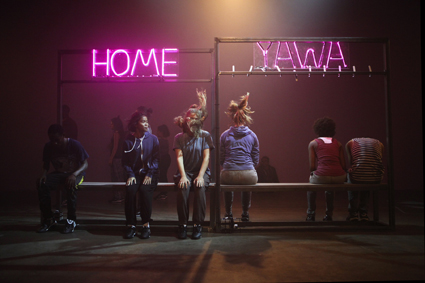
Turfed
courtesy LIFT
Turfed
LIFT-Street Child World Cup, Turfed
This is in contrast with some of the other works that draw on ‘real stories’ in the festival, where the particularity and individuality of the experiences being drawn upon are more lucidly illustrated. Working at a more modest scale than Belarus Free Theatre is a project called Turfed, specially commissioned by LIFT in partnership with the Street Child World Cup, a parallel tournament that calls attention to the rights of street children by bringing together from around the world a number of those who have experienced living on the streets. Now in its second iteration, it also features an artistic program in which an ensemble of children who have known life on the streets worked with director Renato Rocha over 10 months to make Turfed. Where Red Forest paints with broad strokes, Turfed creates a lyrical and affecting collage of visual images and abstracted fragments of narrative, seizing on poetic detail (the rhythm of rolling suitcases, the memory of a missing friend, the exuberant intensity of scoring a goal). In keeping with the festival theme, as a meeting of city and stage the work is also striking for the way in which it acknowledges, and uses to its advantage, the fact that an international festival like LIFT is no less imbricated than international sport within the swirling forces of globalisation.
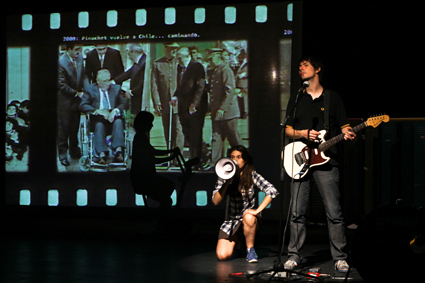
El año en que nací/The year I was born, Lola Arias
photo David Alarcón
El año en que nací/The year I was born, Lola Arias
Lola Arias, The year I was born
Similarly, it is the complexity of detail that comes vividly to life in Lola Arias’ The year I was born. It takes a very similar approach to Arias’ previous work My life after (2009), in which people who were born during the Argentinian dictatorship told the story of that time through their own experiences, finding creative ways to theatrically reconstruct events from their autobiographies. In this latest work, the stories come from Chile’s dark years under Pinochet, but in the meeting of life and art, the humanity and ingenuity of the theatrical endeavours in this present moment hold their own in the face of atrocities of the past. Smartly composed, full of contradictions and playfully inventive, it foregrounds the circumstances of its own making. Like the festival as a whole, it reminds us that theatre is not just a place where we can reflect on our real lives, but also where we might actively compose them.
LIFT, 2014: Philippe Quesne and CAMPO (France/Belgium), Next Day, Unicorn Theatre, London, 26-28 June; Moscow School of Dramatic Art Theatre—Dmitry Krymov Laboratory (Russia), Opus No 7, Barbican Theatre, London, 4-14 June; Belarus Free Theatre (Belarus), Red Forest, Young Vic, London, 12 June-5 July; Turfed, director Renato Rocha (Brazil), co-director Keziah Serreau, Hackney Downs Studios, London, 9-21 June; Lola Arias, El año en que nací/The year I was born (Argentina and Chile), Southbank Centre, London, 24-26 June
RealTime issue #122 Aug-Sept 2014 pg. 39
© Theron Schmidt; for permission to reproduce apply to realtime@realtimearts.net
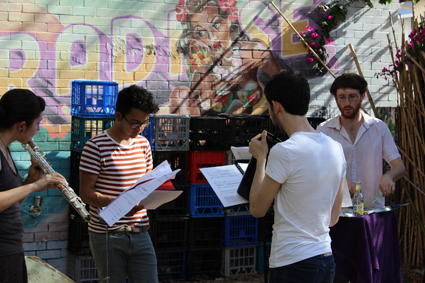
Kupka’s Piano
photo Liam Flenady
Kupka’s Piano
We’re in a low, boxy room that looks as much generic seminar room as concert venue for Kupka’s Piano, a new Brisbane ensemble performing what turns out to be a beautifully structured program. Begins with Alex Raineri playing Tristan Murail’s solo piano work, La Mandragore. It’s a spooky piece, symbolically linked by the composer to “a man swinging on the gallows.”
Raineri describes it as frozen, chilling, yet with ravishingly beautiful gestures and that’s how he plays it, wonderfully light, sharp and fast up high, dark and menacing down low, sad and lost in between. Mad rushes and flurries get cut short, start up again and are dashed once more. A superb performance that finishes with the room utterly still.
Next is La Rose pulvérisée. It’s a duet of spiky interlocking chases, the flute and violin repeatedly blending and pulling apart to eventually dissipate as “a large idea pulverised into a small idea”—composer Rune Glerop’s apt description.
More performers join the stage for the premiere of Melody Eötvös’ Wild October Jones. A very emotional work—sweeping, fragmented melodies as well as subtle textural drones from piano and bass drum, bowed vibes and flute. There is something 19th century about this piece, a romance and tension that has me thinking movies, soundscapes and Sherlock Holmesian intrigue. I look forward to hearing more of Eötvös’ work.
A couple of very short pieces follow. Kurtag’s Varga Bálint Ligaturája where muted piano, pathetic scrapes and mysterious harmonies on strings tentatively creep into a very tonal chord progression that is broken only at the final chord. Then Liza Lim’s Love Letter has Angus Wilson playing some surprisingly musical snapping on and off of the snare drum snares, but really needs some amplification to make audible the subtler manipulations.
The final piece, Brett Dean’s Old King’s in Exile, is inspired by Arno Geiger’s memoir of his father’s long decay into dementia. Old Kings begins like a premonition, a bleak landscape with dismal prospect. The first movement is dominated by sad melody and frenzied descending scales on clarinet, with an occasional burst of energy briefly punctuating the gloom. The second movement changes tack with interlocking runs on woodwinds, but the grim message remains—nerves might fire for a while but will eventually fail to present any coherent vision of the world. There is only the struggle, brief victories, inevitable decline.
In this final work, and throughout the entire concert, the seamless blending of sound between instruments reveals a genuine strength of the ensemble. Whether in forming a vertical texture or in handing a phrase from one instrument to another, the sound glows with the musicality of the performers. A joy of a concert. I drive home thinking how completely inadequate listening to music is on YouTube, or compressed for streaming, when compared to sitting with others in a real space, listening to the music and musicians of our time.
Kupka’s Piano, Modern Music in Exile, flutes Jodie Rottle, clarinets Nicholas Harmsen, piano Alex Raineri, percussion Angus Wilson, violin Adam Cadell, cello Katherine Philip, conductor Peter Clark; Judith Wright Centre, Brisbane, 23 May
RealTime issue #122 Aug-Sept 2014 pg. 50
© Greg Hooper; for permission to reproduce apply to realtime@realtimearts.net
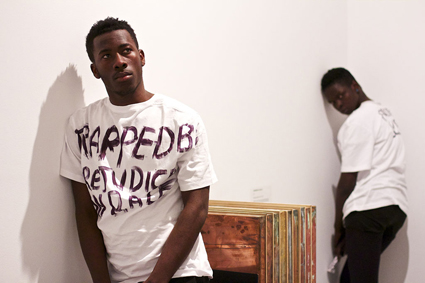
Joe Felber, Kontaktraum: Ausländer
photo Jon Avila
Joe Felber, Kontaktraum: Ausländer
Four formally experimental and expressively personal exhibitions in Adelaide reveal their artists’ feelings about life and art. They seem to search for languages to communicate their experience and fix their identity in a world dramatically in flux.
Kontaktraum: Ausländer
Joe Felber’s Kontaktraum: Ausländer (Space of contact: Foreigner) is like a personal retrospective of his work since the 1970s. Felber moved to Australia from Switzerland in 1980 and shifts between Australia and Europe. Trained in architecture, he works in painting, installation, sound and performance. Kontaktraum: Ausländer is a critical self-examination by a nomadic artist responding to cultural difference, commenting on the world’s intolerance and materialism and enquiring into the nature of art itself.
The gallery floor is completely covered in raw canvas tarpaulin on which Felber has painted a complex design of symbols, slogans and illustrations, with tyre-marks left by a bicycle wheel dipped in paint. As well as a painting, the tarpaulin may be seen as a road, a map, graffiti, a heated conversation or a record of thoughts while in transit. Memorable slogans and quotes highlight enduring debating points. Around the gallery are works from previous exhibitions, including batches of paintings stacked in racks as if in storage, denying reception and disorienting the viewer. The captions identifying the artworks’ homes (many are on loan for the exhibition) are like career milestones and thus proxies for the milestones of Felber’s wandering life. From a suitcase sitting in the middle of the floor, the sounds of the iconic Swiss cuckoo clock and of hurried footsteps are heard. Moments of Luigi Nono’s politically concerned music are also heard, triggered by the viewer’s movement.
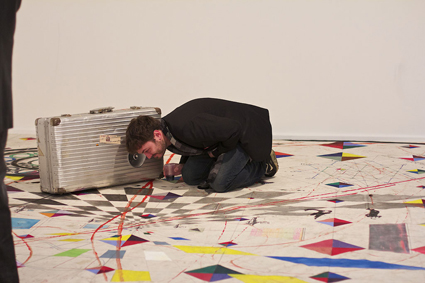
Joe Felber, Kontaktraum: Ausländer
photo Jon Avila
Joe Felber, Kontaktraum: Ausländer
The tarpaulin is also a stage as, on opening night, three simultaneous performances occur. Performers write slogans on each other’s white T-shirts referencing the experience of migrants and refugees. Another performer stands facing into a corner or gazing at a book under a light bulb on a pendulum as if engrossed in private contemplation, occasionally singing brief passages. And a couple engage in animated discussion on art, philosophy and politics while they walk, sit, lie or dance the tango. Their performance suggests the internal dialogue that haunts one’s consciousness and the emotional states that trigger human expression. The inclusion in the script of quotes like “Who’s afraid of red, yellow, blue?” (painter Barnett Newman) and “The true artist helps the world by revealing mystic truths” (Bruce Nauman) invite re-evaluation of artistic developments in recent decades. The couple, actors Mikaela Davis and David Geddes, are outstanding, giving a sustained performance in which they improvise around Felber’s outline directions.
Felber is sensitive to the political issues besetting the world and he questions how art might respond. He knows how art can become devoid of power and meaning, and in critically evaluating his own, he draws on significant influences, for example Pina Bausch’s dance theatre and Nono’s music. In a compelling manner, Felber combines art, sound, language and performance in a magisterial exhibition.
Metabolism: the City Coming Together and Coming Apart
Stanislava Pinchuk (aka Miso) draws by making lines of pinpricks in sheets of heavy drawing paper using an awl. The lines form images, for example, the moon’s craters, constellations of stars, spiderwebs, buildings, trees and mountains. Her tracery images also represent the movement of people in urban space. Pinchuk is an amateur tattooist and the piercing of the pristine textured paper is analogous to the piercing and staining of sensitive bare skin. This exhibition has two thematic elements: The City Coming Together, in which pinprick lines map the movement of people through Tokyo where she spends much of her time, and The City Coming Apart, in which she maps Kiev in her home country, the pinpricks tracing revolutionary action in the Maidan. She added pinpricks daily to record violent acts as they happened. Her exquisitely sensuous, minimal work is not only about image-making or mapping. It’s a coded diary recording her experience of life in the organically growing and decaying city.
A Serious of Objects
Sarah crowEST’s A Serious of Objects is a collection of many things: a row of paintings; two shelves of nondescript-looking ceramics (she calls them Nasty little brown things and Beautiful little brown things); unstretched canvases on which small pieces of cloth cut from friends’ clothes are stitched; index cards with reminders written on them (her father’s, which she has kept in memory of him); blob-like sculptural forms, some with cute teddy-bear eyes; and a wall of photos of previous work, like a mini-retrospective. The paintings suggest the tension between experimentation and commodification, while the stitched, raw canvases are a personal record of close associations, their captions listing the names of those who donated cloth. She endlessly makes things and the process of making appears spontaneous and intuitive, again a kind of personal mapping. In highlighting the importance of hand-made objects her work implicitly questions our materialism.
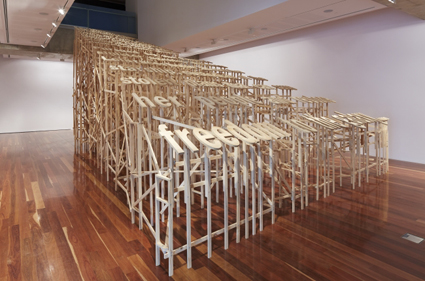
Roy Ananda, Slow crawl into infinity, 2014, installation view
courtesy Anne & Gordon Samstag Museum of Art
Roy Ananda, Slow crawl into infinity, 2014, installation view
Slow crawl into infinity
Roy Ananda’s Slow crawl into infinity is a huge timber framework, almost filling the Samstag Museum’s ground floor gallery. Mounted atop in plywood lettering is the explanatory scrolling text that opens Star Wars Episode IV: A New Hope. The whole form is about 5 x 10m and the plane of lettering slopes downwards, from about 5m to 2m high. This site-specific work is designed to be viewed both from underneath, where it appears as a forest of thin wooden strips, and from the gallery’s internal balcony above, from where viewers read the text. Rather than displaying, say, a statue of a Star Wars character (Darth Vader is the typical emblem), Ananda converts the text into a wryly spectacular monument. It comprises 3,000 metres of raw timber and 15,000 tech screws, and though it deliberately looks obsessive, its presence is overwhelming. In his artist’s talk, Ananda described the work as an expression of fandom, an amateur-looking homage. Its ramshackle character suggests the rickety foundations underpinning civilisation. Ananda’s art often addresses popular culture and the relationship between an image and the reality behind it, raising vital questions about contemporary culture.
The art of the personal
The navigation point for these four artists facing a world in flux is contemporary culture’s forms, values and beliefs and the power of symbols. Their studios are implicitly open to public view—Ananda built his work in the open gallery to enable viewers to witness its painstaking construction; Pinchuk’s art-making is documented on her web-page; crowEST’s approach can be found in her photomontage; and entering Joe Felber’s show is like entering his thoughts. The studio is the space for contemplation and communication.
Joe Felber, Kontaktraum: Ausländer, CACSA, 13 June-3 July; Stanislava Pinchuk, Metabolism: the City Coming Together and Coming Apart, Hugo Michell Gallery, 5 June–5 July; Sarah crowEST, A Serious of Objects, AEAF, 23 May–28 June; Roy Ananda, Slow crawl into infinity, Anne & Gordon Samstag Museum of Art, Adelaide, 20 May–18 July
RealTime issue #122 Aug-Sept 2014 pg. 52-53
© Chris Reid; for permission to reproduce apply to realtime@realtimearts.net
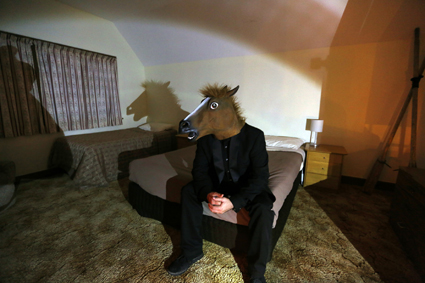
Motel Dreaming
photo Simon Cuthbertson, courtesy of Motel Dreaming, DARK MOFO, MONA Museum of Old and New Art
Motel Dreaming
DARK MOFO took over Hobart this June, a sprawling, ambitious festival that included dozens of concerts, a winter feast and Rafael Lozano-Hemmer’s Articulated Intersect, an installation of 18 audience-operated searchlights placed at locations around the Hobart waterfront. Articulated Insersect’s presence in the Hobart sky for 10 days created a vague sense of danger, as though the city was under attack (or, as the joke went, summoning Batman).
At the other end of the spectrum, Motel Dreaming was seen by less than a 100 people, which was as many as the motel where it was staged could accommodate overnight. Yet, for me, this work was at the heart of this year’s DARK MOFO experience.
Between Hobart and the northern suburbs, a kilometre from MONA but separated from it by a bend in the river, is an architectural oasis called the Riverfront Motel. Encapsulated within a decorative arch that was built to mark the Queen’s 1954 visit, it’s a familiar local landmark and a minor masterpiece of kitsch. Artist and social theorist David Patman grew up across the road from the Riverfront. He used to think about the strangeness of communal slumber in such a place. Years later, he and co-director Michelle Boyde instigated Motel Dreaming.
The complex work was delivered by a multi-disciplinary team, including sound and electronic media artist Matt Warren, lighting designer and artist Jason James, digital artist Noah Pedrini, interior designer Danielle Brustman, contemporary artists The Telepathy Project (Veronica Kent and Sean Peoples) and many others, including performers, DJs and even a ‘mini-bar curator.’
Check-in was at 3pm and guests went to their rooms to settle in wondering, “What next?” By late afternoon they gravitated towards the motel’s bar to be greeted by a grey-coiffed gentleman wearing a smoking jacket, and offered a glass of sherry. Then followed chit-chat and hors d’oeuvres of canned pineapple and glacé cherries until, little by little, guests became aware of a noise in the distance, an eerie siren. They began to move towards it…
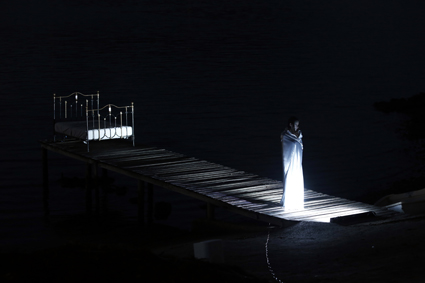
Siren installation, Matt Warren (sound), Jason James (lighting) James Andrews (performer)
photo Simon Cuthbertson, courtesy of Motel Dreaming, DARK MOFO, MONA Museum of Old and New Art
Siren installation, Matt Warren (sound), Jason James (lighting) James Andrews (performer)
In a performance on the riverbank was a ghostly androgynous figure, a different kind of Siren, slowly emerging from an old-fashioned bed on the river’s edge and wandering zombie-like up to a nearby house. Warming their hands over fire drums and sipping hot cider, the audience waited, on the patio of the house which they noted, with surprise, was a perfectly preserved example of mid-20 century Modernism.
Welcomed by Father, a jovial middle-aged man in a navy double-breasted blazer, and Mother, in voluminous skirt and high heels, the audience entered the house. Soon they were serving themselves from a buffet table. But where to eat? Some sat in the living room, in the glow of lava lamps. Others stood in the hallways, listening as the elder daughter played spooky music on an electronic harpsichord. In the younger daughter’s room, they found not a real child but a little woman, who sat in bed with her teddy bear and talked about her ‘mummy and daddy’ and what a lovely night it was.
After dinner a fleet of ratrods and a double-decker bus arrived to whisk everyone away to MONA. The controversial Southdale Shopping Centre exhibition had transformed the museum into a tourist visitor’s centre and an up-market mall. Satire, you see, and coming to grips with it required at least a couple of drinks from the Void Bar.
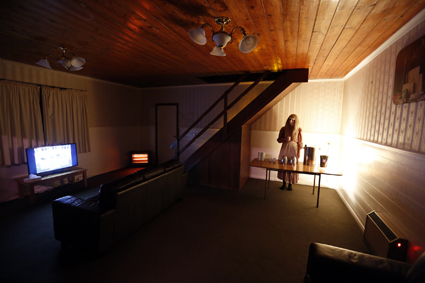
Kitchen Ghost, The Telepathy Project
photo Simon Cuthbertson, courtesy of Motel Dreaming, DARK MOFO, MONA Museum of Old and New Art
Kitchen Ghost, The Telepathy Project
Later, back at the motel, a line of tea lights led further back up the hill, to the Haunted Mansion, a mock-Edwardian house with rooms after room of strange noises and eerie, minimalist lighting. Behind this was a smaller (faux Tudor) building known as the Coach House. Here, a sombre young woman handed visitors fragrant tea. An electric heater blazed away, providing little warmth but serving as a kind of beacon, or perhaps a warning. Upstairs, stepping into a small bedroom meant coming face to face with a horse-headed man sitting on the bed, watching as a couple slept in a nearby alcove.
Those still not tired enough to embark upon the dreaming itself then returned to the late night lounge, to be entertained by projections and a silent disco. The cocktail of the night was a potent milk and nutmeg affair, as might be found at a mountain ski resort.
In the morning guests were asked to write down their dreams on postcards and hand them over, in exchange for coffee. Many did, and took the process seriously. Perhaps because they knew it was not just about them; it was about the group, the festival beyond, and society itself beyond that. The question being put was not merely “what did you dream last night?” but “what did we all dream last night?” And where are our dreams, and our nightmares, taking us?
Patman and Boyde gave their collaborators room to investigate Motel Dreaming in their own ways. Matt Warren, for example, created many discrete sound installations across the site, including in the Mansion. One of these consisted of whispered, repeated phrases heard in a dark, empty room, the text taken from guests’ “worst nightmares” (gathered before the event by Patman and Pedrini). Others were more subtle: the archway at the entrance of the motel emitted noise at four different frequencies; traffic noise recorded from the nearby highway was piped into the motel rooms via one of several in-house television channels. The Telepathy Project were given the Coach House as their domain and images of their sleep performance went out via a video feed. Dancer James Andrews, well known to DARK MOFOers for his numerous appearances across the festival, played the Siren but there was also a suggestion that his character was dreaming the events unfolding across the site.
Motel Dreaming captured key themes of DARK MOFO: transcendence, communal exploration and ritual, and the dark side of the psyche, evolving into a sort of conceptual nexus, a microcosm of the broader festival.
The 66 dreams collected from the Motel Dreaming experiment have been analysed by David Patman and Noah Pedrini with a view to determining the ‘representative’ dream of the night. The dreams will be available to read on the project’s website.
DARK MOFO: Motel Dreaming, Unconscious Collective, co-directors David Patman, Michell Boyde, Riverfront Motel and Villas, Hobart, 17, 18 June; www.moteldreaming.com.
RealTime issue #122 Aug-Sept 2014 pg. 54
© Briony Kidd; for permission to reproduce apply to realtime@realtimearts.net
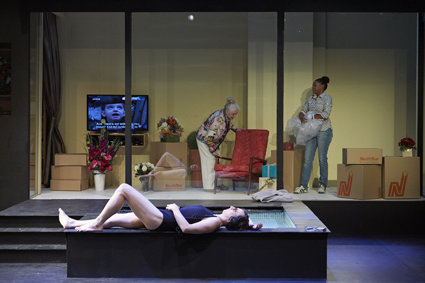
Hedda Gabler, Belvoir
photo Ellis Parrinder
Hedda Gabler, Belvoir
You would think that the conceit of casting a male actor, well known for onstage cross-dressing, might add to the abundant psychological and social complexities of Ibsen’s Hedda Gabler. In this adaptation for Belvoir, directed by Adena Jacobs, the effect is reductive: Hedda, as played by Ash Flanders, is simply a languorously posturing, caustic, one-note man-woman monster. The rationale for the casting is opaque.
There are other hints of ‘difference:’ Judge Brack is perhaps bi-sexual and Hedda appears to ogle the black maid, with whom she elsewhere shares a cigarette in a quiet moment, but the rest of the roles are played utterly straight. Justifiably silly thoughts cross the mind as the production’s cinematic longeurs roll on (Hedda gazes out of window, Hedda plays a shoot-em-up video game, Hedda lolls by pool): when will husband Tesman reel with shock, “I’ve married a transvestite…or a transsexual!”? In Ibsen’s play Hedda expresses her boredom, which is played here as mere indolence in contrast with the generations of actresses who have realised a nervy, naïve but cruelly self-aware romantic fatally trapped by bourgeois marriage, convention, duties and corset (see for example Fiona Shaw’s riveting account on YouTube). Of course, the corset has gone and the duties, but marriage and convention still rule the plot, if archaically in this awkward transposition to the present.
It’s difficult to get a fix on just where this ‘present’ is: inside a Hollywood TV series? It’s not a noticeably Australian transposition nor has it found for the late 19th century Hedda a parallel 21st century middle class woman. Presumably Jacobs’ Hedda is meant to present modern middle class women as genderless and narcissistic, while nonetheless doomed from the outset to make the same fatal choices Ibsen’s Hedda did, but with few of the conflicting emotions and less of the moral ambiguity that power the play’s existential force so strongly felt at the end of the 19th century. Jacobs’ Hedda is no freer than her antecedents, but is more clearly, or simply, a sociopath for whom boredom, more than any desire for control or a badge of existential courage, is her determining trait. Consequently the revelation scene is played as abrupt melodrama, as if not much were at stake.
The recent ruckus over the alleged dominance of director-driven adaptations of classics over new Australian plays aside, the re-workings of great plays are a reminder of anthropologist Claude Levi Strauss’ rather psychoanalytic observation that the re-telling of a myth over thousands of years, in whatever form or permutation, reinforces the power of the original. Classic plays have mythic status in our culture; they are secularly sacred. Their recurrent appearances on our stages, the screen and in our studies sustains their power, even when diminished by productions deemed to have missed the mark. Several years ago in the Sydney Festival, a radically reconstructed Hamlet directed by Thomas Ostermeier was widely agreed to have captured the essence of Shakespeare’s play in very contemporary terms (or idiom perhaps, being reminiscent of the Dogme film genre). Adena Jacobs’ Hedda Gabler has for the most part been seen as desecratory: the narrative preserved but the text thinned out and the interpretation of the central role an unembodied conceit. (Alison Croggon makes a limited case for the director’s likely intention in ABC Arts online, ABC Arts Mail, 1 Aug). If the production had gone someway towards metaphorically pointing up the tragic suffering of transsexuals, then good; but it did not.
If the interpretation of the role of Hedda was muted and neutered the show’s production values were over the top and wearyingly cinematic (including a badly miked scene inside a luxury car by the pool), with emotion provided at a key point by a recorded thundering classical choir (a tired po-mo ploy in contemporary performance and theatre, usually Baroque). But no amount of theatre magic covers for the emptiness of the interpretation.
Belvoir, Hedda Gabler, writer Henrik Ibsen, adaptor, director Adena Jacobs, designer Dayna Morrissey, costumes David Fleischer, lighting Danny Pettingill, composer Kelly Ryall; Belvoir Street Theatre, Sydney, opened 2 July
RealTime issue #122 Aug-Sept 2014 pg. web
© Keith Gallasch; for permission to reproduce apply to realtime@realtimearts.net
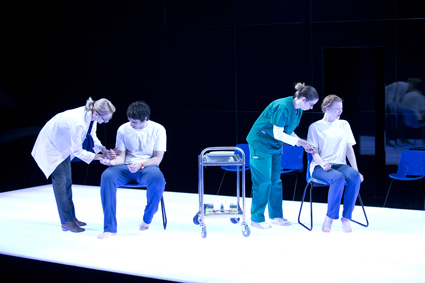
Angie Milliken, Mark Leonard Winter, Amy Burkett, Anna McGahan The Effect, STC/QTC co-production
photo Lisa Tomasetti
Angie Milliken, Mark Leonard Winter, Amy Burkett, Anna McGahan The Effect, STC/QTC co-production
UK playwright Lucy Prebble’s award-winning The Effect is being widely produced (an MTC production is playing in tandem with STC’s). It’s an ‘issue’ play that directly addresses the morality of drug trials from both sides—the medical professionals and their subjects. Prebble neatly pairs her protagonists. The head researcher, a pragmatic male psychiatrist has employed a female psychotherapist friend to run the trial. There’s a mere hint of something odd in their relationship, but this is irritatingly left hanging until the second of the play’s two acts.
Much of the first act focuses on a young man, a sardonic live wire, not particularly educated and an old hand at these tests and how to get around their restrictions. He’s attracted to a young woman, a psychology student, a rationalist who is in a relationship but has doubts about love. His playful insistence, the rarefied atmosphere of the trial (no communication with the outside world, no sex) and not knowing who is taking the mood enhancing drug and who the placebo breeds intimacy at first and then anxiety—is the man’s feeling of love for the woman natural? He believes he’s on the placebo, so it must be. When the truth is known, chaos ensues: the psychotherapist loses control of the test and of her own mental well-being, her damaged relationship with the psychiatrist is revealed and the young couple enter into a post-trial relationship of complex emotional and physical dependency. It’s an unhappy happy ending.
It’s disturbing that the clinicians in the play completely remove their subjects from the real world when testing drugs whose efficacy can only be determined socially. So, in an un-real clinical setting it’s not surprising that emotions and motives are suspect or warped. It’s likewise unsurprising that a psychotherapist will find a psychiatric model unaccommodating. But these tensions drive the play, providing a modicum of suspense, two mighty shocks and much to consider. The play is convincingly staged in a super-modern clinic: black walls with a mirroring sheen and a centre-stage low, wide platform—a light box-cum-specimen table that illuminates this detached world with unnatural colour. Overhead hang several video monitors indicating trial stages and readings while a spooky laboratory hum pervades the space. Brittle human behaviour sits at odds with the architectural and technological certainty of the clinic.
Although Prebble’s critique of rarified drug trialling is lucid, her treatment of her characters is less convincing. I’ve already mentioned the Act 2 revelations about the psychiatrist and the physiotherapist, which require awkward exposition. More problematic is the punishing treatment doled out to the psychotherapist—to what end thematically? It’s established that she was emotionally troubled before she met the psychiatrist in their earlier years, then subsequent to their parting and again now—wheelchair bound even. What has changed? While the young couple’s interaction—his carefree, idiosyncratic dancing and her growing sense of freedom in his presence—convinces both emotionally and in terms of the drug testing issue, the other couple’s doesn’t add up. Yes, he, the good corporate citizen, defends his testing methods and she finally objects to them, but her reactions come to nothing and he feels let off the hook—she doesn’t blame him for her breakdown. We learn nothing of her actual condition and he’s pretty much a cipher. The young couple on the other hand grow in complexity as the trialling becomes exacting, until they finally face a tragic reversal of their roles. The young in The Effect survive, if damaged and changed; their elders are locked in, he as the head of an institution, she institutionalised. Is that all Prebble has to say?
Sarah Goodes’ direction is effective, making good use of the spacious hi-tech design by Renee Mulder with lighting by Ben Hughes and sound by Guy Webster. Angie Milliken as the psychotherapist is adept at revealing confusion and pain in a limited role; Eugene Gilfedder is a quietly charming, emotionally armoured psychiatrist; Anna McGahan ably captures the transformation of a restrained young woman by a violent act that yields her subsequent frankness and caring; and Mark Leonard Winter as the young man is disarmingly all loose energy, trickery and passion.
Sydney Theatre Company, The Effect, writer Lucy Prebble, director Sarah Goodes; Wharf 1, STC, opened 12 July
RealTime issue #122 Aug-Sept 2014 pg. web
© Keith Gallasch; for permission to reproduce apply to realtime@realtimearts.net
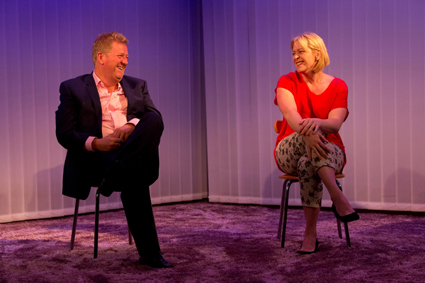
Steve Rogers, Andrea Gibbs, Eight Gigabytes of Hardcore Pornography
photo Brett Boardman
Steve Rogers, Andrea Gibbs, Eight Gigabytes of Hardcore Pornography
This felt like being subjected to eight gigabytes of pathos in a mere 90 minutes, witnessing the rapid descent of a shopaholic and a porn addict—who meet via the net in their desperation for companionship—into sheer abjection. She’s a nurse, has two children from a now dead, violent husband and her back is giving out; she’s broke and terrified of debt collectors. He’s unhappily married, an employee in a security business and a serial user of his office computer for accessing porn, for which he is sacked. His wife kicks him out.
The man and woman both believe that they fat and ugly, and see each other in the same light. For what appears to be a cathartic resolution following mutually degrading encounters, lies and fantasisings, the two stand stark naked, confessing their failings and feelings to each other—some are banally generic, others might be revealing, but we’ll never know; in the final, less than a minute scene, she tells us he’s gone, taking the last of her money. She quietly begs us, “Please don’t make fun of me.”
Although bravely performed by Steve Rogers and Andrea Gibbs, the play appears little more than a heavily narrated sketch, the immediacy of the contact between the two characters diminished by the constant inner detailing of their circumstances and fears and their past tense reporting on their encounters while these scenes are acted out ‘present tense.’ But only a little inner life is ever glimpsed amid all the paranoia, racism and sexism. Greene refuses his characters insights or moments of true connection; their lives have not been altered in meeting each other, and there is no dignity in the woman’s final utterance—it simply compounds the pathos that overwhelms the work.
Eight Gigabytes of Hardcore Pornography has nothing to tell us about addiction, save that it’s nasty and makes social engagement even harder than usual for two already socially inept people. Declan Greene’s attempt to create a form of narrational dialogue—spoken thoughts unheard by the other character, tense shifts, brief staccato lines and lists that provide exposition and action simultaneously—is interesting but ultimately distancing.
Designer Marg Horwell’s bland, abstracted living room with its deep pile carpet, white vertical blinds (onto which are thinly projected unhelpful lines from the text) and no furniture is a vacant space in which the two mid-life characters hover, living out their crises and creating, between them, a third trauma—an impossible relationship. As for Lee Lewis’ direction, it’s likewise plain, or as critical parlance goes these days, ‘transparent.’
Griffin Theatre Company and Perth Theatre Company, Eight Gigabytes of Hardcore Pornography, writer Declan Greene, director Lee Lewis, performers Andrea Gibbs, Steve Rogers, design Marg Horwell, lighting Matthew Marshall, composer Rachael Dease; SBW Stables, Sydney, 2 May-14June
RealTime issue #122 Aug-Sept 2014 pg. web
© Keith Gallasch; for permission to reproduce apply to realtime@realtimearts.net
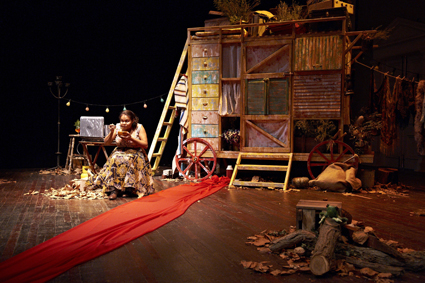
Ursula Yovich, The Magic Hour
photo Jon Green
Ursula Yovich, The Magic Hour
In his “The Lovesong of J. Alfred Prufrock” (1915), TS Eliot named dusk “the violet hour”—when the work-sodden, with charcoaled hearts, come home from thankless jobs to lonely rooms and food laid out in tins. In that terse, 133-line poem, he draws the picture of a whole time, culture and place trapped within the social and economic drives of history but, albeit half-consciously, desperate for something to change.
Vanessa Bates’ re-telling of six of the Grimms’ Fairy Tales is also set in that husk-dusk ‘magic hour’ where a combination of unspoken longing, hope, sadness, entrapment and desperation leak through into the tail-ends of our days. Her setting, however, is not the 1910-15 of pre-Great War London, but a 21st century dystopia of broken promises, intergenerational wounds, iniquities and inequities playing out in caravan parks, country discotheques and bleak high rises, Australia-wide.
While in her script, Big—as in Wolves, parents and grandparents, step-mothers and trailer-park trash, both black and white—meet Small (daughters, sisters, sons, tiny babes), there is no reassurance that anything in the Big World brings redemption. As in the Grimms’ tales, ‘homes’ are compromised: babies are abandoned, taken up and adopted, but abandoned yet again. Where is the woodchopper (the Father or overarching caregiver) who overcomes the Wolf, the Stepmother, the Rumpelstiltzkin?
Grandmothers sleep with their granddaughters’ boyfriends; fathers, rather than providing protection, betray their daughters to a scheming Frog and leave the mother with chlamydia; and Jack’s mother ends up taking one heroin dose too many, leaving him abandoned to his resilience but essentially alone.
Curiously, these stories are actually minus the Uncanny, which in the Grimms’ tales also open doorways to redemption. Bates’ “magic hour” is thus closer to the bleak hyper-realities of Tim Winton, especially his stories in The Turning.
The performance thus leaves a curious taste. The show is not quite bittersweet, not quite sour; but significant questions arise. For example: who supplied those drugs to Jack’s dad and mum? Who built that ghastly housing commission high-rise? Perhaps, as with Winton, these represent an index of deep and long-standing social malaise and, as such, much more complex than to be left to the Uncanny to resolve.
One cannot escape the fact that Ursula Yovich, a performer of Aboriginal heritage, brings a sharp poignancy to the telling of these tales just by visibly (both darkly and lightly) being who she is. This puts a sharper edge on the production than if the storyteller were cast as a middle-class white female, for whom it was generically written, but again not one that resolves anything in a simple way. With such complex history as we have in 21st century Australia, who is the Father, the saviour; where is the wisdom and resilience that survives and precipitates deep change for our society as a whole?
That said, the work—so beautifully performed, directed and staged—creates great pleasures too, and can be received on many levels. An elderly gent in the stalls before me called out a simple, heart-felled ‘Yay” as he applauded, so deeply moved and engaged was he, it seems. I am moved by his response; it’s as if he were responding to a tale told by his own grandchild: ‘Ah, here is the wound. Let me hold and feel it with you.’
Perhaps, this age, the age in which we live, is one that hears all, solves nothing. But in that very fact may be our redemption.
The Magic Hour, writer Vanessa Bates, director Chris Bendall, performer Ursula Yovich, designer, Alicia Clements, lighting, music Joe Lui; Street Theatre, Canberra, 5, 6 July
RealTime issue #122 Aug-Sept 2014 pg. web
© Zsuzsanna Soboslay; for permission to reproduce apply to realtime@realtimearts.net
In Inverse Spaces, Elizabeth Welsh and Kim Tan lead an unnamed ensemble in a program of post-serial composition from Italy. From this body of work they curate a musician’s arsenal of space, exploring the insides and outsides of psychological, domestic, musical and sonic spaces. Excellent notes by Tan guide the audience through the program, which sometimes couldn’t help departing from its raison d’être to present some plain old fine music.
Our first stop is A Pierre. Dell’azzurro Silenzio, Inquietum, a four-channel sonic environment designed by Luigi Nono. The environment is activated by whispers and grunts from Samuel Dunscombe on contrabass clarinet and Tan on bass flute. The sonic space increases in density while maintaining the same serene volume as the performers’ contributions are picked up and diffused. While the performers’ own sounds projected beautifully within the severe art deco interior of the Collins Street Baptist Church, the electroacoustic element sounded unfortunately two-dimensional.
From a large space to a claustrophobic one, Franco Donatoni’s Ciglio II is a duo for quarrelling voices. Tan associates the piece with a muffled dispute heard from an adjoining apartment. The quick pulse of the first movement underpins an exciting rhythmic counterpoint as the two voices dart about combatively. Mocking, descending chromatic lines appear as the argument turns nasty. The gestural imitation that constitutes the rest of the piece is its least imaginative part. It is as though Donatoni had run out of ideas and shoved in a study he wrote as a student. Welsh and Tan did their best to bring out the different voices of the study at this point, breathing life into a piece written in 1997 that sounded 100 years old.
Tan writes that the patterns of breath and choked punctuations of Toshio Hosokawa’s Atem-Lied for solo flute were “parallel patterns of speech,” but they resemble more of a virtuosic snore. Either way they acted as “a passage between inside and outside.” A particularly arresting effect was breathing into the flute while clattering the keys, which produced a gruesome, insect-like sound.
In Giacinto Scelsi’s Duo for violin and cello the two instruments drone along in a monotonous wash of string sound barely inflected by microtonal shifts and changing bow positions. Judith Hamann brought out the wonderful effect of droning on one string while playing trills high up on the fingerboard on another. The two instruments form a single conflicted voice, an “inner writhing” in Tan’s words. The particular mental space evoked is familiar to us all from the early morning before coffee.
Aldo Clementi’s Due Canoni is a fascinating experiment in tempo. The same canon is played three times, each time slower than the last. The first time it is heard as an atonal canon played legato in the violin and flute. The piano’s part is scattered with dynamics that make it jump out of the otherwise smooth surface. On the second, slower repetition the ear stretches to make sense of each note, inventing harmonies and passing notes between each distant tone. The effect is like watching atonality march off into the desert to die. As it retreats, it is harder and harder to make out. The third repetition changes the game once again, for each note is so long that you no longer hear the relationship between the voices, but focus in on the sound production of each individual tone. One becomes aware how difficult it is to keep each bow and breath steady, or of the beats in each piano note.
If this review seems a little light-hearted, this is perhaps because the works (and program notes) gave plenty of space for imaginative interpretation. The particular brand of Italian new music explored by the ensemble could well be described as “new simplicity for new complexists,” such was the laid-back presentation of otherwise difficult material.
Inverse Spaces, Elizabeth Welsh, Kim Tan and ensemble, Collins Street Baptist Church, Melbourne, 28 June
RealTime issue #122 Aug-Sept 2014 pg. web
© Matthew Lorenzon; for permission to reproduce apply to realtime@realtimearts.net
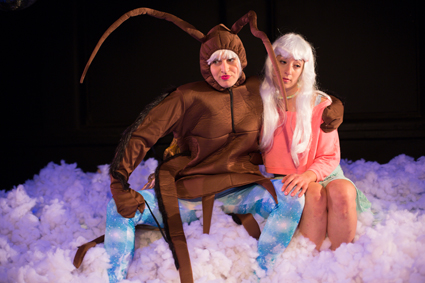
Rabbithead, Little y Theatre Co. & whatshesaid
photo Simon Pynt
Rabbithead, Little y Theatre Co. & whatshesaid
Presented by Little y Theatre Company in collaboration with emerging company whatshesaid, Rabbithead takes Barbara Baynton’s 1896 Australian Gothic bush story The Chosen Vessel, which as its point of provocation presents a bleak vision of a harshly malevolent landscape populated with sinister figures preying on women in their isolation. Instead of the threat coming from outside the home as in the story, Rabbithead explores the dangers that come from within: from the person closest to you, from your unattainable desires and the tyrannical sense of entitlement instilled in the psyche by a materialist culture which insists “you’re worth it.”
Housemates Holly and Violette (Holly Garvey and Violette Ayad) are excruciatingly self-absorbed and vapid: hyper products, it seems, of their time—obsessed with their online profiles, always plugged-in and suffering from an indefinite latency period in reaching emotional maturity. Violette doesn’t even have the capacity to look after her pet rabbit. Rabbithead is left in his cage, emaciated and filthy, until Holly decides to kill him rather than take on the responsibility to care for him herself. While Holly deals with her guilt through a drug-induced anthropomorphic soul- transference with the pet rabbit (!), Violette attempts to redeem herself by caring for the batch of eggs she and her boyfriend—literally, a cockroach—have conceived.
The potential of this surrealism-driven menace is never fully realised, and character development is eschewed for camp histrionics and gyrating choreography. The deliberately oversaturated spun-candy aesthetic—a knee-deep cotton-ball covered set from which puppets and the performers emerge—is, unfortunately, a manifestation of the surface treatment of the work as a whole.
As a devised piece, director Ian Sinclair asked his actors to create characters whose values and goals were in deliberate opposition to their own. In doing so, the performers perhaps succeed too well; what we end up with are characters so alienated from their performers that they struggle to infuse them with any significance. The piece does succeed in creating some darkly fascinating moments however, accentuated by the clever and decidedly creepy sound design by local composer and DJ Catlips (Katy Campbell). One is the discovery and subsequent devouring of the hidden cockroach eggs by the ravenously carnivorous Holly/Rabbithead.
Conceptually intriguing but overwrought in delivery, Rabbithead would have benefited from nuanced characterisations and less reliance on lip-synching and street-jazz dance numbers to fill out the scenes.
The Blue Room Theatre, Little y Theatre Co. & whatshesaid: Rabbithead director Ian Sinclair, performers, devisors, co-producers Holly Garvey, Violette Ayad, narrator Humphrey Bower, design Tessa Darcey, lighting Chris Donnelly, producer Georgia King; The Blue Room Theatre, Perth WA, 27 May -14 June
RealTime issue #122 Aug-Sept 2014 pg. web
© Astrid Francis; for permission to reproduce apply to realtime@realtimearts.net
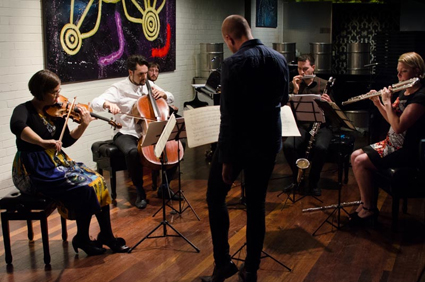
Syzygy Ensemble
photo Matt Rynn
Syzygy Ensemble
Syzygy are up from Melbourne and playing at the largish Blue Sky Coffee cafe courtesy of DeClassifiedMusic, a fairly new organisation promoting concerts into Brisbane’s Newstead (place of bars/restaurants/things to do and buy). Music as one part of the flow of the day’s events rather than as the full stop at the end of the day. That’s a great addition to the Brisbane scene.
By far my favourite piece of the concert is Charles Ives’ Sonata No.4 for violin and piano. In the neat preparatory talk, Harrald and Khafagi play us the original tunes Ives used for each of the three movements—“Tell me the old, old story,” “Yes, Jesus loves me” and “Shall we gather at the river?” Performers often introduce pieces with a short description of the composer’s intent or perhaps a formal aspect of the music, but this is perhaps the first time I’ve seen performers actually play examples in their discussion. Works well.
Ives wrote Sonata no 4 as a fond tribute to the religious summer camps of his town and Harrald beautifully channels an amateur tent performer for the rambling goofy religiosity of the first movement. It’s a slightly hysterical, almost out of control performance that surges with confidence then shudders and slows to make a tricky chord change only to suddenly ramp up the gusto for a favourite bit that isn’t so hard to play. The second movment couldn’t be more different—slow and gentle, an impressionistic pastorale that lets Khafagi’s violin shine through. There’s a sentimental edge here and there that at times reminds me of Gershwin whereas the final movement ragtimes away like Cole Porter: wild jumps, skipping melody and an abrupt mid-melody end, as though the bell has rung, the hymn books dropped, the kids run out to play.
Of the other pieces, Fausto Romitelli’s Domeniche alla periferia dell’impero is nicely atmospheric with lots of descending glides and squeeky door sounds—tiny motifs that get traded around, repeated and elaborated. Very much an ambient piece and probably the only time I have heard a kazoo used for subtle timbral layering rather than for comic effect.
To finish is David Dzubay’s Kukulkan—six short movements programmed around the structure and use of a Mayan temple. Program music can sometimes get a bit stolid and prog rock or sentimental and twee, symbols grinding away as surrogates for far too fraught emotions. I don’t get that with Kukulkan. Instead, there is more of a cinematic wash to each movement. Forbidding piano and spooky clarinet sound like a 30s mystery, dimly lit passageways, a man with a hat, a door opens and the glimpse of a gun. Or next movement and switch to light, joyful 60s and the end of austerity Britain—young love at Oxford, the student and the shopgirl, ride through the square and scatter the pigeons, punt along the river, plop down on the grassy bank for that very first kiss. Except it’s Mayan, human sacrifice, hearts held aloft.
DeClassified Music, TRIVIUM: The Art of Logic, Rhetoric & Grammar: Syzygy Ensemble, piano Leigh Harrold, cello Blair Harris, clarinet Robin Henry, flute Laila Engle, violin Jenny Khafagi, Blue Sky Coffee, Brisbane, 7 June
RealTime issue #122 Aug-Sept 2014 pg. web
© Greg Hooper; for permission to reproduce apply to realtime@realtimearts.net
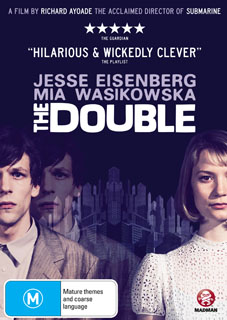
DVD: The Double
Directed by English comedian, actor and writer Richard Ayoade, The Double is a doppelganger comedy that tests the transformational skills of Jessie Eisenberg playing two conflicting selves alongside the ever morphing Mia Wasikowska and Noah Taylor.
3 copies courtesy of Madman Entertainment
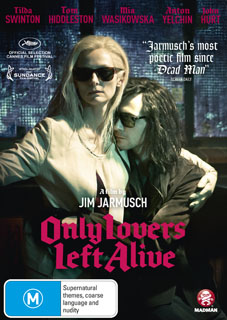
DVD: Only lovers left Alive
A world weary decadence pervades this richly detailed, funny film from Jim Jarmusch about a couple of retiree vampires trying, through a love that’s endured centuries, to still that gnawing bloodlust.
3 copies courtesy of Madman Entertainment
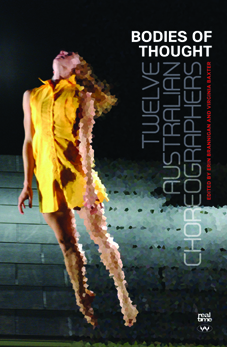
Book: Bodies of Thought: 12 Australian Choreographers
From RealTime and Wakefield Press, a groundbreaking, beautifully designed new book for lovers of Australian contemporary dance, focused on innovative choreographers, concentrating on a work by each with an accessible interview and an insightful essay by a leading dance writer. Edited by Erin Brannigan and Virginia Baxter.
3 copies courtesy of RealTime
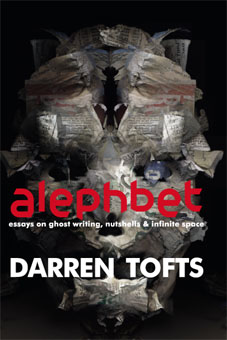
Book: alephbet, essays on ghost writing, nutshells & infinite space
“To read [alephbet] is to breathe as if we are drowning in binary code, and it is in this ecstatic, hyperbolic universe that Tofts creates arguments about writing.” Darren Jorgeson (page 29)
1 copy courtesy of Litteraria Pragensia Books.
Please note you can nominate for ONLY ONE GIVEAWAY.
Email us at giveaways@realtimearts.net with your name, postal address and phone number.
Include ‘Giveaway’ and the name of the item in the subject line.
RealTime issue #122 Aug-Sept 2014 pg. 56
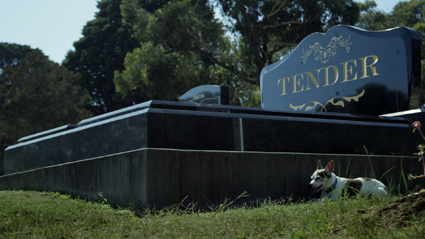
Tender, Lynette Wallworth
What happens when you take three of Australia’s most innovative and dynamic artists—media artist Lynette Wallworth, choreographer Gideon Obarzanek and theatre director Michael Kantor—and provide them with $670,000 in funding to produce arts-based films in multidisciplinary teams? The results were on show over three Sunday nights in June when ABC1 screened these three bold projects fostered by the Hive Lab, an initiative of the 2011 Adelaide Film Festival.
With additional funding from ABC Arts and Entertainment, the Australia Council, Screen Australia and the South Australian Film Corporation, these ambitious films were developed in a workshop environment with the aim of “break(ing) down the silos between film and the rest of the arts,” said Katrina Sedgwick (then director of the Adelaide Film Festival and now of ABC Arts and Entertainment) in 2011. The films premiered at the Adelaide Film Festival in October 2013 and have since enjoyed success in other venues. For example, Obarzanek’s I Want to Dance Better at Parties was recently awarded the Dendy Award for Best Live Action Short at the 2014 Sydney Film Festival and Wallworth’s Tender received the $25,000 David and Joan Williams Documentary Fellowship Award at the 2014 Australian International Documentary Conference.
Lynette Wallworth, Tender
Wallworth’s Tender was produced by Kath Shelper, whose previous work includes the award-winning Samson & Delilah (2009, director Warwick Thornton). This touching 73-minute documentary follows the quest of a small but determined community group in Port Kembla (NSW) who aim to set up their own low-cost funeral service. Led by their manager (and Wallworth’s lifelong friend, Jenny Briscoe-Hough), the residents attempt to bypass the commercial drivers of the funeral industry, to make their own coffins and to access their own burial ground. As their plans gain traction, the community centre’s caretaker Neil is diagnosed with terminal cancer and it becomes clear that his funeral will be the group’s first responsibility. This unforeseen twist (Neil received his diagnosis two weeks before filming began and then passed away before the film’s 10-week shoot was over) adds a sense of urgency to the group’s project.
From the outset, this observational ‘fly on the wall’ work gives the audience intimate access to the group’s frank discussions concerning the nature of death and dying. Both the static and handheld cinematography by Simon Morris keeps the viewer close to the participants as they go about their daily business, also capturing expressions of emotion as they grieve for their much-loved friend and colleague. One particularly affecting sequence sees Wallworth utilise still photography to capture images of Neil’s body being prepared for his funeral. Tender is ultimately an insightful and uplifting film, which questions the protocols associated with the act of dying. (See realtime tv interview with Lynette Wallworth.)
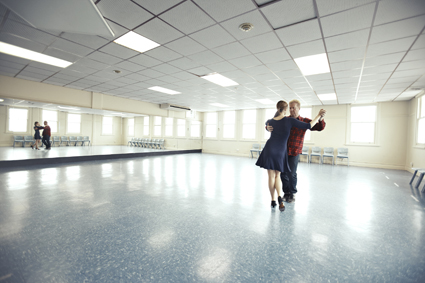
Elizabeth Nabben, Steve Rogers, I Want to Dance Better at Parties
photo Ian Routledge
Elizabeth Nabben, Steve Rogers, I Want to Dance Better at Parties
Gideon Obarzanek, I Want to Dance Better at Parties
Gideon Obarzanek’s I Want to Dance Better at Parties is a hybrid project based on the 2004 Chunky Move dance production of the same name. Co-written and directed by Matthew Bate (creator of Shut Up Little Man! An Audio Misadventure, 2011) and produced by his colleague Rebecca Summerton at Adelaide-based Closer Productions, this 28-minute docudrama tells the story of middle-aged Phillip Rose, a single parent recovering from the untimely death of his wife. Seeking to improve his dance style (and by consequence, his social life) Rose takes up weekly dance classes with an enthusiastic young instructor, Melissa (Elizabeth Nabben). In an otherwise deserted dance studio he learns a variety of sensual Latin dances and the two become friends, ultimately performing together in an amateur dance competition. This climatic competition scene recalls that of Strictly Ballroom (Baz Luhrmann, 1992), but is in fact filmed using a real-world backdrop, with competitive dancers and members of the public.
The film is narrated by Rose himself in documentary style, but the story is also dramatically recreated with a sympathetic and somewhat dance-challenged Steve Rogers in the central role. Rose himself occasionally appears in the background of these recreated scenes, as if he’s watching and reliving his lonely experiences from a more comfortable place. A handheld camera follows over Rose’s shoulder or offers his point of view as he dances, fostering strong audience identification. I Want to Dance Better at Parties successfully weaves documentary and drama, film and dance, to create a moving portrayal of a man reclaiming lost meaning in his life.
Michael Kantor, The Boy Castaways
The Boy Castaways is perhaps the most ambitious of the three films. Directed by former Malthouse Theatre director Michael Cantor, this feature length rock musical (touted as a reimagining of Peter Pan) stars Mark Leonard Winter as insomniac office worker Michael, a man drawn into a surreal parallel world that exists in a mysterious theatre. Here he joins a bizarre mix of characters who seem midway through the staging of an elaborate spectacle (Tim Rogers as the cryptic Peter, Marco Chiappi as the demanding George and Paul Capsis as gentle Nico). Michael finds himself drawn to enigmatic theatre manager Sarina (Megan Washington) but he cannot be sure that she returns his affections. As the narrative moves between musical numbers on and off stage, the audience is positioned alongside Michael, wondering what is real and what is artifice.
The bold colour and high contrast lighting of Cantor’s theatrical visuals is a delight for the eye but the camera often frames subjects in distancing wide shots, making it hard to engage with characters on an emotional level. The uttering of cryptic and isolated lines of dialogue turns the film’s first half into something reminiscent of a Mad Hatter’s tea party, with Michael seemingly perplexed as to his place in the performance. The film’s dark ending, which sees death as a means of rebirth, returns the protagonist to the outside world, leaving the viewer with questions concerning the nature of his journey.
It is perhaps coincidental that the three Hive projects explore common themes of death, escape and grieving. Although diverse in their content and methods of realisation, each presents a unique viewing experience, delivering boutique film festival content to public television.
HIVE Production Fund Films: Tender, writer, director Lynette Wallworth, producer Kath Shelper, cinematographer Simon Morris, editor Karryn de Cinque, sound designer Liam Egan, music Nick Cave & Warren Ellis; I Want to Dance Better at Parties, directors, writers Matthew Bate, Gideon Obarzanek, producer: Rebecca Summerton, editor: Bryan Mason, cinematographer Bryan Mason, composer: Benjamin Speed; The Boy Castaways, director Michael Kantor, writers Michael Kantor, Raimondo Cortese, producers: Jo Dyer, Stephen Armstrong, executive Producer: Robert Connolly; ABC1, June
RealTime issue #122 Aug-Sept 2014 pg. 28
© Kath Dooley; for permission to reproduce apply to realtime@realtimearts.net
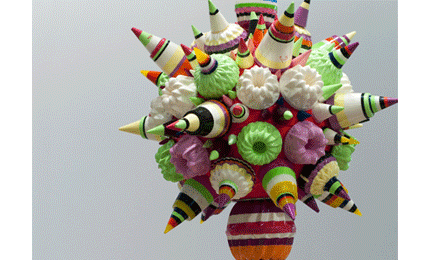
Zoe Kirkwood, 1) Let Them Eat Cake (detail); 2) The Neo-Baroque Spectacle, installation view.
photos Che Chorley. Zoe Kirkwood, a graduate of the University of SA, is the winner of this year’s Dr Harold Schenberg Art Prize presented at HATCHED National Graduate Show, 2014, PICA, Perth.
Zoe Kirkwood, 1) Let Them Eat Cake (detail); 2) The Neo-Baroque Spectacle, installation view.
Conducting an informal survey of arts education and training for this edition of RealTime has been revealing. It’s striking how university arts faculties and schools are having to establish a public presence in an increasingly competitive market. They’ve been doing this modestly for a long time with open days and hosts of public performances, but the pressure is on as the Abbott Government ‘deregulates’ the tertiary education market.
The second noticeable development is integration, first within degrees—two majors are more frequent, for example directing and design—and across discrete disciplines—double degrees for example media arts and science, dance and law. Secondly, schools are increasingly aligning and partnering themselves with the cultural and creative industries. Jane Montgomery Griffiths (p12) tells us that Monash’s Centre for Theatre & Performance will sponsor Malthouse in a relationship which will benefit their students in attachments with the company. Monash is also holding workshops for the theatre industry featuring prominent overseas artists. Adelaide College of the Arts (p16) enjoys a strong relationship with the State Theatre Company of South Australia and the VCA with a multitude of organisations (p14).
The same kind of integration can be seen in the ‘re-birthing’ of UNSW’s College of Fine Arts as UNSW Art & Design (p6), with local and international partnerships, a significant number of students taking up double degrees, new buildings and facilities. Integration builds public presence.
New and re-visioned degrees are also proliferating, for example VCA’s timely Master of Dramaturgy and SymbioticA’s Master of Biological Art at the University of Western Australia (p22).
If seen as integral to the ‘industry,’ teaching staff play an important role in developing the profiles of tertiary education institutions, not only attracting students but negotiating various partnerships and funded research opportunities.
Unfortunately, for the most part university websites, the key providers of information, are still difficult to negotiate, let alone discover who the teachers are and precisely what courses they teach. Sometimes the information can be found if you’re dogged, but it’s often of varying quality and degree of detail and with little sense of a school’s collective vision—which is most frequently abstractly stated. Similarly, information about graduates varies greatly. Prospective students need to know the who and why of the world they about to enter.
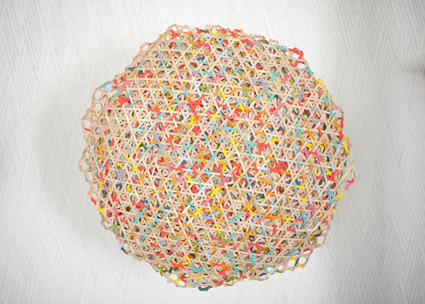
Michael McIntyre, Everything / Becoming A Monster, 2013, Highly Commended, HATCHED Graduate Exhibition, PICA. Image courtesy and copyright the artist.
photo Peter Morgan. Michael McIntyre is a graduate Bachelor of Fine Arts (Painting) (Honours), National Art School, NSW
Michael McIntyre, Everything / Becoming A Monster, 2013, Highly Commended, HATCHED Graduate Exhibition, PICA. Image courtesy and copyright the artist.
Few teachers we communicated with complained about the straitened circumstances of their schools, save for the odd, anxious ‘off the record’ comment about struggling to maintain studio hours and tolerable class sizes and fears of more budget cuts. Surprisingly, given the huge cuts applied to Screen Australia by the Abbott government—what has it got against Australian film?—teachers in film schools were relatively upbeat, extolling to Tina Kaufman (p24) alternative screen career opportunities in the creative industries. While these will provide jobs, they’re not likely to be what many young filmmakers envision for themselves. But the film schools will certainly continue to teach the art of filmmaking with conviction.
Matthew Lorenzon, writing about music education, is concerned about the diminution of opportunities for young musicians to receive the specialist training they warrant, instead they’re expected to become cultural ambassadors for music in whatever roles required (p10). In these circumstances, just getting a job becomes an end in itself.
‘Employability’ is a term favoured by politicians and certain education providers. At its best it means students are prepared to immediately and effectively engage their skills in creative work, at worst it suggests accepting second best—in film because of an utterly unwarranted funding cut. Of course not every screen student or trainee actor will make the grade they seek, but diminished opportunities will undoubtedly limit the realisation of talent.
At the very moment that bridges are being built between the arts and science (and much else) the humanities are clearly, if in varying degrees institution to institution, being devalued in the tertiary education sector, with cuts to TAFE budgets and the whittling down of humanities departments. The blurring and evaporating of the line between the arts and sciences represents a critical moment for our culture, which needs to be regarded cohesively, as a totality in which invention will come from unforeseen collaborations and mergings.
The Dawkins’ reforms of the Labor Government in the late 80s absorbed visual arts, drama, dance and music schools into the academy, giving these forms added legitimacy (as well as hoping for financial savings) but made them subject to university dictates and budgeting with often sorry results. Ironically, however, being part of a university has allowed for the development of multi- and interdisciplinary degrees, pedagogy and research that reflects the state of the arts outside the university. But this great project will come to little if art is regarded as mere presence rather than integral to life.
“Fish are born expecting water, humans are born expecting culture.”
When Michael Tomasello, a developmental psychologist wrote this, he was doubtless thinking of ‘culture’ in the broadest sense, but it applies no less to art as culture: the films and theatre we share, the music we hum, the irrepressible desire to dance, the new live art we make together with which to understand the world.
As essentials to our lives and to our culture, arts education and training within the universities and TAFE need vigorous support against the pervasive neoliberalism that puts a price on everything, converts artists’ visions into business plans and fails to see art as signs of life. We need to defend art in the same way we fight to preserve the diversity of the Earth’s biosphere—because we are part of it and our emotional and physical well-being and survival depend on it.
As for student survival, even though the expected hike in HECS interest rates appears to have been dropped, the Abbott Government proceeds with its fanciful plan to deregulate university fees in order to lower them (and raise TAFE fees?) on the grounds that it will make the sector more competitive. The plan met with this retort from the Sydney Morning Herald’s economics writer Ross Gittins: “To take a relatively small number of government-owned and still highly regulated agencies with a monopoly over credential-granting, allow them to set their own fees and then imagine an adequately competitive ‘market’ would emerge isn’t economics, its magical thinking” (SMH, 4 Aug, 2014).
The wealth of vision, courses, programs and adaptive strategies detailed in the following pages offers more hope than trepidation. RT
RealTime issue #122 Aug-Sept 2014 pg. 5
© Keith Gallasch; for permission to reproduce apply to realtime@realtimearts.net
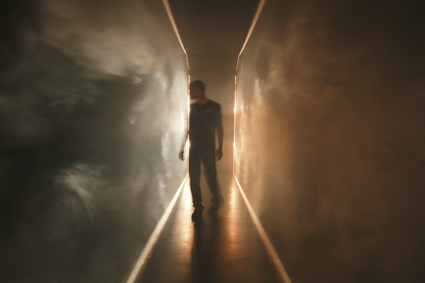
Segue, 2014, installation view, Neil Brandhorst, a PhD student at UNSW: Art & Design
Sydney’s College of Fine Arts, a campus of the University of New South Wales, will take on a new name and new life on September 30 as UNSW Art & Design under the directorship of its Dean, the artist and writer Professor Ross Harley who has been shaping the rebirth of the campus over recent years. Not only will its new buildings be completed but there’ll also be a dedicated public space, its construction, Harley says, “facilitated by Sydney’s Lord Mayor, Clover Moore.
Given the venerable age of the art school, Harley quips, “we’re the newest and the oldest art and design school in Australia.” He’s adamant, “We’re up there with the best and we’re thinking not just nationally but internationally—that’s where we think the next 10 or 20 years for the institution will take us. We want to be best in the world.”
International thinking
I ask what form this international thinking might take. “It’s about a trans-disciplinary approach to the big social, cultural, aesthetic and political problems of our day. Only artists and designers really have a sense of tackling that in the creative spirit we know art is all about. Art and design are at the core of the 21st century. They feed into so many other areas which need the benefit of an aesthetics approach.” Consequently international connections have been made with the likes of ZKM in Karlsruhe, Germany, and with Jeffrey Shaw, Dean of the School of Creative Media at Hong Kong City University. “We’re also working with the GLAM sector—galleries, libraries, archives and museums. We’ve appointed around 20 new academic staff in the last 12 months or so, attracting people we think are really world-class leaders.” Harley offers as an example Sarah Kenderdine, “who is partnering with many museums around the world from the Smithsonian to the V&A to major institutions in Hong Kong and China.
“She works in the area of digital cultural heritage. Sarah’s work is very high tech but it’s also embedded in the most ancient of cultures. For example she’s been working on a project with researchers, social scientists and archaeologists in the Dunhuang Caves in the north of China—the Mogao Grottoes, a series of over 200 caves which are of significant cultural heritage for Buddhism but also for China. The more the caves are visited, the more damage is done to incredible paintings and statuary. Sarah and a team of experts have scanned the caves in incredibly high resolution data that goes beyond the ability of the naked eye to see. Then she’s constructed augmented reality exhibitions where you can explore the caves away from the actual site. The demos of the work she’s been doing are mind-blowing.” Kenderdine, who has set up a laboratory on the campus— iGLAM, for Innovation in Galleries, Libraries, Archives and Museums—is also with Museums Victoria.
Local partnerings
Harley adds, “We’re also putting in place significant partnerships with major cultural organisations in Sydney—MCA, Art Gallery of NSW, Carriageworks, Artspace, Powerhouse and the State Library—formal ongoing relationships where staff from our respective organisations have the ability to work across institutions. We also have particular projects we’re working on, for example we’ll partner Carriageworks on their 24 Frames dance film project. The artists in that program will be able to work with our academics and students and with our facilities. Similarly with Artspace, we’re looking at a program where visiting artists and scholars will reside at the Artspace studios and they’ll have a visiting fellowship with us, teach in our courses and have access to our facilities. I think that it’s in all of our interests to work more collaboratively in the sector.”
The 4-year integrated degree
I ask if the re-naming and the new buildings come with changes to degrees and courses. “We’ve now pretty much totally overhauled all of our degrees. We have four areas where we offer degrees: Fine Art, Media Arts, Design and Curatorial/Art History/Art Theory. In all of those areas we now have a four-year integrated Honours degree where students get training in a research-intensive university but also have work-integrated learning or internships and work experience structured into their third and fourth years. As well in the studio degrees—Design, Fine Art and Media Arts—students share a common first year for half of their courses and then they all come together again in the fourth year.”
As part of a more expansive view of the education of the artist or designer, the school will offer the opportunity for double degrees. “For example, you could be studying Fine Art in which you do one stream or major in Painting and the other one might be in Animation or Visual Effects that comes from another degree. Or you could do Graphic Design and a Media Arts stream and so on. Allowing students to really choose what they want to do has been a big change. And students are voting with their feet.” Harley sees the majority of students undertaking a four-year integrated program, the benefit residing in “students having enough time to really get their practice honed, to work in the industry and to develop research skills.”
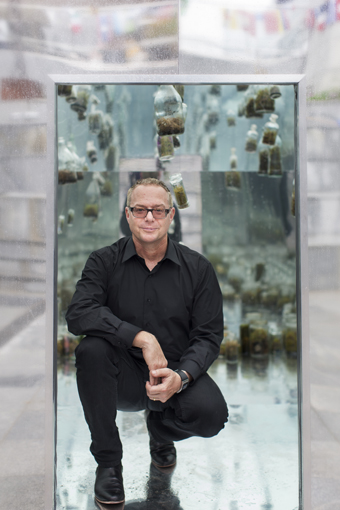
Ross Harley
photo Richard Glover
Ross Harley
Combination opportunities
Even more expansive and opening up opportunities for innovation is “the offer of more dual award or combined degrees, for example Media Arts and Computer Science & Engineering, or Design and Commerce. You can take the BFA and also do the standard BA and major in Politics or Languages or whatever. We were surprised when we looked at the numbers this year: half our commencing students are doing dual award degrees. That’s what they want to do.”
Postgrad: getting to the essence
As for postgraduate studies and research, Art & Design UNSW “offers a postgraduate coursework degree and a two-year postgraduate Masters Degree. If you’ve done an appropriate Honours degree then you get credits for the first year of the Masters and you would complete the degree in one year. Then we have HDR (Higher Degree Research) students who do PhDs and MFAs. [In the US] they’re saying the MFA is the terminal degree, you don’t need a PhD. I think we’ve gone the opposite way, saying actually it’s the PhD that’s required because we know that in this multi- trans- or inter-disciplinary world you need to have research training and qualifications. So we’re doing a lot in the PhD space, particularly in what we call Research-led Practice rather than Practice-based Research. It might seem semantic, and probably is in some regards, but we think your practice can be led by your research. A lot of our students are making work that gets exhibited in all the ways you might expect, or not when it’s more innovative. They also write a thesis that informs that project. These degrees allow candidates to perform their research in a traditional and a non-traditional way so the work that you produce is not just an example of your theory but embodies the very essence of the new knowledge that you’re producing.”
Labs, studios, galleries
When it comes to discussing facilities and resources, Harley’s excitement is palpable: “That’s really the best story of all. We’ve got lots of new studios, laboratories and workshops as well as galleries. UNSW Galleries comprise three new gallery spaces over two floors taking up about 1,000 square metres of museum-grade exhibition space. We intend them to provide a platform for engagement with our research and what characterises the work we do.
“We’ve got a number of new laboratories: the IGLAM Lab, the Creative Robotics Lab, directed by Mari Velonaki, and the 3D Visualisation Aesthetics Lab, directed by John McGee “working on the visualisation of the body from an artist’s perspective. An aesthetic approach to the understanding of the body can be helpful for both patient and medical and health professionals.”
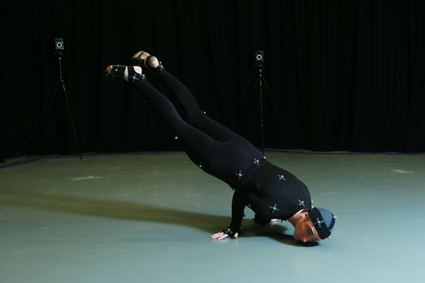
Motion capture session in Black Box, Art & Design UNSW
photo Britta Campion
Motion capture session in Black Box, Art & Design UNSW
Minds and hands
Among the new facilities, are “sound recording studios and brand new state of the art analogue film processing studios—so we have darkrooms and a wet lab. Some people say, ‘Really? Do students need to learn how to do black and white photography and how to do photograms?’ And I say, ‘Yes, I think they do.’ A new course Debra Phillips has put up is called From Photogram to Instagram. Students get to think more deeply about what an image is and how it’s produced, how light works and its relationship to science and chemistry. When you’re in a wet lab it’s all chemistry.” For Harley this corresponds admirably to the UNSW motto Scientia Manu et Mente, “Knowledge through Mind and Hands.” “For us,” he says, “thinking is a form of doing or making and making is a form of thinking. So we’ve got a lot of new maker labs including a new facility with 3D Rapid prototyping machines and soldering bays for working with Arduino, Fidgets and Raspberry Pie devices where you can bring programming and electronics together into a physical 3D maker world. That’s another really big part of the present and the future”.
What’s in a name?
Finally, I ask Harley about the re-naming of the school, which has stirred a modicum of public debate. “’Design’ has never been in the name and while I think the old name was very appropriate in 1989-90 when the art school came into the university, I think things have changed and this is the time for us to say very clearly we’re not a college [in the American sense as sub-university]; we’re part of the university and art and design is what we do. And it’s all kinds of art—media art, experimental art, anti-art, performance art, video art, art history, art theory, art thinking—and all kinds of design: media design, graphic design, environmental design, whatever. Art and Design go together hand in glove. It’s also a combination that has real resonance out in the world.”
UNSW Art & Design indeed resonates with the world: locally and globally, maintaining traditional skills, which now include the likes of photo-processing, side by side and integrated with new ideas, forms and techniques. Ross Harley exudes utter confidence in his ambitions for a wonderfully regenerated school, the oldest and the newest.
UNSW Art & Design [formerly CoFA, College of Fine Arts], Paddington, NSW
RealTime issue #122 Aug-Sept 2014 pg. 6,8
© Keith Gallasch; for permission to reproduce apply to realtime@realtimearts.net
The dust has now settled from the tectonic shifts at the ANU School of Music. For those who did not feel the earthquake from its epicentre in Canberra, the shock arrived on 2 May, 2012, when all positions in the department were declared vacant in an epically mismanaged ‘spill and fill.’ The then-Head of Music Adrian Walter disappeared on leave, before popping up on a Hong Kong news site as the newly-appointed Director of the Hong Kong Academy of Performing Arts.
A sham of a consultation process ensued, during which the National Tertiary Education Union (NTEU) quarrelled idly with the new Pro-Vice-Chancellors, whose wages just happened to equal the projected savings from cuts to the School. The community didn’t come up with the money to stem the job losses and the local orchestra saw the whole shebang as a great opportunity. The only real and clear-headed organisation came from the students, who put on some of the finest protests and concerts that Llewellyn Hall had ever seen to defend an education that they believed to be first-rate. Enter Peter Tregear, a spirited academic and senior administrator (who I’m sure prefers the former title) with all the right credentials, first and foremost of which was his foreignness to the whole situation.
Tregear took the helm in November, 2012, once all the spilling and most of the filling was over. He has proceeded, despite the holes left by a valuable faculty corralled in more prosperous times, to shape the school into its own thing, with its own distinct merits. It is reaching out into the community through educational programs, bringing the community in through a fine micro-brewery setting up shop on the ground floor, expanding its early music area, even reaching up by squeezing into the sixth floor of the building. It has become, as is only appropriate for the music department of our national University, a centre for the study of Indigenous Australian musics.
But my place here is not to evaluate the changes to the School. I am, after all, still a PhD student there, Tregear is my principal supervisor and I intend that he continue to read my thesis drafts. Instead, I’m going to review some of Tregear’s ample public commentary on music education in general, in particular the Platform Paper “Enlightenment or Entitlement?: Rethinking Tertiary Music Education,” published in February by Currency House.
The limits of music advocacy
While Tregear’s definition of the “crisis” in music education is sound and his solution of an “ethical” music education worthwhile in its own right, music advocacy has a limited effect upon the structural problems raised by music departments within corporatised universities. Alongside Tregear’s survivalist rhetoric of the ethical responsibilities of music students to their communities, we need to consider the ethical imperative of music educators to provide an education in music.
The essential parts of the essay are really the first and last chapters. Here Tregear defines the “crisis” in music education and his own solution: a new ethics of personal responsibility. The crisis is twofold: firstly, under the “logic of late-capitalism,” university departments are placed in a state of artificial crisis that leads to perpetual competition for funds (consider the PVCs’ salaries and the music budget), a competition that music education can only lose given the expense of studio teaching. Secondly, internal competition distracts from the “real” problem: that of convincing the broader society of music education’s worth.
Musicians as good citizens
Tregear’s solution is to make students “good citizens” as well as good musicians. They will be exposed to a broader humanities education and coached in critical perspectives so that they can question their role within society and defend their musical values. This socially aware cohort will then go out into the world, trumpeting the value of music far and wide and, the idea goes, fostering a new culture of philanthropy. Bravo to Tregear for advocating cultural leadership, or the spirited and open defence of whatever one takes to be “good music.” Contemporary art music has taken the lead in this regard by finding new and innovative modes of presentation and engaging in brave, didactic programming. I am thinking in particular of Speak Percussion’s new music spectacles, the good vibes of MONA FOMA, Ensemble Offspring’s intimate concerts and the historical surveys of Kupka’s Piano.
Not only is the first part of Tregear’s vision (the fostering of a critical culture within music) worthwhile in its own right, it is achievable with the absolute minimum of fuss and may be said to already exist in some places. Students only need access and some impetus to enrol in existing courses in philosophy, social theory, politics, literature and cultural studies. Musician and academic Michael Hooper points out in his response to Tregear’s essay (published in Platform Paper 39) that his own institution, the University of New South Wales, offers a variety of double degrees with music, as did Adelaide University during my undergraduate degree. Students naturally carry their knowledge across disciplines, but a greater synchronicity between the philosophical and theoretical frameworks taught in other disciplines and those in musicology classes wouldn’t hurt either. But could Tregear’s model solve the crisis? Of this I am extremely doubtful because the feedback loop between the public and our corporatised universities is broken.
The broken loop: the public & the universities
If students are taught that they ought to serve their communities, it is evident that not all university executives share this conviction outside their barest obligations as “service providers.” This was succinctly demonstrated in the case of the ANU School of Music restructure, where there was no initial lack of public support for the School as it stood (short of raising a $60m trust to bankroll it). All that mattered to the university executive was providing education to as many customers as possible at the least possible expense. There is no shortage of music students; they are just an expensive lot. As this will never change, no amount of propaganda will increase support for music education within the institution until the fundamental ideology of the executive changes. Small battles are won and the fault at the middle of Tregear’s essay, where he discourses widely and optimistically on a range of issues central to the ANU situation, is its dialectical playing-down of his advocacy of one-to-one studio teaching. Against the initial wishes of an executive who once justified the cuts to me by saying “some of my friends learn instruments on YouTube,” ANU now offers more studio teaching than any other Australian university.
Philanthropy disengaged
As to philanthropy, it is evident that the corporatised university does not effectively engage it to the common good. Two examples: Canberra’s CityNews.com.au (11 June, 2011) reported the story of arts patron Barbara Blackman and her attempt to spend a “spare million dollars” on an arts-music studio at the ANU. After presenting a pilot sum of $10,000 “and the suggestion of a substantial donation to follow,” she received “a receipt, but [the University] never followed up on her requests for a meeting with the then-vice chancellor, while indicating that she could have no say in the use of any sum she gave.” Not surprisingly, Blackman “signed the biggest full stop you’ve ever seen.”
The second example concerns the more recent $50m gift from Graham Tuckwell, himself a state school alumnus, to fund scholarships intended for “those who were bright, engaged and ‘ready to work hard’, and who may not have had advantaged upbringings” (5 Feb, 2013, canberratimes.com.au). Tuckwell’s gift is to be applauded and emulated. How can one not brim with noble feeling at the intention to help “kids from different states, different cities, different country towns” go to university, taking into account “grades, natural ability, background and drive”? (5 Feb, 2013, news.com.au) The problem is in the implementation. Though the preamble to the award’s selection criteria recognises that “everyone is dealt a different hand in life,” background does not form part of the actual selection criteria. Though public schools are represented in some other states, the Victorian recipients come exclusively from the state’s wealthiest schools (30 July, 2014, tuckwell.anu.edu.au) and 16 of the 24 awards across Australia went to such schools. In his blog, Andrew Norton (22 July, 2014, andrewnorton.net.au) further argues that analysis of the socio-economic data of the successful schools suggests a massive over-representation of the top socio-economic quartile. Within a corporatised university, even philanthropy must be turned away from community service towards growing the prestige of the university’s brand.
Ethical obligations to students
Given the degraded lines of communication from the community to the university, perhaps we should return to the question of just what teachers’ ethical obligations to students are. Hooper agrees with Tregear that Schools of Music have an ethical duty to “not predetermine” students’ careers. By this he means that Schools of Music should provide a rounded education that will stand students in good stead in the broad range of work in which many will inevitably find themselves. Nobody would deny, of course, that this is second to the duty of providing students preparation for a career in music performance, seeing that is principally why they are attending university. Tregear and Hooper are right, students should determine their own career paths. But “not predetermining” a career path is a simple matter of allowing or requiring students to take subjects in other disciplines and should not detract from the business of core music education.
What sort of music education
Which brings us to the question of what sort of music education should be provided. On this issue I could not agree more with Michael Hooper, and indeed I made the same argument in the Arts Education article last year (RT116, p10). That is, that Australian Music Schools need to specialise and students should be encouraged to travel to receive the specialist music training they desire, be it in early music, contemporary music, orchestral playing, popular music and so on. But this requires a cultural awareness that is not often found in Australian school leavers.
The true value of Tregear’s enlightened cohort could be in fostering cultural literacy so that students are capable of determining which rigorous course of study they want to pursue. When they do, high quality and specialised Schools of Music should be there for them.
Peter Tregear, “Enlightenment or Entitlement?: Rethinking tertiary music education,” Platform Papers: Quarterly Essays on the Performing Arts 38, Currency House, 2014
RealTime issue #122 Aug-Sept 2014 pg. 10
© Matthew Lorenzon; for permission to reproduce apply to realtime@realtimearts.net
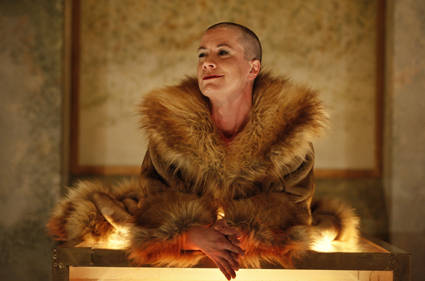
Jane Montgomery Griffiths, Sappho…in 9 Fragments, Malthouse
photo Jeff Busby
Jane Montgomery Griffiths, Sappho…in 9 Fragments, Malthouse
Jane Montgomery Griffiths is a widely experienced, practising actor, a performer of her own work (Sappho…in 9 fragments) and director of plays who writes on acting and is currently editing a volume on space and time in Greek drama. She’s also Head of Section at Monash University’s Centre for Theatre and Performance (CTP), with ambitions to create an enduring bridge between the academy and the theatre world.
I see that the Centre for Theatre and Performance is relatively independent within the university structure.
Yes, we are our own autonomous centre now—no longer part of a school.
That’s almost pre-Dawkins. Presumably with quite a measure of independence?
We have a lot. Obviously we report to the faculty but it is nice to be able to steer the curriculum the way we feel it should be going in the current cultural climate. Since going autonomous, we’ve had a lot of changes over the last 18 months, given university restructuring, but I think we’ve come out the other side; it’s an exciting time for CTP now.
What makes it special, do you think?
We had an independent Bachelor of Performing Arts degree, which was very successful and we had a lot of people applying for it, but because of university restructuring that was disestablished last year. What we have instead is a very vibrant suite of units nestled under the university BA. We have a Theatre Major, which is theoretical with a lot of practical application. We’re also developing a very cutting-edge Performance Minor, which will be investigating—with a lot of industry focus and industry connection—ways of making theatre in the current cultural climate.
The most exciting initiative is that we’re just about to sign a partnership as the major sponsor of Malthouse Theatre. That’s going to make a big difference because it means that our Performance Minor students have access to internships at Malthouse [in] a cultural conversation between Malthouse as a theatre that likes to see itself as an engine for change and us as a department that wants to really explore what the parameters of performance are, not just in the Australian context but globally. This will come into effect from 2015 and it’s really going to bolster the potential for us to engage in the community in a way that perhaps doesn’t often happen in a university context.
And as Head of Department I’m a professional practitioner as well as doing my research and teaching; I’m still out there doing shows. We have a huge number of industry engagements. In our Theatre Major units we have pretty much the best of the best independent theatre-makers coming in to teach. We’re trying to look at both the theory of performance but also the industry practicalities in a way that’s intellectually and theoretically rigorous and also practically very engaged. That’s a big change because we didn’t have the opportunity to do this before.
And how much weight will the Performance Minor actually have in the BA? How much can a student commit to that stream?
Every unit is six points and a traditional major is 48 points and our Performance Minor is 24 points. Everybody will commence the Theatre Major and then those who discover that they really have a passion for the Performance as Research—investigations through practice—can also take the Performance Minor. In effect they have the same suite of educational outcomes as they did in the old Bachelor of Performing Arts but the difference is that they’re now coming in to the Performance Minor really knowing what they want to do and where they want to go. It’s very much honed and targeted as very specific education and training for students who really want to take that next step and go into professional practice.
Do they audition to move to Performance Minor?
No, it’s not an audition. Anybody who has completed the first year of the Theatre Major is welcome to apply for the Performance Minor. I think auditioning has historically put too much weighting on the ability to act. I want to validate people who want to be dramaturgs, stage managers, directors and lighting designers. I trust the students well enough to know that they will only do the Minor if they really want to pursue this and if they’re really passionate.
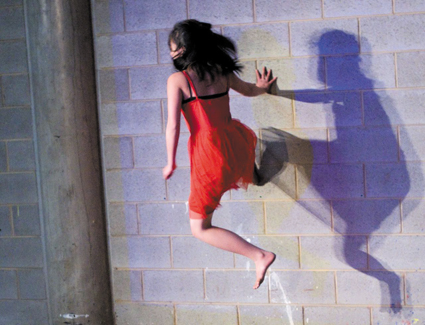
Centre for Theatre and Performance, student
photo David Sheehy
Centre for Theatre and Performance, student
And what about the forms of performance engaged in within your courses?
I think it’s really important that we validate all forms of theatre. We give the students a theoretical and also a practical understanding of everything from very traditional forms of theatre right through to the most avant-garde. For instance, our most popular unit is still on Shakespeare in Performance and I love that. But I also love it, because of the range of teaching staff we have. Students don’t just learn how to speak in iambic pentameter and read John Barton, they also learn how to deconstruct a text. I actually think historically one of the biggest failings that we’ve had is that we’ve put so much weighting on avant-garde experimental performance forgetting that students actually need to learn the nuts and bolts before they can become experimental. So we’re offering units that will give them a real grounding so they know what they’re experimenting from. They know that people were there before them. If they are re-inventing the wheel, at least they’ll know they’re doing it.
What are the possibilities as students are completing the course—do they have Honours and Post-Graduate options?
Our Honours is popular and the university has the largest post-graduate department in the country. What’s attractive for early and especially mid-career practitioners coming back to academia is that we have Practice Research PhDs and Masters. With Practice Research degrees there has been a rather prejudicial view that it’s taking the soft option. You know, instead of writing a 100,000-word thesis, you make a work and you write an exegesis. Honest to God, I think if you’re applying practice research rigorously, it’s so much harder to do that than to write a thesis.
What’s terrific is when the post-grads and the undergrads interact as they did last year when [autobiographical, queer performer] Tim Miller came over from the US to do a residency with us. That was fantastic because a range of experiences and academic backgrounds came together to create a collaborative piece. That’s what we’re aiming for—to create a real cohort from first year undergraduates right the way up to final year PhD students.
One of my briefs, as well, is to bring in practitioners to give free workshops to early and emerging career artists. So we’ve brought over Robin Arthur from Forced Entertainment. He’s giving a week of free workshops to about 15 or so of the independent theatre-makers from outside the university. CTP and the Monash Academy are sponsoring it. And it’s part of our brief to say, in a way, universities need to be the new patrons of the arts. If we have the funding to help emerging artists and companies develop, then we need to do that.
What topics are postgraduates tackling?
A huge variety! A BodyWeather artist investigating the phenomenology of the body in site-specific performance. A Sri Lankan director re-interpreting ancient forms of Sri Lankan tragedy for a contemporary Sri Lankan-Melbournian audience. A director looking at film/stage adaptation and a well-known artist working on how you can portray ‘Strine’ and Australian patriotism through musical theatre. It’s a very broad church that we have.
And who are some of your staff members and sessional teachers?
On the staff we have Dr Stuart Grant who is a phenomenologist and also the lead singer in a punk/noise band [The Primitive Calculators]—Andrew Bolt got wind of this earlier this year and Bolted him. There’s Felix Nobis who’s a professional actor and award-winning poet who also wrote the very well received play Boy out of the Country, which was on at 45 Downstairs last year. Fiona Gregory is a Shakespeare and Ibsen scholar. And in terms of sessionals, last year teaching directing we had Adena Jacobs, Nadia Tass, Pamela Rabe and Daniel Schlusser. This coming semester we have Emma Valente [The Rabble], Nicola Gunn, Matt Bebbington and Angus Cerini.
How are you going with the overlapping careers?
It’s a bit bonkers to be honest. It depends what you’re doing. When I’m writing a play that’s okay, but for instance, doing something like performing in The Rabble’s Frankenstein, I just adore The Rabble and love working with them, but it doesn’t ‘arf take it out of you physically! Doing a full day at Monash and then going off to be a naked monster with 29 bosoms at night was a bit tricky.
I’m a jobbing actress who happens to be an academic too but I do genuinely think that with the vision to try to make CTP into a place of engagement, not just for our students but also with the independent theatre community—also the mainstream stages such as Malthouse—then we’re not just surviving but we’re going to thrive and be a really innovative and exciting centre.
Centre for Theatre and Performance, Monash University, Clayton Campus, Melbourne
RealTime issue #122 Aug-Sept 2014 pg. 12
© Keith Gallasch; for permission to reproduce apply to realtime@realtimearts.net
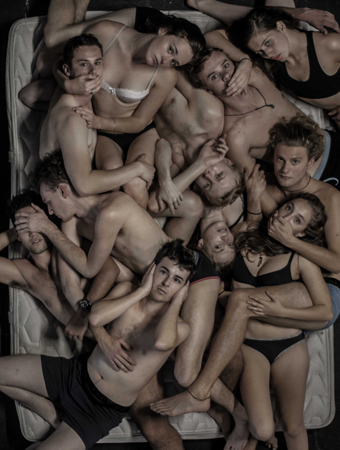
VCA Company 2014 (1st, 2nd & 3rd Year Production Students), UN/clean, directed by Noel Jordan, part of ENUF is Enough*
photo Giulio Tami
VCA Company 2014 (1st, 2nd & 3rd Year Production Students), UN/clean, directed by Noel Jordan, part of ENUF is Enough*
The Victorian College of the Arts has a long history of influential teaching in theatre yielding many professional actors, directors and other theatre artists, including the animateur, a highly motivated creator able to work across discipline boundaries and bring diverse practitioners together to generate all kinds of work, including new forms. Although the specific diploma course that nurtured this role will no longer exist at the end of this year, the principle strongly persists in VCA’s new degree offerings.
When I ask Robert Walton, Head of Undergraduate Studies in Theatre, what is distinctive about the school’s three-year undergraduate program, he pinpoints with clarity “a kinaesthetic approach to acting through the actor’s body drawing on various techniques,” “a focus on what is already strong in the VCA” and “looking to Melbourne as the inspiration for our course with its vital and exciting theatre community—acting, writing, devising and initiating projects and seeing them right through to production.”
The actor as originator
Walton says, “We’re looking at an expanded vision of acting. We don’t make a distinction between interpretative and generative acting; instead we aim to create a well-rounded artist who is an actor and can contribute to the most exciting work in theatre, film and emerging media possible. From the beginning we develop each individual as an author and originator of work as well as an interpreter.”
Walton describes a key part of this process. “We work in adaptation a lot; some of our graduates are famous for it. The first part of the students’ second year first semester is dedicated to Chekhov, to learning an approach which ends in a presentation of a Chekhov play. Here students continue a deep approach to text, exploring how fantastic this language is and learning traditional naturalism. In the second part of the semester we ask the students to demonstrate their understanding in a variety of ways, one of which is adapting the work into a mediated performance piece—they might make a short film to delve into the characters in the text—an adaptation with the Master of Writing students in which they write and also perform. Then they make a small ensemble response—creating a new piece based on their experience of Chekhov.” So, says Walton, the division between interpretative acting and devising is replaced by a spectrum.
Ensemble strength
This approach, Walton emphasizes, underlines the school’s commitment to ensemble practice, “which is the context in which students learn and we choose those we think will be good ensemble members for entry into the course. We establish a strong group, give it power and ways to look after itself with agency—that’s where students learn, even more than from the amazing teachers we have. It shapes how they see each other and allow each other to get better and better and become brilliant actors.”
FR!SK
In third year, says Walton, “we respond to the ensemble in terms of what they need most.” He describes a new component of the course as a response to Melbourne in the form of a festival of new work titled FR!SK. “In the first week of third year the students take part in an intensive pitch development project where leaders of local major institutions talk about what they’re looking for in new work and offer students advice. This year we had Emily Sexton, director of Next Wave, Sarah Neal, executive producer at Malthouse, Daniel Clark, Creative Producer Theatreworks and Angharad Wynne Jones, Creative Producer Arts House and two regional artistic directors. The students then have a week to prepare a pitch for a work to the same people; eight works are selected, developed (while other course work goes on: performances in contemporary plays, film scenes and screen tests) and then FR!SK is performed at the end of September. After third year is completed FR!SK is then taken on a regional tour funded by Arts Victoria. The works range from solos and group works to multimedia pieces—whatever is most urgent to the students. In this way they graduate with works to show in festivals.”
Walton adds that third years also work on 12 new plays in conjunction with the Master of Writing for Performance degree course which is led by playwright Raimondo Cortese. This provides “further opportunities for integration, with those you might work with in the future. We are creating a generation across disciplines with a shared vocabulary and their own distinctive, creative personalities.”
Mastering directing and dramaturgy
A buoyant Alyson Campbell, Head of Graduate Studies, tells me “this is the first time I’ve been able to say publicly that we’re changing our graduate offerings completely. The long running Postgraduate Diploma in Performance Creation for directors and animateurs is ending this year and we’re introducing two new Masters courses—a two-year course work Masters in Directing for Performance and a Masters in Dramaturgy.” She says of the latter that it is unique in Australia: “I was attracted to the VCA because of the possibility of introducing this course so I’m really thrilled.”
Like Walton, Campbell is determined to maintain the VCA’s tradition of interdisciplinarity. New Masters of Design for Performance and Dance will offer great collaborative opportunities within the school. She says the new Masters in Directing for Performance will offer “a very expanded notion of directing, from classical texts to performance creation from various starting points, nurturing the autonomous, free thinking, self-driven creative artist distinctive to the VCA.”
I ask why “performance” instead of “theatre.” Campbell replies, “It’s deliberately so; performance is a broad ambit and we already have Raimondo Cortese running the Masters in Writing for Performance, not just playwriting.” This common nomenclature resonates with the variety of forms delineated by Robert Walton above. “The two-year course in directing will allow people to get a lot of intensive training and research skills and, in their first year, they can also choose electives to help them select individual pathways. A very self-directed second year follows, leading to an independent project that might be a solo piece or directing undergrads in a text-based work as part of FR!SK.”
Discussing the inspiration for arguing for the Masters in Dramaturgy degree, Campbell tells me that she taught “Dramaturgy and Live Performance” at Melbourne University with Peter Eckersall (now at City University New York and co-chief investigator for an international research project titled New Media Dramaturgy). and then taught it at Queen’s University Belfast. When she came to Australia to do her PhD she felt that Melbourne was a “great epicentre of dramaturgical thinking.” As part of Paul Monaghan’s Pedagogy Working Group the idea of “a dramaturgical consciousness” turned to a discussion of the possibility of a “pedagogy of dramaturgy.”
The prospect of Masters directors, choreographers, designers and writers coming together and working with undergraduate performers evokes for Campbell “an ecology of overlapping skills, mutual support and an egalitarian spirit” in which something may well be learned about the teaching of dramaturgy. Campbell feels “this is an exciting time in which we are doing something very important.”
Victorian College of the Arts, University of Melbourne, vca.unimelb.edu.au
*ENUF is Enough, two major new works based on the stories of Victorians living with HIV and AIDS, in collaboration with Living Positive Victoria’s ENUF campaign and coinciding with the 20th International AIDS Conference in Melbourne
RealTime issue #122 Aug-Sept 2014 pg. 14
© Keith Gallasch; for permission to reproduce apply to realtime@realtimearts.net
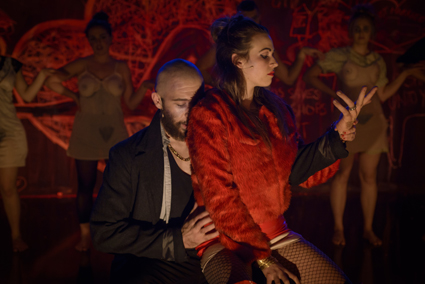
David Geddes, Caetlyn Collins, The Threepenny Opera, 2013, director Cameron Goodall, Adelaide College of the Arts (ACarts)
photo Sofia Calado
David Geddes, Caetlyn Collins, The Threepenny Opera, 2013, director Cameron Goodall, Adelaide College of the Arts (ACarts)
After 30 years of acting, directing, teaching (including NIDA, VCA, UWS, The Actor’s Centre and conducting his own acting courses), Steve Matthews has taken on the position of Principal Lecturer, Performing Arts, at TAFE SA’s Adelaide College of the Arts. He’s been a mere six months in this position but had long admired the college: “It’s a $60m purpose-built performing and visual arts centre. ‘Wow,’ I thought, this is the country’s best kept secret.” It’s as well-equipped as NIDA and the VCA, he says, and offers students advantages less available in larger cities.
He and his staff emphasise not just the facilities, but also the industry readiness of its graduates, “The College has first class facilities reflecting industry standards. There are two very good theatres plus studio theatres and dance studios. We work on the production house model similar to NIDA and WAAPA. There are four 10-week terms, the first 5-6 weeks of which are studio-based, plus lectures and tutorials and then we move into production mode. We do up to 14 theatre and dance productions a year; tech, design and stage management students all work on these. It’s very practical, hands-on, three-year intensive training.”
Other advantages centre on the College’s home being a festival city, ideal for placement of students as interns in the performing arts. There’s a very high demand for technical staff and opportunities for emerging actors and dancers, given a close relationship between the college and the State Theatre and other companies. Adelaide is also a very liveable city and far less expensive for students than Sydney and Melbourne. Matthews is determined “to put this well kept secret on the map.” Certainly the industry is aware of the College but it warrants more attention, national and international, insists Matthews, eager to also attract overseas students.
Acting
Terence Crawford, Head of Acting and an actor himself (most recently in the STCSA’s The Seagull) and also director, playwright and author of two books on acting, is passionate about teaching. He expresses wariness about the ways acting schools often seek to make students creatively autonomous: “After years of running courses here and overseas and hearing and believing the rhetoric that we should teach students to make work. I’ve really tried to take responsibility for it. Schools err by saying we’ll get some theatre-makers in and they’ll lead you through a process to make your own work: student-devised work is often in fact expert-devised work, and at the other end of the scale it’s done for cost efficiency—‘Here’s the keys to the theatre, go and make it.’
“We asked, what might we thread through the course so that in third year students are fully ready to make their own work. We have 3D, the Third Year Devised Exercise, with students working without directors and devising short pieces, but for two years they know that’s going to be the culmination of their course and on the way they’ve learnt a lot about writing. I learnt a lot about acting through being a playwright and have brought into courses a kind of reversal of the classic American writing model where writers have to get up and act their own scripts to know what it’s like to be an actor. I get actors to write. History tells us that quite a few of the great writers were actors. It’s a way to attack a study of dramaturgy and if nothing else, they learn how bloody hard it is to write a couple of pages of dialogue. And in second year, there’s a director-led devised project. The students have been prepared and their ideas pitched by the time they get to third year. The outcomes are remarkable.”
The practicing professional artists the students work with in their second year “include the young constantly working Adelaide playwrights Emily Steel and Nicki Bloom; Paulo Castro, a Portuguese-Australian director with an international reputation; Jo Stone the other half of Stone-Castro who has performed with les ballets C de la B; and Chris Drummond, the Artistic Director of Brink and a regular contributor to the course who has his own particular dramaturgical approach.”
Crawford states with conviction, “we teach to empower and liberate rather than tick boxes. I also think there’s a particular value in being taught by someone who has published as much as I have [including Dimensions of Acting, An Australian Approach, Currency Press, 2012]: you know what you’ll be getting.”
Another strength, he says, is that the College “is so closely linked with the industry with a closer relationship with the State Company than any school could hope for. They often rehearse in our building, I perform with them and their Artistic Director Geordie Brookman has directed here. We’re a sibling institution offering great opportunities for work for our best graduates. Of course, we aim for our students to have national careers, but it’s best to stay in Adelaide for a couple of years and get some runs on the board. Graduate Kate Cheel has played Irina in The Three Sisters, Laura in The Glass Menagerie and Thea in Hedda Gabler, all for STCSA.” Other graduates performed in STCSA’s Vere which toured to Sydney Theatre Company as a co-production.
Crawford says, “TAFE’s god is industry while a university’s god is the very notion of the academy. That means we can justify the hours of studio work that we deliver because they are the hours called for by the industry. It’s about employability.”
Dance
Lecturer in Dance, dancer and choreographer Peter Sheedy, whose extensive career includes performing with ADT, Dance North, Human Veins and Taipei Crossover, likewise points to the College’s courses “being born out of Vocational and Educational Training [VET, government certificated]. A lot of hours are dedicated to the actual training of the dancer; we’re still embedded in studio practice with a healthy number of hours even though now the course is a Bachelor of Creative Arts Dance degree offered by Flinders University, run in conjunction with TAFE SA.
“All our teachers have a minimum seven years in the industry and choreographers come in to work with our students on productions. We function like a production house, all the subjects are tied to that. We diversify from pure or abstract dance forms through to theatre-based work where you’ll be handed a script towards building your own physical theatre forms. Students perform at the Fringe Festival in their final year and there are secondments with companies in direct correlation with the industry. It’s a lot of work.”
After the first year’s relatively informal Foundation Performance course, there are five major seasons in second and third year shown publicly as well as students developing their own work. Guest choreographers include Daniel Jaber, the new artistic director of Leigh Warren and Dancers, Jo Stone, Larissa MacGowan (ex-ADT).” Contemporary dance is taught by Sheedy and Lisa Heaven, classical by Sally Collard-Gentle (Sheedy comments, “we are a contemporary course but ballet is included for discipline and technique”) and sessional teachers include Rebecca Jones (Leigh Warren and Dancers) and Kylie Nadine Williams (ADT). The many successful graduates include “Chris Aubrey in Sydney Dance Company, Tom Greenfield and Jessie Oshodi, who have worked with Dance North and Oshodi’s now working with Shaun Parker & Company which another graduate, Lewis Rankin, joined for a European and Middle Eastern tour.
Technical production
Jeanne Hurrell, an experienced theatre technician, writer for the national entertainment technology magazine CX and Lecturer in Sound and Technical Management at SA College of the Arts, lists its extensive range of Diplomas in Live Production, Theatre and Events, Set and Scenery Construction, Costume for Performance, Advanced Diploma in Stage Management and Advanced Diploma in Design. “Students design and manufacture sets, props and costumes, install and operate complex staging, lighting and sound and stage manage eight fully-resourced public productions for our Acting and Dance students each year…guest directors and choreographers expose our students to the high standards expected in the profession.”
Hurrell writes that a typical successful technical production graduate is Lachlan Turner, who is working with Australian Dance Theatre on Multiverse (see review p38). “The production relies on high-end 3D technology. As a student, Lachlan had spent six weeks seconded to ADT’s Production Manager, Paul Cowley—a graduate of the technical course at AC Arts’ predecessor, the Centre for Performing Arts. Paul takes AC Arts technical students for work placements because he knows that our training gives students experience with the latest technologies and teaches them how to adapt and develop technology to support artistic efforts. Lachlan was part of the small technical production team that accompanied ADT’s recent European tour.
“Graduates are taken up by the Adelaide Festival Centre, Adelaide Convention Centre, Adelaide Festival, Fringe Festival and the technical production companies servicing South Australian major events and festivals. Many students start work with these organisations while still studying.”
Sometimes referred to as “TAFE SA’s jewel in the crown,” Adelaide College of the Arts is “a well kept secret” no longer, with the institution eager to promote its successes and offer the kinds of intensive courses that engender students who are not simply industry ready, but confidently creative.
Adelaide College of the Arts Open Day, 10am-3pm, Sunday 17 August, Adelaide College of Arts TAFE SA, tafesa.edu.au/adelaide-college-of-the-arts
RealTime issue #122 Aug-Sept 2014 pg. 16
© Keith Gallasch; for permission to reproduce apply to realtime@realtimearts.net
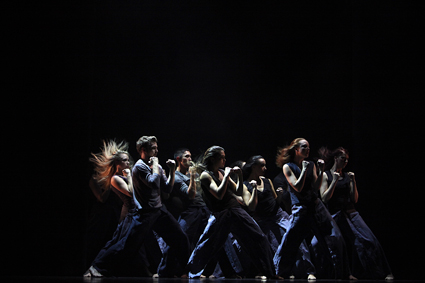
Twelve Ascensions, 2013, featuring Dance students from Creative Industries Faculty, QUT
photo Fiona Cullen
Twelve Ascensions, 2013, featuring Dance students from Creative Industries Faculty, QUT
In June-July, RealTime approached tertiary teachers of performance, acting, dance, technical production and design diploma and degree courses across Australia. Our thanks go to those who participated. To those who we missed, who were on leave between semesters, we hope to catch up with you in due course. As for the proliferating commercial drama school sector we’ll address this in a forthcoming edition of RealTime.
The survey revealed signs of change, some adaptive as budgets tighten, but most made with a sense of grasping the present and looking to the future. Schools are re-writing degree courses; creating new degrees; increasingly engaging directly with professional theatre and dance companies; increasing training time spent on designing, directing and acting for screen and film; and running with expanded notions of performance that have evolved over recent decades—just look at the variable use of ‘performance’ and ‘theatre’ in faculty, degree and course titles. The more performance opens out, the more possibilities for new forms of creativity and unanticipated careers.
There is also growing competitiveness, sometimes expressed bluntly on these pages, for and against training without rigorous academic demands; issues relating to class sizes and hours; commercial versus artistic imperatives; and just what is meant by training for autonomy.
Potential students browsing these offerings will be attracted to the prospect of commitment to developing a single expertise while others will see in more open-ended courses a host of often unexpected career opportunities. The range of courses and locations, not all of them in big cities, offer an incredible diversity of experiences. All emphasise teamwork, inventiveness, creative collaboration and relationships that extend into careers. You’ll see the same focus in our articles on Monash University, VCA and the Adelaide College of Arts on previous pages.
Ken Boucher, Director, National Theatre Drama School
Located?in St Kilda, Melbourne the school offers a three-year full-time Advanced Diploma in Acting, which is nationally accredited and VET registered. Ken Boucher, a widely experienced theatre director, writes, “The course aims to prepare industry-ready graduates with skills in live and recorded performance or as performance-makers and producers.” Staff are all active in the industry and “the School’s alumni includes well-known names such as Kat Stewart, Brett Tucker, Richard Cawthorne, Lawrence Mooney and Rick Davies.”
Boucher is adamant that “at a time when higher education providers are increasingly deserting undergraduate actor-training and/or massively increasing class sizes in the courses that do remain, we place strict limits on our intake (16 in the first year) in order that each student is given maximum support, encouragement and assistance….In their final year students have the opportunity to present their screen work through a professionally produced and nationally circulated showreel and their live performance skills via devised performance and a showcase presentation to industry.” Sessional teachers come from the industry and “provide great contacts for students.”
Associate Professor Kim Durban, Arts Academy Federation University, Ballarat
Durban, a VCA graduate who has directed for major companies, emphasises the care the Arts Academy has for its students and the praise it receives from graduates: “We work as a team, we aim to inspire and we succeed. I am passionate about ensuring we have great guest artists, strong contact hours and screen acting as part of the program.”
Students engage directly in cultural events in Ballarat and graduates have “created companies such as [the all-male comedy troupe] Aunty Donna who this year have been invited to present at Gilded Balloon in Edinburgh.” The Academy’s Professional Practice course, writes Durban, “is firmly based on survival skills. Acting graduates know that they will be responsible for creating their own success beyond the Industry Showcase.”
Dr Erin Brannigan, Lecturer, Dance Studies, UNSW
The distinctiveness of Dance Studies at UNSW, writes Erin Brannigan, co-editor of Bodies of Thought, 12 Australian Choreographers (RealTime-Wakefield Press, 2014) and Dancefilm: Choreography and the Moving Image (New York: Oxford University Press, 2010) comes in the form of “three broad areas of study, Thinking, Writing and Making, linked by the key terms of corporeality and movement.” The breadth and depth of the approach makes the course ideal for producing “dance artists, writers, researchers, educators and arts workers ready to enter the performing arts industry and secondary and tertiary educational institutions.”
While Thinking covers “the history, theory and analysis of dance in diverse cultural contexts, locating dance within a larger ecology of related national and international practices” and interdisciplinarity in current practice and thinking. Writing encourages students “to develop a writing practice alongside their creative or theoretical interest in dance, and to explore the various relationships between writing and dancing.” Making involves movement practices and techniques and acknowledges the role of studio-based learning.”
Dance Studies at UNSW, writes Brannigan, “has strong ties with local industry through teaching staff and professional residencies, and is aligned with the existing ecology of dance practice in NSW with a focus on self-authored movement research, offering clear pathways to higher research in Creative Practice and Dance Theory.”
Rosalba Clemente, Head of Acting, Drama Centre, Flinders University
Actor (most recently in the State Theatre Company of SA’s The Seagull), director and former STCSA Artistic Director, Clemente singles out “learning driven by a strong core pool of arts practitioners and theorists and supplemented by excellent outside practitioners in both classes and production blocks; engaged industry partnerships with student participation including industry workshops; and student exposure to more than one methodology [with the] opportunity to apply diverse processes over at least nine diverse productions in live performance and film over four years as well as class work.”
Creative Development of new work is experienced with outside writers and directors (at present Philip Kavanagh and Nescha Jelk). Clemente rates highly the opportunity to work in “a strong artistic community—artistically, politically and socially aware—with an emphasis on how to work, not just what to make. The aim is “actively encouraging the protean artist: an actor/director/writer/maker/cultural leader/producer [with the] penetrative discipline of the thoroughbred artist. The Centre has yielded diverse talents such as Tim Maddock, Xavier Samuel, Sara West, Sam Haren, Amber McMahon, Alirio Zavarce, Cath McKinnon, Geordie Brookman, Catherine Fitzgerald, Caleb Lewis, Melissa Reeves and Benedict Andrews.”
Clare Grant, Lecturer in Performance, Theatre and Performance Studies UNSW, School of the Arts and Media
In tune with contemporary theatre, performance and live art practices, lecturer and performer (most recently in My Darling Patricia’s The Piper), Clare Grant writes that Theatre and Performance Studies (TPS) offers “a mix of theoretical and practical experiences in the study and making of theatre, encompassing a culturally broad definition of performance.” The integrated courses span cultural theory, Australian drama and theatre, acting and performing theory, solo and group making and writing processes, multimedia practices, the classic repertoire and a range of 20th century European performance practices.”
Grant singles out “the unique-in-Australia opportunity to experiment with contemporary theory and practice with the support of the Creative Practice Lab in the Io Myers Studio and the capacity to develop fundamental performance skills.” Graduates enter careers as diverse as performance making, marketing, arts administration, teaching, academia and event management.”
As well, TPS offers study at Honours and Postgraduate levels in theoretical and practical areas of study with a number of recent graduates winning prizes for research and performance writing while staff members are working on major national and international research projects. TPS has an impressive list of graduates working in a variety of roles including RealTime writer, former Online Producer and academic Caroline Wake; writer, reviewer Bryoni Trezise, Lecturer in the UNSW School of the Arts and Media; Frances Barrett of Brown Council; Jessica Bellamy, Rodney Seaborn Playwrights Award, 2011; Emily O’Connor of Hissy Fit; from post, Mish Grigor and Zoe Coombs Marr (the latter also Philip Parsons Fellowship for Emerging Playwrights, 2011); Anthea Williams, Literary Manager Belvoir St; performer Janie Gibson, MA Manchester University; Teik Kim Pok, performer, RealTime reviewer, Outreach Co-ordinator Playwriting Australia; Grant Moxom, residency Blast Theory, 2012; and Bernice Ong, freelance artist, technician, curator, Singapore.
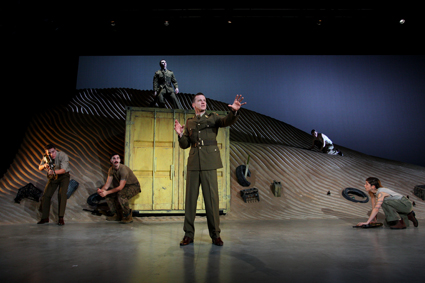
NIDA students perform Stephen Sewell’s Kandahar Gate, 2014. Stage design by NIDA Design students Charles Davis (set), Emma Vine (costume)
photo Lisa Williams
NIDA students perform Stephen Sewell’s Kandahar Gate, 2014. Stage design by NIDA Design students Charles Davis (set), Emma Vine (costume)
Michael Scott-Mitchell, Head of Design for Performance, Director of Undergraduate Studies, NIDA
A leading Australian theatre and opera designer (including the State Opera of South Australia’s Ring Cycle, 2004) and himself a NIDA graduate, Mitchell is thoughtful: “The essence comes down to the simple fact that a conservatoire based training is to be cherished in an institution where you get such a high level and detail of training with a pretty remarkable staff-student ratio. I take eight students handpicked from 60-70 around the country each year. This is done deliberately to ensure they have the best possible training but also that there’s a place for them in the industry when they leave the building. I see each candidate for an hour. In some ways I’m casting because they have to live in an intense pressure cooker for three years while doing undergraduate training and 15 months for the MFA. I want to know how this person thinks. How does their imagination relate to their perception of the world and can I help them? It’s intimate training and I have to think about not only the eight individuals but how they’ll work together and deal with the pressures of being in a studio—it’s beneficial but there are times when things fracture.”
As for arriving with drafting and artistic skills, Scott-Mitchell says, “I’m not obsessed with them walking into the audition with a fabulous model—which they have to do for their application. We’re good at training in the basic communication skills in drawing, documentation, freehand drawing and model-making. I can’t make someone a fabulous designer. I can find people with the right kind of ingredients in terms of their talent and then give them the tools to express themselves well. They do need to have clocked that they are going into something where they’ll rely on people around them to create an artwork, a very different experience from working alone.
“In the new Bachelor of Fine Arts [BFA], the first year is broadly skills development and design exercises of increasing complexity in the studio and they also get to work on two productions building and crewing, so they see how they fit in the process. They’re attached to the designer of the production essentially as assistants.
“The second year is almost entirely a studio year. I wanted them to have a longer theoretical exploration and, importantly, it’s the year they start working with the student directors. For example, they used to develop an opera project first, which seemed slightly insane [LAUGHS] so I moved that to the end of the year and they start instead on smaller works. Egil [Kiptse, Head of Directing] and I have spent the last six years trying to craft that relationship building process, starting with small exercises and taking the students to a festival—during the day we do quick exercises, then we see a show, meet the next day and discuss it. The second years also crew the third year designers who are making films.
“In third year almost everything has a practical outcome: a short film, a major exhibition at the end of the year, designing the directors’ graduation productions, so that relationship building comes to fruition. They also create six JJJ video clips each year. There’s been an increase in screen design to six to eight months across three years.”
Scott-Mitchell is particularly pleased with the introduction of lighting design into the BFA [Design for Performance] for the first time. “In first year lighting design students will do their course with the set and costume designers who will also have lighting training, which also has never been done before. In second year their training is ramped up but they’ll keep intersecting with the projects other designers are doing.”
Forming enduring bonds between directors and designers is important, says Scott-Mitchell: “Design students work with both second and third year directors, doubling their opportunities to form long-term partnerships from six or seven to 12 or 14.”
Associate Professor Helena Grehan, School of Arts, Murdoch University
Dr Helena Grehan, writer and editor (co-editor with Peter Eckersall of ‘We’re people who do shows,’ Back to Back Theatre: Performance, Politics, Visibility, Performance Research Books, 2013, RT121, p38) describes the Major in Theatre and Drama in Murdoch’s BA as designed to provide students with a broad range of skills and experiences in the area of theatre, drama and performance studies. Students are trained in acting, directing, design and script development and they have the opportunity to work as part of a large team in their third year on a major graduating production. Each student is exposed to all areas of production so that they have skills in the running of a show as well as in being part of an ensemble.”
Guest professionals include performance writer and novelist Josephine Wilson who is coordinating the Performance and Creative Arts unit, “working with students on both the theoretical and analytical skills needed to read and respond to creative work as well as in devising. Zoe Atkinson, an internationally recognised set and costume designer who designed fellow WA artist Matthew Lutton’s production of Wagner’s The Flying Dutchman for Opera NZ in 2013, will work with second and third year students in the Design unit.” Grehan adds, “in recent years students have had the opportunity to tour to Singapore and/or Malaysia with a troupe from our Childrens’ Theatre unit and this has given them valuable opportunities for cultural and artistic exchange and team building skills.” As well, students majoring in theatre also participate in the five or so student theatre companies on campus, operating at graduate and undergraduate level.
Grehan writes, “There is strong sense of belonging and pride amongst the students in Theatre and Drama Studies and they are very supportive of one another.” Graduates have gained places as actors, composers, designers and crew members in theatre companies in Australia and Malaysia, in Drama Departments in Malaysia and Singapore as well as in the primary and secondary education sector in Australia.”
Dr Julie-Anne Long, Lecturer in Dance & Performance Studies, Macquarie University
Lecturer, dancer, choreographer and a key figure in the NSW dance scene, Julie-Anne Long rates the absence of auditions for the dance course at Macquarie University as distinctive. However, although no dance experience is required, “many students have extensive dance training in ballet, tap, jazz and contemporary. Others may be hip-hop dancers or have experience in cultural dance forms. Plus there are those who have an interest in dance alongside another art form, say music or film.”
The diversity of dance origins is reflected, says Long, in the Department of Media, Music, Communication and Cultural Studies (MCCS), the largest department within the Faculty of Arts, “offering unique cross-inter-multi-disciplinary opportunities for students.” This presents opportunities for students to combine dance practices and creative processes with screen and digital media production skills. Long also singles out double majors or double degrees, partnering say Education or Law or Commerce with Dance as being attractive to students. “We encourage students to ask what dance can offer other fields and how they can apply embodied principles, choreographic skills and collaborative practices to other world applications. Dance is therefore addressed in everyday, cultural and social contexts and students are encouraged to generate their own directions and creative possibilities alongside workshops in contemporary dance techniques, choreographic performance, music and theatre, as well as experience with intermedia production.”
Tim Maddock, Program Convenor, Performance and Theatre School of Arts, English and Media, University of Wollongong
A graduate of Flinders University, Adelaide, Maddock was a founding member of the Red Shed Theatre Company, directed for Brink Productions and subsequently for Malthouse, Griffin and Sydney Theatre Company. He states with conviction, “We develop students’ whole cultural and aesthetic awareness—only university courses can deliver this. Rather than being a skills or entertainment based course we’re constantly contextualising everything we do in terms of historical and contemporary practice.”
The Bachelor of Performance and Bachelor of Creative Arts [BCA] Theatre degree students share an identical foundation year developing “voice, acting, movement and singing skills intensively, two hours each a week. They do stagecraft which introduces them to the basic languages of the theatre, playing with the components and experimenting…and getting them out of some bad practices they might have picked up.”
The BCA Theatre degree equips students with skills in a broad range of performance areas involving performance skills, stagecraft, stage management, technical production, dramaturgy, history and theory and other possible areas of study including art history, creative writing, design theory, media arts, graphic design or technical theatre. The Bachelor of Performance, which requires audition, is “an intensive, specialist course that develops students as self-reliant, highly-skilled performing artists through a strong, practice-based program…with an emphasis on collaboration and ensemble practice”(website).
Bachelor of Performance students engage in four major productions across their course “and switched-on students drive their own productions in the break.” Current works include Tim Crouch’s Nothing to See Here involving visual arts and other students, and an installation based work. Several Honours students develop work each year in which other students are cast. The overall output, says Maddock, is prodigious; a technical production student itemised on YouTube 44 productions she had been involved in across her course.
Students study dramaturgy with Dr Margaret Hamilton (Transfigured Stages: Major Practitioners & Theatre Aesthetics in Australia; Rodopi 2011), contemporary Australian Theatre, contemporary theatre practices (Robert Wilson et al) and Theatre History.
Maddock says that Wollongong is a lovely campus and that students appreciate being in a strong cultural cohort, educate each other and establish long-lasting relationships as evidenced by the emergence of successful performance ensembles Team MESS and Appelspiel and writer-director Mark Rogers’ home-based Marrickville Woodcourt Art Theatre. “We make units of people who will go out and create; we’re not an industry sausage machine.” Adding to the cultural intensity at UOW is a strong contingent of postgraduate researchers including Nikki Heywood, Deborah Pollard (RT120, p40) and Nigel Kellaway.
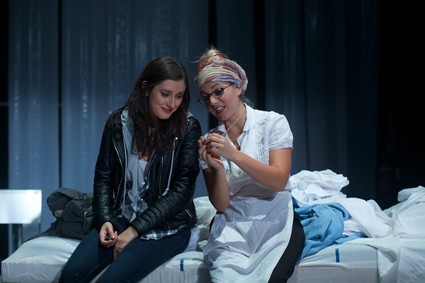
Sophie Don, Sophia Stratton, Mnemonic, QUT
photo Fiona Cullen
Sophie Don, Sophia Stratton, Mnemonic, QUT
Sandra Gattenhof, Head of Drama, School of Media, Entertainment, Creative Arts, Drama, Creative Industries, QUT
Associate Professor Sandra Gattenhof, a specialist in drama/arts in schools and communities, postdramatic theatre and contemporary performance for children and young people, cites “a benchmarking survey in 2009 with other Australian universities that offer similar degrees; at that time and still, we are the largest drama department and the only one within a university that offers acting, tech production and the generalist degree in drama. Others offer one or two but not all three.”
The BFA Acting degree requires interview and audition, Technical an interview and Drama the appropriate tertiary entrance score. Drama students, who receive a strong theoretical and academic grounding can do a one year postgrad course to allow them to become drama teachers in schools.
In terms of annual student course numbers, Gattenhoff says there are 16 in Acting, 25 in Technical and around 85 in Drama. She points out that Acting and Technical students do not work to the university semester schedule once in second and third year because they are constantly in production daily and many evenings. “We mimic life-like experiences but have six-week rehearsal periods, a luxury for guest directors, but vital for student training.”
Gattenhoff is thrilled that the faculty is moving into a new building “which will provide purpose built facilities for the first time—rehearsal rooms and workshop spaces on Kelvin Grove Road opposite La Boite Theatre and highly visible to the public.” She believes, “we are the only drama faculty that has had any kind of new building in the last 10 years. All the surfaces are digital skinned and all rooms are sound-separated. It’s a 21st century facility.”
A new and distinctive feature appears in the re-written acting course for third year students: “There are units on entrepreneurship—how to create your own business and how to market yourself so that you’re not just at the mercy of agents. This is in response to what we see our post-degree students doing.”
As well, Gattenhoff emphasizes an increasing shift to actor training for film and screen work, learning how to audition for screen tests, making showreels and preparing “auditions for iPhone that can be sent to Hollywood within 30 minutes if we get a call about seeing someone’s work. It’s the future.”
As for the BFA Drama students, “most of them go into independent theatre. All of the third year is about making, producing and marketing your own work and developing your collateral with two dedicated units on entrepreneurship and business skills.”
RealTime issue #122 Aug-Sept 2014 pg. 18-20
© RealTime ; for permission to reproduce apply to realtime@realtimearts.net
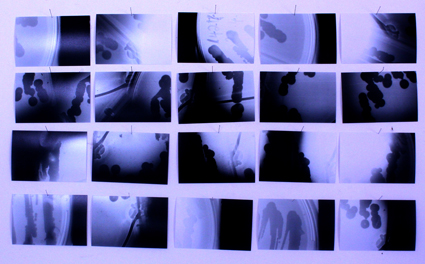
Unsettling eros of contact zones, Tarsh Bates
Here’s exciting news for experienced art practitioners, scientists, or humanities scholars who wish to engage with creative bioresearch. SymbioticA, a world-renowned Artistic Research Laboratory embedded within the School of Anatomy, Physiology and Human Biology at The University of Western Australia, is offering a Master of Biological Arts degree.
Academic coordinator and Assistant Professor Ionat Zurr writes, “The Master of Biological Arts (aka the Alternative MBA) is offered to those who are interested in what is happening with (and to) life today. Students have access to recent technology and expertise in the field of science (particularly the life sciences) and are required to explore them, hands on, in a cultural and artistic context. We encourage critical thinking, ethical provocations, controversial future scenarios, and questioning of current practices and politics, all through a rigorous and informed engagement with the fields of art and the sciences.”
In the first of the two years of the course, students with arts backgrounds will take relevant science units, while students from the sciences will take units in fine arts and/or performance, literature etc. The focus in the second year is “the student’s own creative research with access to scientific laboratories and mentorship from the arts and the sciences,” in the context of SymbioticA’s other activities involving “core and visiting researchers from around the world.”
Previous student projects include the deploying of “living neural tissues as agents for digital corruption and misinformation”; conducting experimental portraiture in the making of death masks for laboratory disease model mice; drawing imaginary landscapes using sleep science techniques with living, sleeping bodies; exploring “interspecies relations and feminist critique by caring and living with slime molds”; and converting “an atomic force microscope into a musical instrument that plays by touching living cells.”
The accompanying image is from the work of Tarsh Bates who completed a Master of Science (Biological Arts) in 2012 and is currently a candidate for a PhD (Biological Arts) at SymbioticA where “her research is concerned with gentleness, the aesthetics of interspecies relationships and the human as a multispecies ecology. She is particularly enamoured with Candida Albicans, the single-celled opportunistic fungal pathogen commonly known as thrush.” RT
For information: http://www.symbiotica.uwa.edu.au; sym@symbiotica.uwa.edu.au
RealTime issue #122 Aug-Sept 2014 pg. 22
© RealTime ; for permission to reproduce apply to realtime@realtimearts.net
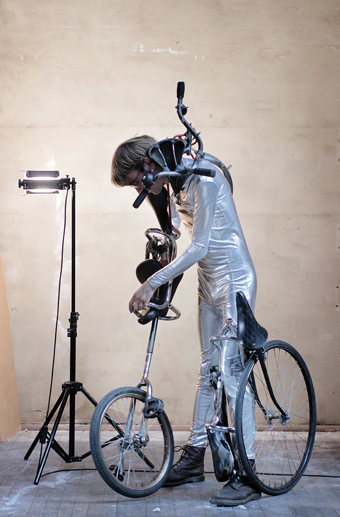
Brenton Alexander Smith, The Bicycle Man, 2013, SCA Bachelor of Visual Arts (Honours); one of a series of photographs and stand-alone sculptures (see page 22)
photo Hyun Lee
Brenton Alexander Smith, The Bicycle Man, 2013, SCA Bachelor of Visual Arts (Honours); one of a series of photographs and stand-alone sculptures (see page 22)
Unlike contemporary technological devices that tend to distance users from the impacts of their public interactions—distracted pedestrians lost in their iPhones or bike-riders reclaiming the footpaths are among the everyday hazards of city life—Brenton Alexander Smith’s prosthetic “bicycle suit” attachments made from old bike parts are designed to “hinder the wearer, forcing them to slow down and consider their movements.”
On the cover of this edition, we reproduce an image from Smith’s series emanating from this idea. Titled The Bicycle Man (2011-2013) the series comprises photographs and a set of stand-alone sculptures.
He writes, “This work parodies the idea of the cyborg and reflects society’s apparent desire to merge with technology. It serves as an antidote to the post-humanist belief that technology can allow one to transcend the limitations of the body.”
Smith is currently completing his BVA Honours year at Sydney College of the Arts. In December he will be heading to Iceland as the Skammdagi Artist in Residence at Listhús in Olafsfjordur “in the darkest part of winter.” RT
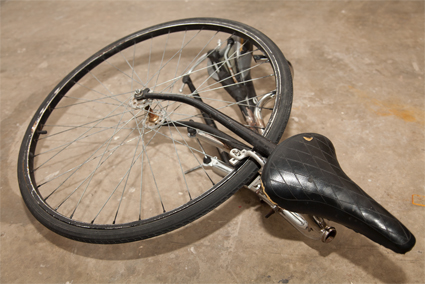
Brenton Alexander Smith, The Bicycle Man, Extension Obstruction, 2013, photo courtesy the artist
RealTime issue #122 Aug-Sept 2014 pg. 22
© RealTime ; for permission to reproduce apply to realtime@realtimearts.net
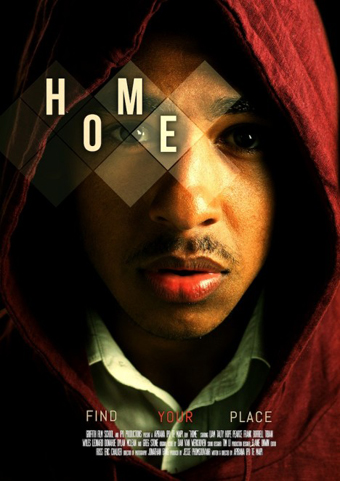
HOME, director writer Apirana Ipo Te Maipi, producer Jesse Phomsouvah, Griffith Film School. HOME won the Most Outstanding Script Award and Best Overall Film at the Griffith Private Craft Awards, 2013.
The local film industry was one of the big losers in this year’s federal budget, with government funding agency Screen Australia set to lose $38 million over the next four years. Screen Australia has since announced that most of the cuts will be made to documentary funding and ancillary programs, that its marketing department and state and industry programs section are to be replaced by a smaller business and audience department, that staff will be cut from 112 to 100 and support for screen resource organisations such as Sydney’s Metro Screen, Melbourne’s Open Channel and Adelaide’s Media Resource Centre will be phased out over the next 18 months.
CEO Graeme Mason argues that the changes will focus Screen Australia on development and funding of what he describes as “risk-taking projects that identify and build talent; intrinsically Australian stories that resonate with local audiences; and high-end ambitious projects that reflect Australia to the world.”
In June, Mason described the screen industry as contributing “$6.1 billion to the economy. It employs 41,000 people. When we come to town the spillover benefits and spillover effects are monumental—although this again is often forgotten by our detractors. Films and television programs are made with an eye to the commercial gains. It is, however, incredibly difficult to finance high-end television or a feature film and then see it through to completion on time and within budget, often in multiple locations, with a total cast and crew reaching up to 2,000 on big productions.”
“Producers,” he said, “have to be incredibly agile business people, managing a project from the chrysalis of an idea to a major-scale production, and the advertising and distribution to a wider audience over many years. To put this into perspective, on average it takes three-plus years and eight drafts to develop a project, and that’s before shooting begins. It is then another 12 to 18 months before the project hits a screen of any description.”
Globalisation & its benefits
So, given the severe budget cuts to an industry in which it is already very hard to make a film, are things looking gloomy for anyone whose tertiary education is aimed at a career in film? Surprisingly, no. There’s still a degree of optimism about the interesting and different career paths opening up for graduates. And what is contributing to this optimism? Primarily, it’s the increasing globalization of the industry, the many ways in which the role of the screen producer is widening and changing, and the ever-increasing opportunities offered by the explosion of digital production.
As Tom O’Regan, Professor of Cultural and Media Studies at the University of Queensland, and Anna Potter write in Media International Australia (No 149, Nov 2013), “Australian producers were once almost exclusively Australian companies accessing Australian funding schemes and courting international partners. They produced programs to imported and locally developed formats and created original feature and television drama production. Now they are just as likely to be transnational production companies utilising the global formats of parent companies and creating original Australian content, including for subsequent use as formats in other markets.”
This increasing affiliation of “independent Australian production companies with their global counterparts” is either through overseas companies establishing local operations, or the purchase of local production companies by international organisations. “These arrangements offer considerable advantages,” they add, “including access to global distribution and financing networks, specialised production knowledge and superior market intelligence.” And, of course, employment. With Australian film distribution, production, post-production and visual effects companies also being globalised, the expertise of local personnel should certainly lead to work in other areas of the new parent companies’ activities.
Speaking the languages
Universities and film schools are keeping up with this globalisation. They not only take international students, but as Lisa French, Deputy Dean, Media, School of Media & Communication at RMIT, explains, have overseas campuses as well. RMIT has campuses in Vietnam, Hong Kong and Barcelona, and students can undertake overseas internships or work on various projects with international partners. However she still sees as a problem the fact that Australian students don’t speak many languages. “RMIT does provide language courses, and in some courses it’s a requirement,” she says, adding, “it’s really important that this emphasis on language is increasing, as is the growing interest in Asia.”
Multi-skilling
Filmmaker and critic Peter Galvin, who has been teaching at the Sydney Film School since it opened in 2004, says the school attracts a number of international students who may have already worked in their local industries. “They come here to sharpen their skills and acquire a diploma; some then stay on, while others return. They come to our school for the same reason as our local students do—because they can make films here. Very few film schools or courses allow their students to make as many films as we do. Most of our students would work on about 15 film projects in a year, working on each other’s films—we encourage collaborations and partnerships. They may be working on two or three films at once, in different roles. They get a chance to diversify, to understand the different roles that go into making a film, and discover where their own interest lies. That’s not only a big output, it’s terrific experience.”
Alternative directions, new niches
While graduates with creative arts degrees in film and media might not have clear pathways to established careers, there are increasingly interesting and different directions in which they can find fulfilling occupations. Associate Professor, Media Arts and Production at UTS, Gillian Leahy says, “we’ve got graduates who are making music, directing drama, setting up sound companies. And they go to all sorts of places—working with film festivals, in classification, making digital displays for a museum, working in different areas of research.” She’s very pleased that while many of their graduates, “don’t end up anywhere near where they they thought they would, they still feel happy and fulfilled at the unusual direction they’ve taken. But then,” she adds, “there are those who really know where they want to go—and get there.”
As Stuart Cunningham Distinguished Professor of Media and Communications at QUT and Director of the ARC Centre of Excellence for Creative Industries and Innovation, says, people who do creative work find all sorts of niches in advertising, marketing, creative services. Digital is ubiquitous, he says, “and there is a need for digital producers in mining, in health services, in training areas. Many graduates find stable employment working in creative roles for organisations outside the creative sector, or for firms that provide creative services such as design or media/communications to other businesses.”
And Lisa French explains: “we’re trying to produce graduates who are mobile, able to adapt, not afraid of moving into new technology. They’re more flexible, more creative, and can move into all sorts of industries. By the time they finish they have work they can show, but it’s not necessarily traditional work—it’s their potential, and if they are innovative and adventurous they’ll have lots of options.”
The new screen producers
The actual role of a screen producer is also changing; Stuart Cunningham believes that it now spreads across film, television, advertising, corporate video, and the burgeoning digital media sector. “In recent years, fundamental changes to distribution and consumption practices and technologies have brought about changes in both screen production practice and in the role of existing screen producers, while new and recent producers are learning and practicing their craft in a field that has already been transformed by digitisation and media convergence.” And he emphasises that it’s important to give filmmakers some business skills so they can establish start-up companies, or form partnerships. “These skills are much more necessary in this diversified world; government money is never going to be enough, so small business survival is important.
Producers are now being trained who can work in a wide range of entertainment areas, such as managing the entertainment on a cruise ship or creating digital content for a supermarket chain.” As Gillian Leahy says, “If you can produce a film, you can produce anything. If you master the details of producing, of budgets and schedules and time constraints, of getting your film finished and into the market, anything else would be easy!”
No glitz, no glamour
Producer Liz Watts, whose company Porchlight Films has produced Animal Kingdom, Lore and currently has The Rover in release, takes interns from UNSW, AFTRS, UTS and Metro Screen, and says she’s impressed not only with their enthusiasm and aptitude, but with their realistic attitude. “I do think they understand what a hard industry it is; they have no illusions about glitz or glamour.” She’s impressed with the way AFTRS and Metro Screen are establishing short courses that tap into skills gaps in the industry, in areas like SFX. “That provides more flexibility, and combines with more early interaction with the industry through internships that can only be positive.”
The group & time to think & create
One skill that is well worth acquiring is that of editing. Gillian Leahy says, “when you teach students to edit, the how and why, there are all sorts of jobs they can do. They can start editing promos, then move into making or producing promos for film, for television, for distribution and marketing. Their editing skill gets them started, and they can move into other areas from there. We give them a good grip of visual language, a sense of what works. And one of the great benefits seems to be that sense of a group effort, of working with others during their course, and then working with other graduates afterwards. We’re not just training them for the industry. We’re giving them time to think, to create—all the things that universities are supposed to allow them.”
New degree of optimism
AFTRS, Australia’s national screen arts and broadcast school, is certainly optimistic, with a new three-year Bachelor of Arts in Screen starting next year, designed to prepare Australia’s next generation of creative practitioners to be the leaders in their respective fields. The school, which has a process of adapting its courses to keep up with the needs of a changing industry, is looking to equip graduates for work in a platform agnostic world. But the course also recognises the importance of both narrative and tradition with its two core subjects, Story & Writing and The History of Film that will run for the full three years alongside elective specialist subjects. AFTRS CEO, Sandra Levy says the BA is all about critical thinking and creative engagement, and has been designed to ‘future-proof’ graduates for a changing and dynamic world post tertiary studies.
Documentary options
With the commissioning of and funding for documentaries already difficult, has the decision by Screen Australia to cut some of its documentary support made it a bleaker future for graduates specializing in documentary? Associate Professor (and documentary maker) Pat Laughren, from Brisbane’s Griffith Film School, says, “documentary makers, more than any others, are multi-tasking and flexible, and while it’s true that not much traditional documentary is being commissioned, there is an enormous amount of factual programming being made. And there is still corporate and industrial production, too; it may be shorter, and it may be streamed, but it will never go away. So those with documentary as their real ambition will still be able to find interesting and related work, even as the means of production and distribution change and evolve. And that’s just as well, because there are always a few students who really get the documentary bug!”
RealTime issue #122 Aug-Sept 2014 pg. 24,29
© Tina Kaufman; for permission to reproduce apply to realtime@realtimearts.net
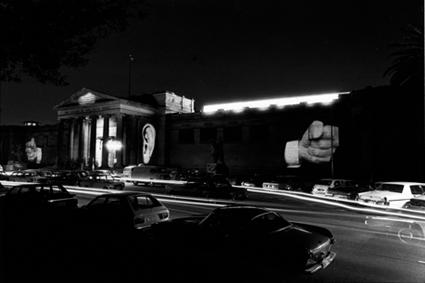
Krzysztof Wodiczko, Art Gallery of New South Wales, Sydney, 1982
courtesy the Profile Foundation
Krzysztof Wodiczko, Art Gallery of New South Wales, Sydney, 1982
What is the role of monumental architecture in urban terrains traversed by hordes who pay little attention to their surroundings? How does a glitzy outré edifice impress a general populace glued to their smart phones scrolling through selfies and welded to earbuds playing television idol finalists’ hits? This is the problem faced by entrepreneurial city councils the world over. To succeed, architects and councils must collectively pierce the insular audiovisual womb within which more and more people walk the streets and take public transport.
Buildings thus now perform like outlandish clowns, hysterically trying to attract the attention of those in their immediate vicinity. Buildings are no longer forms or objects – let alone sculptures or installations. They are forced performers: mimes for hire; fancy-dress party goers; strip-o-grams. Within the logic of global millennial urban renewal, buildings are there not to be renovated, but to be tizzed-up, frizzed and permed. And the most effective means for this type of drag is public projection. It can be rudimentary still dissolves à la PowerPoint, or smarty-pants projection mapping. It doesn’t matter; the result is the same. That old building is deemed to suddenly ‘come to life.’
Lit-up public buildings are new millennial equivalents of fireworks displays. But rather than the cosmos exploding in an open-air planetarium, illuminated architecture celebrates the earthly realm and its civilised patrons by portraying the city in idealised aesthetic terms. In the urban dark, the outside world shines just like the evening parade at Disneyland. It’s all family-friendly and lower-common-denominator stuff—which begs the question whether it’s worth analysing or critiquing. But the preponderance of council-funded tourist-touted festival-lauded events of public projections now constitutes a dominant form of audiovisual spectacle. Instead of the raw energy gunpowder detonations of old fireworks displays, any night-time event of large scale is now accompanied by ‘public address’ broadcast of musical accompaniment.
Things didn’t start out that way. Early public projections such as Krzysztof Wodiczko’s anti-Reagan statements of the mid-80s were thankfully silent. Like elliptical luminous graffiti, their critique was metaphorically amplified by scaling-up succinct, direct imagery (a politician’s hand, a missile head, chains, a homeless youth, a grieving mother, etc) onto public architecture. Despite their gargantuan presence, they did not blare their message; their still silence invited contemplation. That was a long time ago, when city centres were struggling to stall bankruptcy and deal with crime rates. In the soft culture overload of the present, those core social problems have returned with a vengeance. The city is now regarded as a giant canvas of distraction to celebrate its ‘soul’ or ‘spirit’ or whatever Disney/Pixar/DreamWorks effigy you choose. Consequently, musical accompaniment of the rankest order is required to actualise the public space of the projection, to transform it into a transfigured shopping mall plateau.
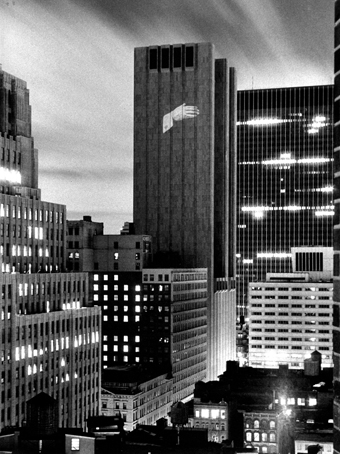
Krzysztof Wodiczko, AT&T Long Lines Building, New York, 1984
courtesy the Profile Foundation
Krzysztof Wodiczko, AT&T Long Lines Building, New York, 1984
All this would be fine if it was acknowledged that the commissioning of public projections since the late 20th century performs this workman-like task of tizzying up a CBD void. But that would be a bare, blunt admission. Hence art comes to the rescue: that wonderful transformer of the banal into the aesthetic. For no public projection is not regarded as ‘art’. Indeed, public projections are championed as technologically advanced contemporary art. Massive render farms. Mega-pixels. Humongous solid-state drives. Enough lumens to decimate a small planet. It’s the ‘wet reality’ of what New Media Art proponents dreamt of throughout the 90s. Well, those dreams came true.
The Lighting The Sails commission for illuminating the Sydney Opera House with synchronised multiple projections has always been a major event of the annual Vivid Festival. Starting with Brian Eno’s projected version of his software-randomised still cross-dissolves titled 77 Million Paintings in 2009, Vivid embraced the idea of granting an artist access to the mega-canvas of the Opera House ‘sails’ at night. Great in theory, but ugly in reality. The visual quality and appearance of Eno’s ‘vivid’ artwork is like a hyper-RGB tweaking of splotches of Ken Done and swathes of Pro Hart. Uncannily, Eno’s gaudy palette and texturing synchronised perfectly with Australia’s populist idea of ‘visual artistry’: they evoke 77 years of bad white ‘modern’ landscape art.
Since 2010, the Vivid public projections became Lighting The Sails. These large scale commissions have been granted internationally: 2011 to Superbien from France; 2012 to Urbanscreen from Germany; 2013 to Spinifex from Australia; and 2014 to 59 Productions from England. Each one progressively foregrounded musical accompaniment by effectively ‘scoring’ the image sequences to a mix of shallow studio-produced teledoco-style background mood noodling. It’s the kind of ‘imaginative soundtracking’ that high school kids source when they post their first YouTube video editing exercise. The 59 Productions upped the ante with a more astute track selection (Explosions In The Sky, Ratatat and Battles), but the visuals swamp the edgy art-prog-rock of those tracks with decorative fluff and smarmy pop graphics. 59 Productions’ commission has been the most blatant in its self-serving remythologisation of the Opera House’s design, going as far as incorporating historical sound bites of parliamentary missives against carrying through with Jørn Utzon’s original design. Everyone now champions the design of the Opera House—but mostly as a pat on the back to show how far we as an anti-intellectual nation have progressed.
Looking at and listening to 59 Productions’ Lighting The Sails, I perceive no progression—especially as it climaxes with Vivaldi and Joey Talbot. If anything, its audiovision confirms how the Opera House can become a forced performer, illuminated and animated into an audiovisual effigy of all the ersatz values of hi-tech public art. It’s presented as an ‘art event’—but of the kind that first and foremost pleases the marketing departments of large arts institutions, consoled in knowing that plebeians will be transfixed by vulgar momentary distraction. The public will lower their smart phones, pull out their earbuds, and realise how magnificent the Opera House is. Considered this way, public illuminations of such scale are like gargantuan portraits of court officials. The Sun King Louis XIV would have found Lighting The Sails dazzling.
The Australian film industry mostly services the advertising industry, with occasional deliveries for television drama. Similarly, large scale public art commissions form but a tiny tiara on a hulking pro-AV industry which mostly services the advertising industry, with occasional deliveries for franchised theatre and corporate events. One can read the cartography of these interlocking industries to discern any overlapping zones between their client servicing and ‘artistic production.’ There isn’t any. That’s what is illuminated by Lighting The Sails.
–
RealTime issue #122 Aug-Sept 2014 pg. 26
© Philip Brophy; for permission to reproduce apply to realtime@realtimearts.net
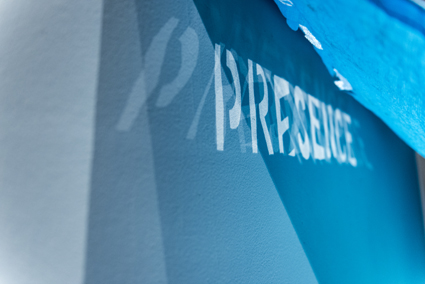
David Brophy, Presence in the absence of presence (detail), from the series Euphoric Recall, 2013. Tarpaulin, brick. Exhibition view HATCHED, Perth Institute of Contemporary Arts, 2014. David Brophy studied at Creative Arts, Central Institute of Technolog
photo Alessandro Bianchetti
David Brophy, Presence in the absence of presence (detail), from the series Euphoric Recall, 2013. Tarpaulin, brick. Exhibition view HATCHED, Perth Institute of Contemporary Arts, 2014. David Brophy studied at Creative Arts, Central Institute of Technolog
It’s a fascinatingly trepidacious time for teachers and students of arts education and training. The resurrection of the culture wars, the ‘deregulation’ of university fees, consequent ‘increased competition’ and fear of the evolution of a two-tiered rich-and-poor university system sit side-by-side with exciting new degrees, programs, local and international partnerships and new buildings. It’s optimism against the odds as the tertiary sector makes its presence felt and integrates itself with the wider world.
We feature reports on developments at Monash University’s Centre for Theatre & Performance, VCA and Adelaide College of the Arts and survey courses in performance, theatre, dance and design across Australia
UNSW’s College of Fine Arts has been retitled UNSW Art & Design. The Dean, Ross Harley tells us about new teachers, equipment, studios, labs and galleries that will occupy new buildings, playing an instrumental role in the making of Art & Design’s local and international partnerships and reputation.
In regional coverage, Scott Howie empathises with refugees, casting himself adrift on Wollundry Lagoon in the centre of Wagga Wagga; Urszula Dawkins talks with Bridget Crone, director of the impressive Cinemas Project staged across regional Victoria; and we highlight Selena de Carvalho’s The Evolutionary StraitJacket = Climate Change Karaoke, a featured work in the 2014 Junction Festival in Launceston.
RealTime issue #122 Aug-Sept 2014 pg. 3
© RealTime ; for permission to reproduce apply to realtime@realtimearts.net
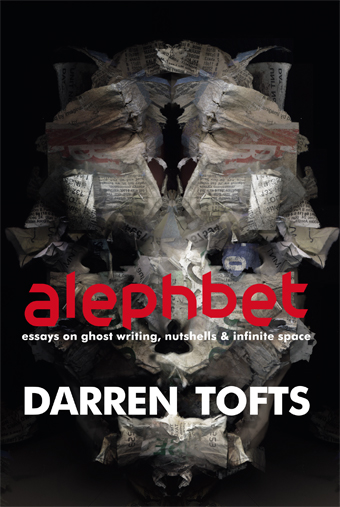 Underlying the collected essays of Darren Tofts’ alephbet is the audacious, anti-historical idea that the internet can be thought about through films and works of literature that preceded its invention. To play out this provocation, Tofts chooses writers whose stories are game-like, such as Italo Calvino, Gilles Deleuze, Roland Barthes and above all Jorge Luis Borges.
Underlying the collected essays of Darren Tofts’ alephbet is the audacious, anti-historical idea that the internet can be thought about through films and works of literature that preceded its invention. To play out this provocation, Tofts chooses writers whose stories are game-like, such as Italo Calvino, Gilles Deleuze, Roland Barthes and above all Jorge Luis Borges.
Alephbet is presumably named after the Borges story “The Aleph,” about a point in space through which it is possible to see all other points. Borges is a character in his own story, and is introduced to the Aleph by a rival writer, Carlos Argentino, who is trying to emulate the effects of the Aleph in a long poem. Borges himself shies away from the Aleph, feeling more intimidated than inspired. He tries to distance himself from Argentino, whose aspirations he finds insufferable.
Of the two characters, Tofts resembles not Borges but Argentino, as the essays in alephbet are about the internet, that great portal of simultaneity in our own time. In so doing Tofts confronts the paradox of the Aleph, that aspires to contain everything in space including itself, and yet appears to lie outside everything too. To describe the internet is to describe an everything that is also a something, a thing that is also nothing, an immense multiplicity that seems to hold in its grasp the world itself.
So it is that Tofts resorts to a literary archaeology in which Borges stars prominently, because his writing describes textual mazes that stand in for the frantic contemporary experience of searching and linking, connecting and disconnecting. The analogy is a compelling one, not least because the historical Borges, as well as the character of Borges in “The Aleph,” stand perpetually outside the internet and its ecstasies, maintaining a sensible distance.
Tofts’ turn to Borges and other literature of the mid-20th century would seem a sensible move, in order to put some distance between the present and the past, to begin to cognitively map the virtual age. In literature lie cognitive precedents for both the disorientation of the labyrinth and its mastery, for navigating the infinite rather than being paralysed by it.
The stories of Borges come in alephbet to look like a roadmap for navigating the early 21st century, anticipating the hypertextual ecstasy of the internet user. In the indefinite narratives of Borges’ stories lie guides to the ways that conventional narratives can be circumvented by new links, new information.
The essays in alephbet use Borges as a bit player in Tofts’ much greater ambition, to create writing that is adequate to the everyday experience of the internet. They do not put a distance between ourselves and this most permeating of media, but create an hysterical present by which the possibilities promised by the internet might come into being.
For Tofts’ version of the internet is also bound to its most utopian moment, the late 1990s, as his theories revolve around terms like avatar, cyberculture, hypertext, media art and virtual worlds. In “Virtual curb crawling, lurkers and terrorists who just want to talk,” online sex is the key to understanding digital culture of this moment in our recent history, when the prophesies of cyberpunk seemed to be coming true. A wave of art projects took up the challenge of being adequate to the new virtuality. Internet Explorer, Bjork’s Post (1995), VNS Matrix and Stelarc are conjoined by Tofts’ ecstatic investigation of the way that bodies took on new meaning as they connected digitally.
“Virtual curb crawling” is symptomatic of a second paradox that haunts Tofts’ essays. This is the problem of doing a media history of the present while also describing this present, critiquing Internet Explorer while having it open on your desktop. The problem is unavoidable when it seems, as it does for Tofts, that the future has already arrived, that it came into being some time ago, as history became mired in the simultaneity of cyberspace.
The essay “Epigrams, Particle Theory and Hypertext” reports on the visual epigrams that punctuate the writing of Borges, Calvino, and Deleuze and Guattari. These little designs create miniature analogies for the circularity of their ideas, for the traps they lay for the reader. Calvino’s novel If on a winter’s night a traveller (1979) begins only to begin again, never completing a story but creating a succession of first chapters. Calvino’s novel is about the impossibility of writing, as the novel remains trapped by its own infinite possibility, its labyrinth of potential.
Cinema, too, furnishes Tofts with metaphors for the virtual revolution. Essays on the retro-futurism of Alphaville (1965) and the Deleuzian time-image in The Matrix (1999) work to unravel some of the paradoxes of an age steeped in technology. The hero of Alphaville photographs everything with a flash camera, momentarily blinding this imaginary future for posterity. The Matrix slows down time, as the action sequences of super-powered avatars are choreographed to suit human perception.
Borges is often cited as the forerunner of everything from magic realism to postcolonial literature, if not postmodernism itself, but for Tofts such multiplicities have already collapsed into the digital now. To read Tofts is to breathe as if we are drowning in binary code, and it is in this ecstatic, hyperbolic universe that Tofts creates arguments about writing.
Most compelling are his descriptions of the avatar that cannot theorise its own existence except through writing, through representation. In taking the place of the self, the avatar rewrites the possibility of thinking about thinking. It writes itself as a writer. And we are all avatars of ourselves insofar as we spend increasing amounts of time online.
Alephbet may be a tricky read for those unfamiliar with the proliferation of references that Darren Tofts strings along in quick succession, but the kind of hypertextual model of writing that he proposes comes to seem sensible in a digital era that has us all immersed in its own multiplicities, even if in spite of ourselves.
Darren Tofts, alephbet, essays on ghost writing, nutshells & infinite space, Litteraria Pragensia Books, Prague, 2013
RealTime issue #122 Aug-Sept 2014 pg. 29
© Darren Jorgensen; for permission to reproduce apply to realtime@realtimearts.net
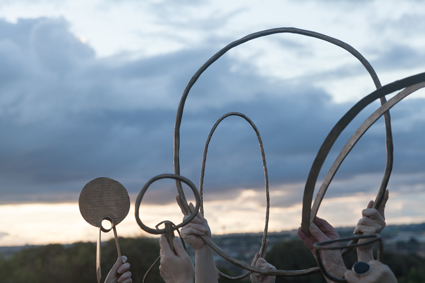
Bianca Hester, Sonic Solar Objects, The Cinemas Project
photo Sam Nightingale
Bianca Hester, Sonic Solar Objects, The Cinemas Project
An old-time country cinema, still standing despite floods, fires and hard times; immersive films that question representation itself, drawing viewers into mysterious depths; the literal ‘moving images’ of historical figures across Port Phillip Bay; spinning hoops that raise sonic spectres of sites now lost…All are part of The Cinemas Project, curated by Bridget Crone, which paired five artists with former cinema sites to make new, site-specific works in Mildura, Warrnambool, Geelong, Bendigo and Gippsland.
Crone conceived The Cinemas Project while travelling with photographer Sam Nightingale, who was documenting lost or now-hidden Victorian cinemas and drive-ins. Finding these early spaces of cinema, Crone says, meant talking a lot with locals; their recollections fuelling her rationale for what became the project’s sub-title: “Exploring the Spectral Spaces of Cinema.”
“What struck us both about these conversations was the vividness of people’s memories but equally, at times, the inexactness of memory, and its imaginative license. It seemed that this approximated somewhat the activities that had taken place in these old buildings…the cinemas were used as community centres for debutante balls, for community meetings and other ‘live’ events, as well as being places where you could imagine another world—so they were of this world as well as part of another.”
Crone is keenly aware that regional centres often see touring exhibitions, but have less frequent access to work created in, with or for their own communities. She deliberately commissioned contemporary interdisciplinary artists for the project, because “they work so flexibly between terrains of live, tangible form and mediation—the projection of images—and the intersections of these modalities.
“The activity that has taken place in the cinema buildings also neatly evokes this slipperiness between images and material forms—or, in other words, live bodies and projected images.”
The artists commissioned were Brook Andrew (Bendigo), Lily Hibberd (Yarram, Latrobe Valley – see In Profile), Mikala Dwyer (Mildura), Bianca Hester (Warrnambool) and Tom Nicholson (Sorrento to Geelong). Bianca Hester’s performance/film—titled sonic objects, solar objects: variously—included large, spinning, wailing metal hoops, spun on the ground at sites of now-lost cinemas. “The hoops reacted very specifically to the material of the ground upon which they were spun—concrete, wood, asphalt,” says Crone. “They therefore give a very particular reading of a place.”
By contrast, Lily Hibberd, working with Gippsland’s Yarram community (RT Profiler 4, 2 July), created an exhibition including recovered cinema artefacts, a play and film performed by community members, drawing out memories, unearthing lost relics and exploring themes of displacement and resilience.
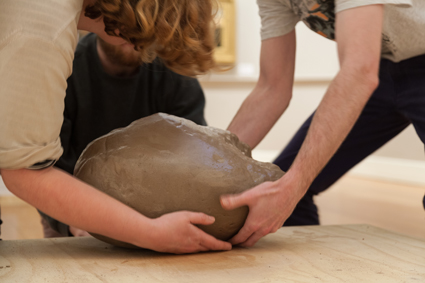
Tom Nicholson, Indefinite substitution The Cinemas Project
photo Sam Nightingale
Tom Nicholson, Indefinite substitution The Cinemas Project
Tom Nicholson’s Indefinite substitution—in which unfired wet clay busts of prominent colonial figures William Buckley and John Batman were carried (and ferried) from Sorrento to Geelong over four days—referenced film’s analogue nature and extrapolated the ‘moving image’ to its most physical form. Also relying on community input, Indefinite substitution’s busts were carried, substituted and exchanged by local volunteers whose hand-marks on the clay gradually altered the busts, which also left their mark on the handlers.
Bridget Crone gave each artist thematic ‘free rein,’ but sees definite cross-connections in the works. If community engagement links Hibberd’s and Nicholson’s works, Brook Andrew’s and Mikala Dwyer’s contributions share a fundamental concern with the question of image-making, Crone says. She mentions the “materiality” and “magic” of Dwyer’s work, which includes both haunting, locally shot film images and mysterious clear-plastic sculptures. “Both material and magic have a direct relationship to the image if we think about early image technologies developing from forms of magic and spiritualism,” she says, “making things appear and disappear.” Spectral threads connect Dwyer’s Underfall to Brook Andrew’s large-scale video installation, De Anima, which simultaneously explores the concept of the soul and the politics of representation. Both works, says Crone, evoke “a strong sense of the immersive, sensory, experiential nature of cinema; therefore focusing on the affective nature of the medium.”
She also points to the ways the five artists have drawn attention to specific materials or environments—extant or lost—of the cinema sites themselves.
“There are many tangents and commonalities…One interesting thing I have noted is that the cyclic movement of film—the film reel—is evoked in Bianca Hester’s spinning hoops and also in Mikala’s three-channel video installation, Underfall, with one screen devoted to a swinging pendulum that forms part of the mechanism of the town clock. This is just an odd aside, but shows that there are so many different connections to be seen through the works—which is amazing considering they have been produced so independently of each other.”
The Cinemas Project: Exploring the Spectral Spaces of Cinema, curator Bridget Crone; commissioned by NETS Victoria, April-August, www.thecinemasproject.com.au
See our In Profile on Lily HIbberd’s Twin Cinema: Four Devils and a Woman in Red
RealTime issue #122 Aug-Sept 2014 pg. 30
© Urszula Dawkins; for permission to reproduce apply to realtime@realtimearts.net
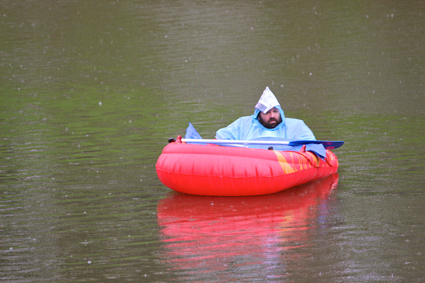
Scott Howie, Boat/Person
photo Vic McEwan
Scott Howie, Boat/Person
On Wednesday 9 July, Tony Abbott appeared on the Today show where he addressed questions about the reports of mothers on Christmas Island attempting suicide in the belief that their children would then have better success at achieving asylum in Australia. Abbott’s response was that his Government wouldn’t “capitulate to moral blackmail.”
So as Australian citizens, what are our options? What do we do when our government won’t answer questions of deep concern? When our government doesn’t serve our needs, our natural cravings to see ourselves operating with humanity and compassion?
Scott Howie, a Riverina based artist and cultural leader, felt this despair as he watched the media coverage. What followed was a very public series of posts on social media which saw his compulsion to act develop, just three days later, into a durational performative action on the Wollundry Lagoon, in the centre of the civic precinct of Wagga Wagga.

Scott Howie, Boat/Person
photo Vic McEwan
Scott Howie, Boat/Person
Regional Australia, especially areas like the Riverina, which has a deeply conservative white history, isn’t witness to much protest let alone public durational performance. So to watch this event unfold in the public realm felt exciting. Scott’s initial, dismayed post quickly led to the idea that in quiet, respectful protest, he would sit in solidarity with refugees by launching himself in an inflatable boat into the middle of the lagoon where he would “sit and weep for some time.”
He assembled a group of Observers who would be on the banks, protecting his belongings, looking out for his safety, addressing any concerns with police, rangers or media and answering any questions from the community. The proposed action was both an act of rebellion and an act of love, of personal expression and protest. Scott’s direction to the Observers was to not become antagonistic or be drawn into conflict with any opponents who might be encountered.
As Scott launched himself into the Lagoon, just after 9:30am on Saturday 12 July, drizzly rain got heavier, the adverse conditions only adding to the weight of the artist’s actions—the fog, the rain, the boat drifting into the middle of the lagoon, blown around its edges, the lone figure trying to keep it from crashing into rocks, from getting snagged on lagoon debris.
He sat, restricted in movement in the precarious dingy for a period of ‘settling in.’ As the rain fell harder, he attempted to move about carefully in his raft, using his meagre possessions to create some comfort, some shelter from wind and rain. He placed plastic over his body and used an old tarp to umbrella the boat, to stop it taking in the rain. We felt empathy for Scott in his plight out on the water, a small figure in a big landscape, his actions engaging and mesmerising from afar.
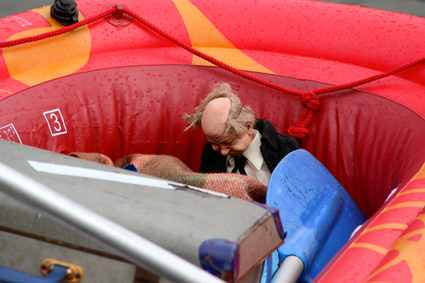
Scott Howie, Boat/Person
photo Vic McEwan
Scott Howie, Boat/Person
Onboard were a few supplies: a tiny suitcase, some food, a thermos and personal mementos. Also on board was another passenger, Scott’s puppet, a regular collaborator in works over recent years referred to affectionately as “Old Man.” Sometimes they were in conversation, sometimes they wept, sometimes they just sat slumped.
Scott’s action lasted until 3:30pm when cold conditions proved too much for him and the effects of exposure to the elements were deepening. As he made his way to the shore, he was helped out by supporters, some of whom had sat on the bank all day. With cramped legs that made walking difficult at first, he was helped up onto the rocks until the circulation started flowing again and he stood drenched and shivering.
Some watchers engaged with the action, some asked questions. One man held up an imaginary rifle and pretended to shoot the boat before explaining to those within earshot that he didn’t like refugees because they once broke the window of his shop. Many engaged in lengthy conversations.
In the Riverina on this day, people were brought together by a durational performance to witness one man’s personal expression of empathy as the rain fell and the boat slowly filled and the man sat huddled in the fog and wept.
Boat/Person, artist Scott Howie, Wagga Wagga, 12 July
RealTime issue #122 Aug-Sept 2014 pg. 31
© Vic McEwan; for permission to reproduce apply to realtime@realtimearts.net
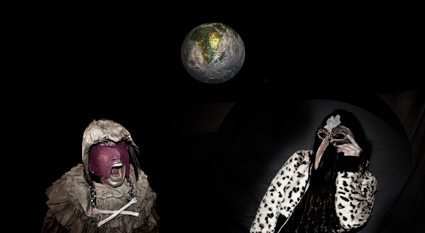
Selena de Carvalho, The Evolutionary StraitJacket = Climate Change Karaoke
One of the centrepieces of Launceston’s 2014 Junction Festival is Selena De Carvalho’s The Evolutionary StraitJacket = Climate Change Karaoke in which the audience enters “a surreal fantasy environment that holds an array of extinct animal costumes. You are invited to…embody an animal and channel the disappearing wild, while belting out karaoke pop songs that are surprisingly rich with tales of evolution.”
The Evolutionary StraitJacket looks like it will be a wild ride, a curiously fun way to contemplate the grim reality of “the inability [of species] to adapt to changing environments, thus facing possible extinction.” Hence the show’s title.
We emailed De Carvalho, asking, “What’s the relationship between the seriousness of your subject and the apparent fun of dressing up and singing karaoke?” She replied: “The Evolutionary StraitJacket hopes to raise questions as opposed to providing answers. By encouraging participation and employing humour as an entry point, the project hopes to encourage the contemplation of a more sustainable future by ‘re-wilding’ through a ridiculous, poetic, neo-ritual as opposed to getting hung up on the apocalyptic tragedy of it all.”
De Carvalho is an up and coming innovator who has enjoyed residencies in Beijing and Tarraleah (Australia) and been mentored by Anna Tregloan in design for live performance and by Raef Sawford in new media. The recipient of the 2013 Arts Tasmania Dombrovskis award, she took up an internship with Melbourne’s Magnificent Revolution, a pop-up pedal-powered cinema collective. Last year she designed Shadow Dreams for Terrapin Puppet Theatre (in partnership with the Tasmanian Symphony Orchestra and Tasmanian Palawa Community) in the Ten Days on the Island Festival. RT
2014 Junction Festival, Selena De Carvalho, The Evolutionary StraitJacket = Climate Change Karaoke, Launceston, 4-8 Sept
RealTime issue #122 Aug-Sept 2014 pg. 31
© RealTime ; for permission to reproduce apply to realtime@realtimearts.net
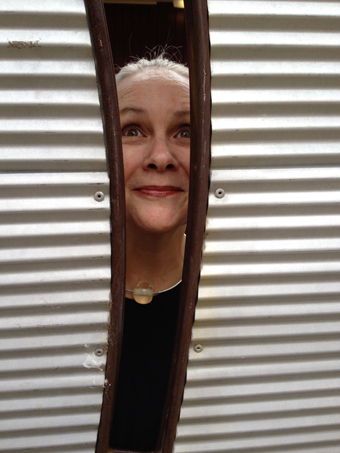
Rosemary Miller
photo Fiona Fraser
Rosemary Miller
When I ask CEO and Creative Director Rosemary Miller to describe the way she visualises the Salamanca Arts Centre (SAC), she refers to work done some years ago by Neil Cameron. After interviewing a wide range of people involved with SAC, Cameron created a delightful physical map from thread and pins, painting a complex portrait of this place. At its centre is SAC—a generating point—surrounded by a wildly branching network of connections. Miller enjoys this image as she sees SAC as a starting point or ‘engine room,’ supporting artists to begin, create and present new work that shows locally and reaches beyond the bounds of Hobart, Tasmania or even Australia.
Like the labyrinthine buildings that make up SAC, diving into the organisation occupying these spaces is a little disorientating to the uninitiated. The Centre has many faces. It is an organisation that incubates and presents new artistic work, an initiator of major arts projects, a dance school, an umbrella platform for marketing, a landlord, an administrative body, a theatre, a weekly bands venue, a shopping arcade and importantly, a custodian for an organic bundle of heritage buildings that cling to a cliffside in the heart of Salamanca Place.
Evolution
Coming up to its 40th birthday, the Centre was initially established as The Community and Arts Centre Foundation, at a time when locals were in need of “a home for the arts” and Salamanca Place was a shadow of its current bustling self. The first chairperson was winemaker Claudio Alcorso, a key supporter of the arts in Tasmania throughout his life, setting up the collection of antiquities and contemporary art that has since become MONA. Alcorso was also Chair of the Tasmanian Arts Advisory Board at the time, so from the beginning there was a connection between the Centre and the State’s broader cultural agenda.
Shape
The Centre is made up of a number of sandstone warehouses that spill directly onto Salamanca Place, but also connect laneways and courtyards that define the area. At the top of the cliff sits an historic cottage used for artist accommodation. Behind a continuous stone façade is a maze of spaces that house the Salamanca Arts Centre staff; a number of arts organisations such as Terrapin Puppet Theatre, Tasmanian Theatre Company and the Festival of Voices; artists’ studios; a range of gallery spaces; and a hive of small retail tenancies. While the physical infrastructure is complex, the organisational structure is quite simple. A board of nine governs the activities of the Centre and these are then driven by a small administrative team lead by Miller. The series of tenancies are just as important as the program. Each organisation or retailer is approved on the basis of demonstrable involvement with contemporary arts practice, bringing a curatorial approach to the Centre as a whole.
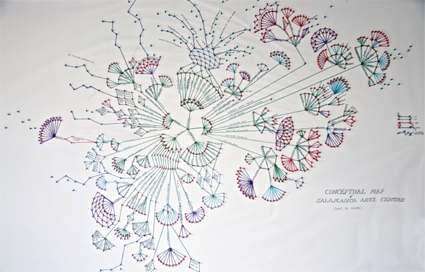
Neil Cameron, Conceptual map of Salamanca Arts Centre (not to scale)
Vision & projects
Leading SAC for almost 15 years, Rosemary Miller has a background in multi-arts bodies and festivals, with past roles at Arts Victoria and as Director of the Adelaide Fringe. As a result, she naturally fosters contexts that encourage artforms and organisations to mix and manages her team as one might a festival, retaining a core to run annual projects and maintain infrastructure, expanding as required for larger productions. Artforms that intersect within SAC include writing, theatre, dance, puppetry, film, sound, music, visual arts and craft.
The Centre runs an annual program that includes a curated visual arts show, curated installations within Kelly’s Garden and exhibitions within four galleries; but it is the longer term projects and structures that are at the heart of SAC’s current vision. Three interconnected and ongoing projects currently define its vision. First is Mobile States, which was set up in 2004, but seeded prior to this so that Miller could bring Sydney-based The opera Project’s The Berlioz—Our Vampires Ourselves on from its Brisbane Powerhouse season in 2001. Mobile States, managed by Performing Lines, subsequently emerged as a nationally funded touring consortium that includes PICA (Perth), Performance Space (Sydney) and Arts House (Melbourne). Its mission is to extend the season, audience and impact of original shows, by touring between these venues. SAC’s priority with this program has generally been to present challenging, hybrid performances, integrating learning and professional development opportunities for local artists wherever possible. This year’s program brings Chunky Move’s Keep Everything.
The second key program is HyPe, produced by Kelly Drummond Hawthorne, which incubates new, hybrid work in Tasmania. Recurring annually, this program draws in performance practitioners Deborah Pollard, Martyn Coutts and Aphids’ Willoh S Weiland as mentors and provocateurs for intensive arts laboratories. The program keys in with local festivals like Junction in Launceston, which will this year incorporate a pitching event for artists to develop funded projects for next year’s festival. Rather than present each idea that emerges from this program, SAC aims to support artists to find funding and forge relevant relationships. There are seven HyPe projects currently in development.
The third project, SITUATE, now in its second iteration, keys in with Tasmania’s bubbling festival landscape. Interestingly, this project navigates changes to the state’s arts ecology, brought on by the introduction of MONA FOMA, which is now seen as the leader in Tasmania’s festival scene. While Salamanca Arts Centre played a fundamental role in the first MOFO festival, it has refocused its energy back to its central purpose—to incubate risky, hybrid projects that push the bounds of artforms. SITUATE brings together emerging hybrid practitioners (sometimes rolling out of HyPe) with experienced events professionals to develop pitches for experimental public projects suited to local, national and international festivals. SITUATE currently has memoranda of understanding with six festivals and a number of projects in development. Miller is really excited by the projects underway: Giidanyba (Sky Beings) by Tyrone Sheather which will premier at Dark MOFO in 2015 and Plastic Histories by Cigdem Aydemir, currently showing at Vryfestival in South Africa. Critically, SAC doesn’t believe in pushing projects to fit particular annual timelines, but instead considers ways to give ideas the time needed to develop.
As MONA is on everyone’s lips when they think of Hobart and Tasmania these days, I ask Miller how she sees this diagrammatically. She gestures inward. She sees it as a place that people are drawn towards, a destination. Salamanca Arts Centre is also a destination, and a hub (as we speak on Saturday afternoon, we hear choirs in rehearsal for the Festival of Voices) but philosophically, as described by Cameron’s imagery, it is a place that thinks outwardly. Here, the focus is on developing artist careers and sending them outwards, with improved skills, a sense of autonomy, a desire to introduce risk into their practice and excellent connections.
Salamanca Arts Centre, Salamanca Place, Hobart, Tasmania
RealTime issue #122 Aug-Sept 2014 pg. 32
© Judith Abell; for permission to reproduce apply to realtime@realtimearts.net
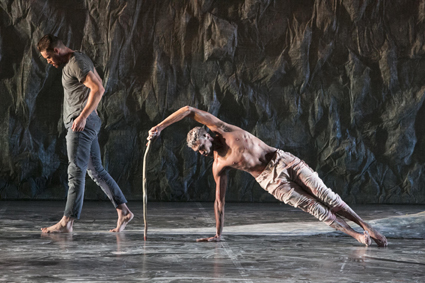
Thomas Greenfield, Leonard Mickelo, Patyegarang, Bangarra
photo by Jess Bialek
Thomas Greenfield, Leonard Mickelo, Patyegarang, Bangarra
Patyegarang is Bangarra Dance Theatre’s newest work, inspired by the relationship between the young local Aboriginal girl who shared her language, local Eora (Sydney) lore and knowledge systems with first fleeter botanist and astronomer William Dawes, unwittingly leaving a legacy for her people in centuries to come, through meticulous notes taken by Dawes.
Bangarra’s reckoning of Patyegarang is presented like a contemporary song cycle in short episodic vignettes. The performers don ochre and move in procession into the narrative, as we would coming/entering the dance ground in a more ‘traditional’ or community cultural context. The core narrative is presented in the manner of a dreaming, where time is expressed as abstract information or data, and although the sequence of events occurs in chronological order, the actual period is not as crucial as the events depicted.
From the beginning the movement differs slightly from the usual Yolngu inspired locomotive stepping. The women’s torsos still bend low toward the ground, heads slightly bowed, but the footwork brushes forward, away from the supporting leg, as opposed to the brush up flicking motion of sand toward the supporting shin/ankle. The men stamp in a simpler singular motion, or shunt, being propelled forward from the back foot, which is sickled with hip and knee slightly rotated outward, instead of an alternating Yolngu drop stomping motion. These subtle nuances may be lost on mainstream audiences, but are crucial, an indication of the different land and relationship to it, as is the local language featured in David Page’s score which is peppered with place names that have been appropriated since settlement.
I am pleasantly surprised by the intricacy of this contemporary vocabulary, which has definitely evolved over the past two decades with Stephen Page at the helm. His use of compositional space is most elaborate, busy, mirroring his use of the individual moving body.
Jacob Nash’s set is the yellow brown of sandstone, both cliffside, which appears to hold bodies in bas relief, and shore mound. This is broken up periodically by blood red banner/sculptures which fly in and loom large like ominous chandeliers. The shape of these objects is reminiscent of the NSW Aboriginal possum skin patterns burned into hides, which also remind me of visual artist Brook Andrew’s geometrically adorned caravans, Travelling Colony (RT107).
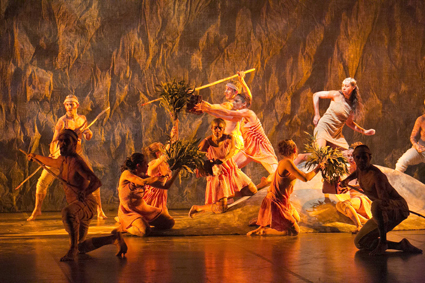
Patyegarang, Bangarra
photo by Jess Bialek
Patyegarang, Bangarra
The young dancers are beautiful technicians. Every now and again I catch a glimpse of the embodied performer: most notable was Tara Gower, the true fisherwoman, whose eyes look right down the barrel of her imaginary spear to catch her prey, among a cast performing a convincing dance about fishing, while simultaneously becoming the fish themselves in clever costumes which double as fishing baskets, created by longstanding Bangarra costume designer Jennifer Irwin.
Luke Currie Richardson impressed me with his lightning speed when shifting/transferring weight, now and then integrating a subtle quick flick of the head to emphasise the footwork when emulating the perennial hunters, in flight or fight mode.
It is the body in readiness and the eyes that focus with such intensity, penetrating the construct of the contemporary fourth wall between stage and audience, connecting with sincerity, believing and embodying, which I know from my training in cultural community dance, and am blown away by when I recognise its employment in the contemporary Indigenous form—although I was disappointed its presence was not as consistent in Patyegarang as in previous works .
I appreciated the textural shift as two bodies were scrubbed of paint, changing the dynamic, pedestrian in juxtaposition with the highly stylised vocabulary, the analogy perhaps referring to Patyegarang’s declaration that if she scrubbed she would never be white, or that we are the same underneath the colouring. Maybe it was a little too didactic to paint the bodies at all, along with the blood red cross symbolising death (from plague or massacre), or the holding of hands in assimilation. But some audience members found the metaphors mysterious and elusive.
Nick Schlieper’s lighting was epic, a constant wash of differing intensities, bathing the whole stage at all times. I couldn’t help but think that my empathy for Patyegarang and Dawes’ ill-fated relationship could have been intensified by creating a more intimate setting with pockets of light that only they inhabited.
This is a beautifully picturesque ballet, which serves a great purpose, to introduce Indigenous contemporary dance to a general public new to Bangarra while reintroducing an historical event which deserves acknowledgement. The work is a catalyst to pique curiosity, and if that curiosity is acted upon, if people are prompted to investigate further, then this show is well worth their seeing.
–
Bangarra Dance Theatre, Patyegarang, choreography Stephen Page, music David Page, set design Jacob Nash, costumes Jennifer Irwin, lighting Nick Schlieper, dramaturgy Alana Valentine; Sydney Opera House, 13 June-12 July
RealTime issue #122 Aug-Sept 2014 pg. 33
© Vicki Van Hout; for permission to reproduce apply to realtime@realtimearts.net
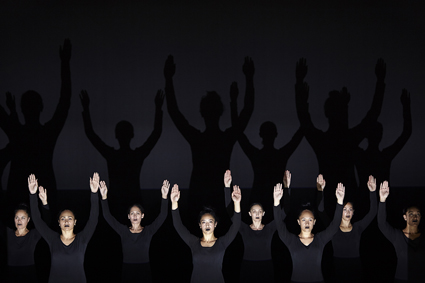
Stones in her Mouth, MAU
photo Zan Wimberley
Stones in her Mouth, MAU
During Reconciliation Week 2014 in Sydney two dance works by Indigenous creators offered insights into the challenges to their cultures—for Djuki Mala, the suicides of young men; for MAU, the diminished status of Maori women—each produced with the companies’ distinctive magic.
MAU, Stones in Her Mouth
Samoan choreographer Lemi Ponifasio, the director of MAU, the New Zealand-based dance company, and his collaborators, make haunting large-scale works inspired and nourished by the cultures of the South Pacific.
As in previous MAU works, Stones in Her Mouth conjoins traditional culture, dance and contemporary performance, heightening the melding with stage and sound design in which immersion and illusion are fundamental, such that, without narrative, we lose ourselves in a dream world that we acknowledge as sublimely other but also familiarly Western in its disorienting stagecraft.
Ponifasio carefully prepares his audience to enter the world of Maori women. We listen in protracted darkness to a growing, dark rumbling above which sonic pings evoke sub-marine depths (or “The fabric of creation/ The unfathomable space/ The internal void/ The conscious light/ The unravelling path…” in the show’s text). In the foreground a narrow strip the width of the stage floor glows with fluorescent intensity, blinding us to what lies in the void behind until the performers enter—their serene gliding (a MAU signature) made more magical by our not being able to perceive the dancers’ lower bodies. In a complementary image at the very end of Stones In Her Mouth, the floor shines like a black pool into which the women slowly wade, appearing to sink, as if spirits returning to their realm.
More than spirits, these women are like Maori goddesses: elegantly erect, imperiously inexpressive, whether as powerful individuals or groups moving in intersecting circles or, in rows facing us, deploying sticks or poi, the balls on strings that here suggest anti-gravitational, supernatural force born of ritual and shamanic power. That power is given voice and individual passion in the solo singing and reciting, alternating affectingly between anger and lament. Unfortunately there are no surtitles (which would perhaps diminish the stage magic) but the texts in the printed program can be read subsequently (or at festival.co.nz/stones-in-her-mouth/). The following program note explains the motivation for the work and the nature of its texts:
“Stones In Her Mouth was conceived as a leadership project of young women travelling and working in the community: in marae, schools and rural areas of New Zealand and in the world. …the women’s challenge is voiced through the M?ori language, genealogy, body, spirituality, ceremony, family and nature. They communicate their adaptiveness, resiliency, beauty and rage against the apparatus of power, oppression and even Western-style feminism. Stones In Her Mouth is based on writings of moteatea, the strong M?ori tradition of women as poets and composers. In Stones In Her Mouth, the chants, songs, oratory and calls are written and composed by the performers themselves.”
Movement is restricted to a set of recurrent motifs including vibrating hands and fingers, the aforementioned gliding and patterning, hands covering faces, single arms shooting upward and heads bent so far back that the dancers momentarily appear alarmingly headless.
One scene breaks the aura of ritual and its eerie but integrated cosmos: a lone woman in white, her hair loose, has been branded with a painted red cross, suggestive of the destructiveness of Christianity for Indigenous cultures; the same paint runs down her thigh, as if she has been raped. In the final scene, do the women return to an eternal spirit world or do they, as emblematic of beleaguered cultures, disappear forever into the void?
In his theatre of images, Ponifasio eschews narrative for suggestiveness. He and his superb lighting (Helen Todd) and sound designers (not specified) and the MAU performers sculpt a quasi-spiritual dream space, hinting at meanings, occasionally made specific (more so if you’ve read the text), and leave us awed to reflect on the fate of an Indigenous culture so close to Australia and paralleling the plight of our own.
MAU continues its relationship with Carriageworks, part of a three-year project, with two works from the company’s international repertoire (Stones in Her Mouth and, in 2013, Birds with Sky Mirrors, RT114, RT115), with the promise of an already much anticipated new work for Carriageworks in 2015.
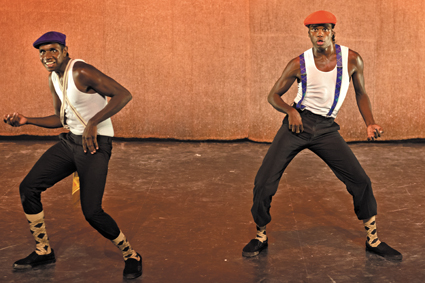
Baykali Ganambarr, Wakara Gondarra, Djuki Mala
photo Mick Richards
Baykali Ganambarr, Wakara Gondarra, Djuki Mala
Djuki Mala
A full house of devoted Sydney fans exuberantly greeted Djuki Mala [formerly the Chooky Dancers] for the Elcho Island group’s touring autobiographical show in which they interpolate their dancing with projected interviews with the performers and the eloquent wife of their late founder Big Frank Dulmanawuy—“we are living his dream.”
A brief opening speech from company director Josh Bond introduced a sombre note, reminding us that Australia has the second highest rate of youth suicide in the world, with Indigenous young men dying at double the rate of their white peers. Each member of the group had been affected by the suicide of a relative. Lack of awareness, under-resourced support organisations and the absence of a sense of mutual responsibility, said Bond, contributed to the deaths. While the performance did not dwell on this crisis it underlined the motivation for the creation of Djuki Mala—to create careers for young men living in a remote small town with one shop, now engaged with their culture and with art from further afield to give their lives and others’ meaning. Filmed aerial views revealed the greater extent of the performers’ lives—the sheer scale of country, the beautiful landscapes on which they learn their Dreaming and to hunt.
Djuki Mala’s dances are hugely varied, ranging from their signature “Zorba’s Dance,” the umbrella twirling “Singing in the Rain” and a very funny, acutely observant Bollywood number (gold turbans, sunglasses, flashing teeth and their eight-man many-armed Goddess Kali) to a formal dance with spears, a long, low-stepping, stalking dance with moments of the hunter’s absolute stillness, and an exquisitely elegant and seemingly melancholy solo performed slowly and almost on the spot, subtly merging rowing and martial arts moves from a very low centre of gravity.
This Djuki Mala production—more informal than 2010’s intensely dramatic Ngurrumilmarrmiriyu (Wrong Skin) (RT99)—boldy persists with the group’s project, to give meaning to young lives, building awareness of the cultural complexities of Indigenous life in itself and within non-indigenous Australia. Djuki Mala are charismatic parodists of Western and other popular cultures, increasingly skilled dancers and deadly serious about their craft and the issues they confront.
Carriageworks, Concertgebouw Brugge and Tjibaou Cultural Centre: Lemi Ponifasio/MAU, Stones in Her Mouth, Carriageworks, 28-31 May; Djuki Mala, Seymour Centre, Sydney, 28-31 May
RealTime issue #122 Aug-Sept 2014 pg. 34
© Keith Gallasch; for permission to reproduce apply to realtime@realtimearts.net
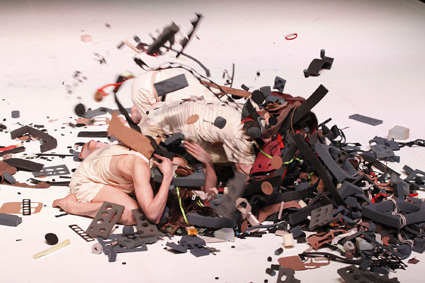
Lauren Langlois, Benjamin Hancock, Alisdair Macindoe, Keep Everything, Chunky Move
photo Jeff Busby
Lauren Langlois, Benjamin Hancock, Alisdair Macindoe, Keep Everything, Chunky Move
Over the years Antony Hamilton has been all too aware of what has accumulated on his cutting room floor. And he is not afraid. His new work with Chunky Move, Keep Everything, is a foray into this realm of choreographic scraps, and reveals what lies beyond the edge of our well-crafted stories. I spoke with him about his motivation.
Your decision to work with previously discarded fragments of choreography, was there a personal charge to this at all? Was it salvaging? Or scavenging?
Kind of both, really. But the work transitioned a lot from its gestation to its final form. And what I really became aware of was a fascination with collecting things, and a larger meta-narrative of history and documentation: the way we follow a single, written truth about who we are, all defined by the past. But that’s not reality—history is a cultural construct, built out of fragments of ideas. We’re told there is a logic to it all. But we create logic with meaningless material from the past. So I felt compelled to step outside of all this and assess the human trait of categorically going through moments and events and ‘making sense’ of it all.
Hence the impulse to linear narrative, which you try to resist. How do you feel about traditional forms of narrative and archetype, the great monolithic meanings? Is there any nostalgia there?
Not nostalgia. I do have a reverence for the situation they’ve created though, which is expressed in the ritual of going to performance. People seat themselves in the theatre as part of an audience, awaiting performers. We surround ourselves with that comfort and familiar context, but the moment the lights go down, there is uncertainty.
So what consideration do you give your audience in Keep Everything, in terms of possible discomfort and the risk of chaos?
Well, for one thing, my work is conventional in its set-up, with the division between audience and performer, so the comfort this gives is pretty hard to break.And that gives me a great deal of freedom. I try not to filter much for my audience, but give them a direct portal into my thinking. The challenge is in framing the material. I want to present things with a wash of clarity, not just show a mess of what’s in my head.
As for chaos, I use it illustratively to show how it can become part of the norm, the cultural fabric of a situation, a world or a space. I weave it in so it creates dynamics and texture in the work, and somehow it all hangs together. Somehow meaningless things can become meaningful.
You address the myth of progress in this work through the notion of evolution, charting the human story from apes to robots and back again.
In my pieces there is quite a lot of the evolutionary tale, covering a large time scale. But this isn’t something I plan—the work just keeps falling back into it…So yes, it becomes a capitulation to linear narrative, but a playful and poetic one in the way it loops back around to the simian condition. All civilisation is forgotten and we’re back to the beginning again. And it’s fun, not serious.
In the work one of your performers delivers a brief, documentary-style account of the human story through time. What is your intention there?
That happens only very briefly at the beginning, and it is intentionally lightweight, quite jokey. Really it points to the ridiculousness of the gravity of words in the time we live in. I’m very interested in that moment when humans become self-reflexive, and that becomes their folly. They gain language and critical thought, develop opinion and everything falls apart, because they have too much information and too much self-importance. That moment shows how we’re living in a myth—the social and cultural constructs we create are a mythology, but we can’t see them when we’re immersed in them. It’s quite silly, but it’s also quite beautiful, because it gives us meaning.
How about the reference to robots, technology and futuristic possibilities?
Again, I probably didn’t consciously choose that. I know it does read that way when you watch it. But what I’ve learned in making performance is that when you focus on the larger picture unfolding hopefully you can let your consciousness escape those overbearing ideas. The functional side helps with that; you don’t over-bake it because you’ve got a job to do…Keep Everything tends to jump away from logic and moves into a space that is dream-like over a longer period of time. It lets the audience see these bodies as physical entities rather than humans they’ve been watching throughout the piece.
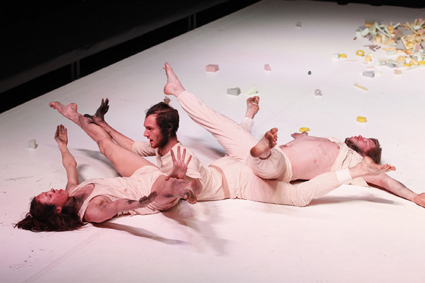
Lauren Langlois, Benjamin Hancock, Alisdair Macindoe, Keep Everything, Chunky Move
photo Jeff Busby
Lauren Langlois, Benjamin Hancock, Alisdair Macindoe, Keep Everything, Chunky Move
At the other end of the spectrum, in charting the so-called evolution of the human species, did the notion of human animality influence you much? In terms of choreography?
It’s tricky to talk about choreographic choices to illustrate things, they do, but I’m not driven by that. The choreography is instinctive and there’s no great attempt from me to make it illustrative. Rather than animality influencing it, my own direct experience as a dancer was informative. Daily assessment of your moving body as a dancer will just point you in that direction. To have and constantly observe that daily experience of your body, drawing your attention to it constantly really draws your attention away from humanism, because when you focus on the blood and bones, you’re both more and less than that.
How about the darker aspects of the work? If we reject the myth of progress, are we in danger of trading it in for the story of collective dehumanisation or self-annihilation? Did you find that kind of vision of doom feeding into your work at all? It is, after all, in the air.
No, not really. The piece is coloured by a darkness, but the visual world is open, uncluttered, sparse. There is a bit of rubble on stage but it is quite a free world in a way.
Those images of destruction can actually be quite liberating too. Annihilation can be cathartic, a release. This kind of stuff has been documented in war-time scenarios: when whole societies collapsed there was a sense of weight being lifted off their shoulders—as though ‘we can start again’ and all the old attachment to what was important is gone.
Can you talk about your choice to work in multiple mediums?
I’ve been doing this for a long time, and I’ll do anything I can do to get away from a compartmentalised view of performance elements. I want to destabilise that and draw the functions together in a meaningful way. In the end it all serves the work.
In Keep Everything, I aim to strip away the sense of the body as human and reveal it more as a component in something, perhaps an agent of another purpose rather than that of its own ego. After studying dance for a long time, I came to realise I wasn’t actually choosing to do it; I’m a servant to the work. I’m removed from this. So I became interested in revealing the body as agent of other activities. The performers build sculptures on stage. They’re part of a greater activity.
We live in an age of multifarious stimuli, multiple overlapping and unstable contexts and cultures. More than any other point in history our minds are exposed to incongruous and jarring information. Many are burdened by this. If we ‘keep everything’ in the net of our perception, is this somehow a burden?
Possibly. But really we are hardwired to filter. These days, filtering is everything and Facebook is God. To be honest, I never meet people who are responding to a thousand different things they’re exposed to. Instead, we tend to do what we’re told and follow one truth. If anything, the burden these days might be the idea of missing out, the feeling that we really ought to be doing it all.
Chunky Move, Keep Everything, director, choreographer Antony Hamilton, national tour concluding,13-16 Aug,? Sydney; 20-24 Aug, Melbourne
RealTime issue #122 Aug-Sept 2014 pg. 35
© Jessica Sabatini; for permission to reproduce apply to realtime@realtimearts.net
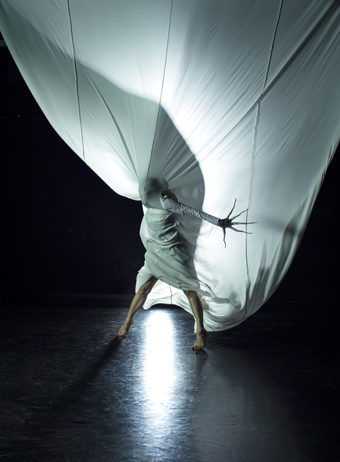
A Delicate Situation, Lina Limosani
photo Chris Herzfeld
A Delicate Situation, Lina Limosani
In A Delicate Situation, Lina Limosani attempts a considered and rigorously composed drama using dance and visual imagery. She commenced the work on an Asialink residency at Rimbun Dahna, near Kuala Lumpur in 2008. At this time Limosani became intrigued with Malaysian mythology, in particular the demonic Pontianaks, the vampire ghosts of women who die during childbirth. She turns the image of these figures into a personification of death and we witness a middle-aged woman in a changing relationship with the demon.
Performers Carol Wellman Kelly and Suhaili Micheline Ahmad Kamil are well cast as the Woman and Death respectively and intriguingly different as dancers who work sensitively and skilfully together. The visual elements are beautifully chosen and realised. We move from death, a realm of darkness, white material and struggling body, to a 1940s British home in Malaysia. Each visual field is sparse but bold with the influence of puppetry-based visual theatre evident. The bodies move in relation to the visual elements. This is just one of the satisfying aspects of the show: the rigorous composing of the dancing between all the elements—dancer and dress, dancer and dancer, dancer and objects, furniture and floor.
Each ‘scene’ is so strong and evocative that the work, even though organised as narrative, is experienced more as a set of intense images, metaphors and physical explorations. A body struggles into a suspended white dress. One dancer completes the picture proposed by the other, an ignored Malaysian servant intuiting a British woman’s desires. A dancer rearranges busts (three dimensional death masks) on a sideboard and the other dancer’s head is caught up in this activity. One dancer inhabits a room in which the furniture moves, eventually leaving the space on a carpet runner. The ghost or death figure keeps transforming, becoming at one stage a large white sheet with long, spindly arms and hands drawing in the older woman.
What was arresting and strangely moving was the shifting power dynamic expressed between the two figures in the drama: from British colonial matron blind to her Malaysian servant’s presence to tormented woman struggling to complete domestic tasks for her dead husband present as white bust (death mask) to woman tenderly held by death. The interplay of the colonial story and the drama of a woman’s relationship with death illuminated both narratives with death as foreigner, as servant, torturer and nurse—a colonial story as one of the unrecognised dependence of coloniser on colonised and then a story of the terrorising of a coloniser by the colonised and of the colonised’s great kindness to the coloniser.
The exacting choreography was intelligent and finely honed, clearly emerging from a well worked-through interplay between investigation of situation, ideas and the physical skill of the performers and choreographer. Because of the potency of the double play of narrative and imagery the piece lost a little momentum towards the end when the story of the relationship with death was privileged over the colonial narrative, but this is a very minor quibble. This was dance theatre of great originality, thought, depth of feeling and relevance.
Adelaide Festival Centre: A Delicate Situation, director, choreographer Lina Limosani, dramaturg Andrew Brackman, set, costume design Eve Lambert, sound design Hardesh Singh, lighting Neil Jensen, Space Theatre, Adelaide, 22-24 May
RealTime issue #122 Aug-Sept 2014 pg. 36
© Anne Thompson; for permission to reproduce apply to realtime@realtimearts.net
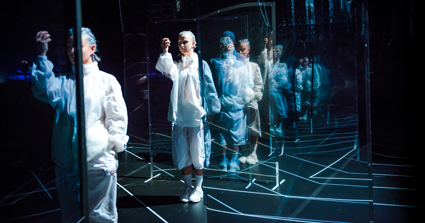
Amber McCartney, Island
photo Gregory Lorenzutti for Dancehouse
Amber McCartney, Island
James Batchelor’s Island is as remote an experience as its name suggests. Not only is it a work that reveals spatial relations and manipulates our perceptions, but it also presents a world of singular and slick, futuristic discomfort.
In this space there are no seats. One black wall is adorned with a few streaks of silver that zigzag up and away. Over erratic rasps we hear echoing trills and beeps. Between two rows of transparent screens is a dancer, with runners and shorts, anorak, powdered hair and eyebrows all in desolate white. Her movements run circuits based on tight pivots, precise and robotic, and yet with an unhurried, human calm as she moves over two rows of neon-lit hoops on the floor.
Island speaks of isolation, but illusion as well. The screens behind this figure (Bicky Lee) set up a hall-of-mirrors effect, so that looming behind the dancer is a succession of her ghost-like reflections, ever-diminishing, hovering over the hoops; and there in the muddle we also see ourselves, staring back. We are watching a world fragmented, ever-detaching. But we’re also free to roam around it. At a step, the spectres vanish and Lee is revealed as a tangible body. A few steps more and she slips again into other, subtle distortions.
The soundscape (by Morgan Hickenbotham) rises aggressively now. Lee is joined by Batchelor and Amber McCartney, in the same aseptic adventure wear. A rhythmic, high-pitched whirr grows louder and faster, asserting itself with a swerve and swing through the standing bodies, from ankles to hips, to shoulders and down again. A shrill and circular nightmare, the textures of sound and movement merge unnervingly. The effect is potent, but the shocking volume of sound makes me wonder, why the severity?
Batchelor cites among his influences the works of famous pessimists like Aldous Huxley and John Gray, who have promulgated anti-humanist views about the fickleness of the human mind. The installation of mobile screens (by architect Ella Leoncio) does make a point about this. Their mirror effects at times shatter all sense of unity; and since they are moved to new layouts between each section of Island, their changeability is the most interesting feature. Island ‘reads’ like an ironic and self-reflexive study of illusion: a demonstration of Gray’s notion—borrowed from Taoism—that illusion is inescapable, and the best we can do with our susceptible senses is be aware that they feed on such tricks.
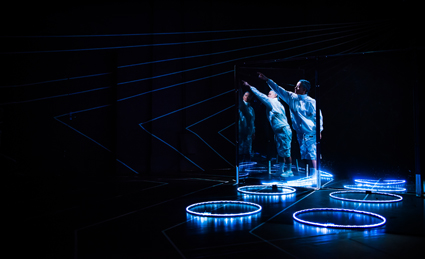
Amber McCartney, Island
photo Gregory Lorenzutti for Dancehouse
Amber McCartney, Island
What becomes of ‘humanness’ in the midst of all this? Another irony in this work is that, for all our freedom to roam and get close, the dancers remain untouchable and inscrutable. Something human is lurking there, but beneath layers of effects and a wall of harsh sound the dancers gaze at us without expression, with post-human faces we recognise and yet don’t.
In the final section, each dancer draws from their pocket a small potato. A small consolation, perhaps? Each shuttles theirs through the air, staring as it rebounds between bodies and screens, navigating the re-ordered space. If not consolation, then amusement? Or anachronism? This island is full of surprises. It conjures its world with enough force to make the mundane strange again.
Island, concept, choreographer James Batchelor, performers Amber McCartney, Bicky Lee, James Batchelor, architect Ella Leoncio, sound artist Morgan Hickenbotham; Dancehouse, Melbourne, 11-15 June
RealTime issue #122 Aug-Sept 2014 pg. 37
© Jessica Sabatini; for permission to reproduce apply to realtime@realtimearts.net
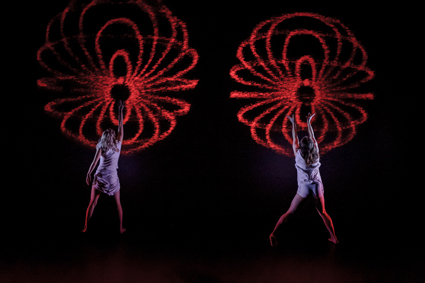
Multiverse, ADT
photo Chris Herzfeld
Multiverse, ADT
It has taken only about a century, a mere blink of the cosmic eye, for physicists to condense the principles that regulate the behaviour of all forces and forms of matter in the universe into a series of fundamental laws and theories. The pursuit of a master equation, a ‘theory of everything’ that would unite all of these hypotheses, is among the major scientific projects of the current era.
The best candidate we presently have for such a unifying theory—one that may be verified within the next few years by particle acceleration and detection experiments at the CERN laboratory—is String Theory, a theoretical framework that replaces ultramicroscopic point particles with one-dimensional strings. The American theoretical physicist Brian Greene has described these strings as “dancing filaments of energy.”
It is, no doubt, this kinematic quality [kinematics: the motion of points, bodies and systems without consideration of the causes. Eds] which attracted ADT’s Garry Stewart to the idea of exploring theoretical physics through contemporary dance. While a Thinker in Residence at Deakin University’s Motion.Lab in 2012–2013, Stewart began to develop Multiverse, a work exploring the microscopic interactions of matter and energy via the macroscopic intermingling of live bodies and 3D stereoscopy. For the completed work, which features ADT dancers Kimball Wong, Samantha Hines and Matte Roffe, audience members don 3D glasses just as they might at a new action or family movie. They are also met by a warning, displayed in large, friendly letters prior to the start of the show: “Please look away if the 3D starts to make you feel sick.”
It comes as something of a relief that Multiverse does not induce nausea in this writer and, furthermore, does little to remind him of the biliously excessive uses to which 3D technology is so often put in contemporary cinema. CG animation is, however, as central to Multiverse as it is to a Michael Bay blockbuster. We see a computer-generated image—a sort of orange-coloured galaxy in cross-section that appears to loom out of the darkness into the very centre of the space—before we see a human body. When one does emerge, the choreography, mirroring the violent agitation of subatomic particles, is convulsive, the motion of arms and legs seeming to be propelled from external rather than internal energies. A second dancer appears (it is often difficult to tell them apart) and the pair shudders around beneath the 3D object as it continues to expand and revolve. The effect is bettered by a later sequence in which Hines and Roffe seem to wrench apart a dense matrix of red points of light, the dancers suddenly godlike in their easy manipulation of what may be a star field or a cloud of electrons.
The graphic design (Kim Vincs, Daniel Skovli, Simeon Taylor, Kieren Wallace, Bobby Lin, John McCormick and Peter Divers) impatiently cycles through multiple geometric shapes and topographies, constantly playing with both our perception of depth and our sense of where the work is situating us at any given moment—embedded within the nanoscopic universe or projected into the garish mise-en-scènes of alien cityscapes and spaceports. It is not always clear which of these planes Stewart is attempting to invoke.
In a post-show Q & A, Stewart said that Multiverse’s visual language is an invented one, a reflection of his desire to eschew the typical aesthetics of TV science programs. The result is, however, not so much original as an original hybrid. Brendan Woithe’s electronic soundscape, for example, clearly channels Vangelis’ Blade Runner score and there are moments when the graphics veer uncomfortably close to IMAX documentary-style blandness or, worse, the visual banality of computer screensavers. In this schema, the dancers are occasionally swamped, their demanding floor work unable to hold our attention over the show’s most persuasive optical artifices. But they are assisted by Catherine Ziersch’s light-reflecting costumes and the use of registered video which partially integrates the dancers’ bodies with the graphics. I would like to have seen how this contest between our privileging of the live and the mediatised might have played out had Stewart elected to raise the dancers up off the floor, a decision that may have presented enhanced opportunities for the ‘interaction’ of Wong, Hines and Roffe with the 3D images.
As it is, though, Multiverse is a surprisingly fluid and cohesive experiment in extending Stewart’s familiarly technologised contemporary dance vocabulary. It never feels like a work in progress even if, as was made clear by Stewart’s Q & A responses, the company feels the 3D stereoscopy is still in need of a good deal of refinement. It may be, in fact, that this imperfectness is a virtue, conceptually consistent with our still-developing understandings of the quantum universe and the strange, vibrant choreographies of matter and energy that fill it.
–
Multiverse, Australian Dance Theatre, director, choreographer Garry Stewart, lighting designer Damien Cooper, video designer Matthew Gingold, Space Theatre, Adelaide, 9-12 July
RealTime issue #122 Aug-Sept 2014 pg. 38
© Ben Brooker; for permission to reproduce apply to realtime@realtimearts.net


































































 Underlying the collected essays of Darren Tofts’ alephbet is the audacious, anti-historical idea that the internet can be thought about through films and works of literature that preceded its invention. To play out this provocation, Tofts chooses writers whose stories are game-like, such as Italo Calvino, Gilles Deleuze, Roland Barthes and above all Jorge Luis Borges.
Underlying the collected essays of Darren Tofts’ alephbet is the audacious, anti-historical idea that the internet can be thought about through films and works of literature that preceded its invention. To play out this provocation, Tofts chooses writers whose stories are game-like, such as Italo Calvino, Gilles Deleuze, Roland Barthes and above all Jorge Luis Borges. 


















